Paul van Yperen's Blog, page 39
September 13, 2024
Mehdi El Glaoui
French-Moroccan actor, director and screenwriter Mehdi El Glaoui (1956) is the son of film star and author Cécile Aubry from her marriage to the eldest son of the Pasha of Marrakech. As a child, Mehdi was the cute star of his mother’s TV series Belle et Sébastien/Belle and Sebastian (1965) and its sequels Sébastien parmi les hommes/Belle, Sebastian and the Horses (1968) and Sébastien et la Mary-Morgane/Sebastian and the Mary Morgan (1970). The three popular series were also edited into feature films.
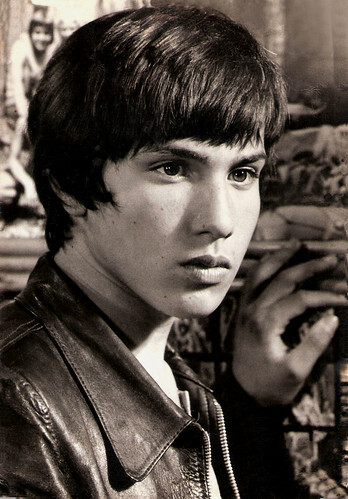
French autograph card. Mehdi El Glaoui in the TV series Le jeune Fabre/The Young Fabre (Cécile Aubry, 1973).
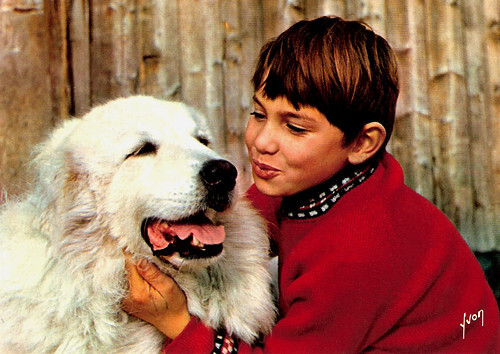
French postcard by Editions d'art Yvon, Paris, no. 6. Photo: RTF / Gaumont. Mehdi El Glaoui as Sebastien with Belle in Sébastien parmi les hommes/Belle, Sebastian and the Horses (Cécile Aubry, 1968).
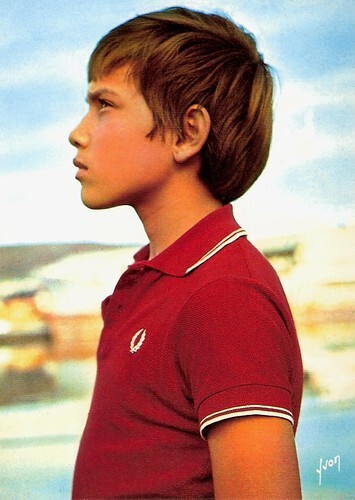
French postcard by Editions d'art Yvon, Paris. Photo: RTF, Gaumont Télévision International and Téléclip. Mehdi El Glaoui as Sebastien in the film and TV series Sebastien et la Mary-Morgane (Cécile Aubry, 1970).
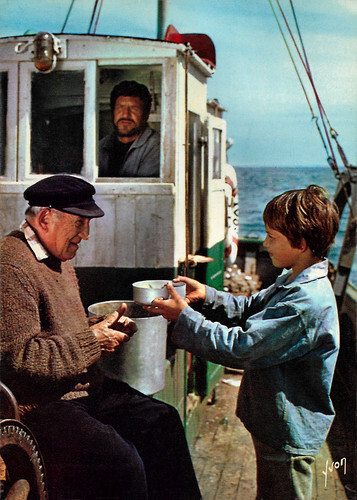
French postcard by Editions d'art Yvon, Paris, no. 40/001-11. Photo: RTF / Gaumont / Téléclip. Mehdi El Glaoui and Charles Vanel in Sebastien et le Mary Morgane/Sebastian and the Mary Morgan (Cécile Aubry, 1970).
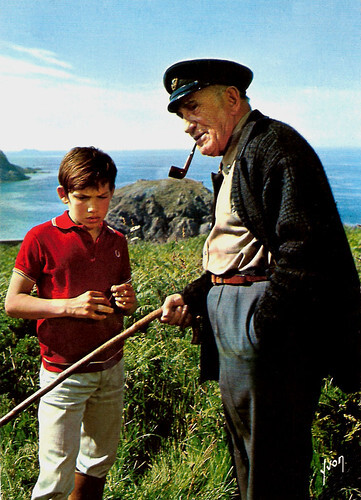
French postcard by Editions d'art Yvon, Paris, no. 40/001-12. Photo: RTF / Gaumont / Téléclip. Mehdi El Glaoui and Charles Vanel in Sebastien et le Mary Morgane/Sebastian and the Mary Morgan (Cécile Aubry, 1970). Sent by mail in 1970.
Lonely boys abandoned by their fathers
Mehdi El Mazouari El Glaoui was born in Choisy-le-Roi, France in 1956. He is the son of French author and actress Cécile Aubry and Moroccan aristocrat Si Brahim El Glaoui, caïd (local administrator) of Telouet and grandson of Thami El Glaoui, the Pasha of Marrakech. His mother and father had met during location shooting in Morocco for the Hollywood production The Black Rose (Henry Hathaway, 1951) in which Aubry co-starred with Tyrone Power and Orson Welles . In 1954, they secretly married and Mehdi was born at the Prince’s country house, the Blue Mill, some 25 miles from Paris. The name 'Mehdi' means 'guided by God' in Arabic.
At the age of 5, Mehdi made his acting début in the TV series Poly (1961–1973), produced by his mother. Poly is a pony and all other actors in the series were local amateurs, whose voices were dubbed later by professionals. Medhi’s natural acting in the series was acclaimed.
From 1965 on, he became internationally famous as Sébastien, the main character in the French TV series Belle et Sébastien/Belle and Sebastian (1965) also created (novelist, screenwriter, lyricist, narrator and co-director) by his mother. The series about a six-year-old orphan boy and his Pyrenean Mountain dog Belle was a popular success in many European countries. Flanker, the dog who played Belle, was an 18-month-old male. Directing Flanker on location was especially hard because the dog wasn't trained at all. Lots of chocolate was used to handle him on the set. One day he ran away just to drink from a mountain stream twelve miles away, and the cast and crew had to wait for his return.
Cécile Aubry was asked by the production company to write a sequel to the series. So she talked to her son Mehdi El Glaoui if he wanted to do it again. He agreed but requested her to set it during the summer, and include horses. In Sébastien parmi les hommes/Belle, Sebastian and the Horses (1968), Sebastian's father Pierre Maréchal (Claude Giraud) finds out that Sebastian is alive and invites him over to his horse ranch. Things soon get complicated when Pierre's rich fiancée finds out about Sebastian's existence. The theme song ‘L'oiseau’ (The Bird) from the second series sung by the then 8-year-old Bruno Victoire Polius, sold more than 1.6 million times.
In the third series, Sébastien et la Mary-Morgane/Sebastian and the Mary Morgan (1970), Belle has died of old age, but Sébastien falls in love with another dog. During the summer holidays, Sébastien is sent to his great-uncle Louis in Bretagne ( Charles Vanel ), an eccentric captain of a fishing vessel, named the Mary-Morgane. In contact with the uncle's servants Jonathan and Clarisse, and the daughter of the uncle's associate, Sébastien hears about the uncle's past as a resistance fighter and the loss of his wife and son. In an interview with Cécile Aubry and Mehdi El Glaoui for the DVD release of Belle et Sébastien, she said that the fact that Mehdi hardly knew his father, who she separated from soon after Mehdi's birth, inspired her to write stories for him about lonely boys abandoned by or estranged from their fathers. This is true of this series, and also of the TV series Le jeune Fabre/The Young Fabre (1973). Mehdi played a young teenager who is looking for his real father. He is expelled from his school and travels to Paris to experiment with life and love.
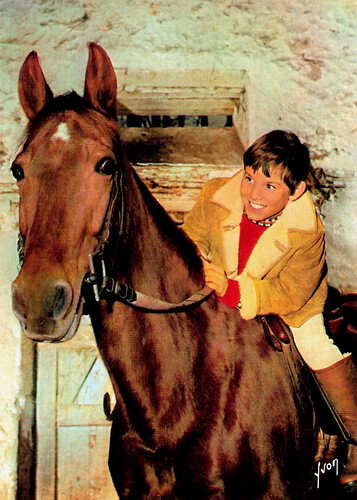
French postcard by Editions d'art Yvon, Paris, no. 1. Photo: RTF / Gaumont. Mehdi El Glaoui as Sébastien in Sébastien parmi les hommes/Belle, Sebastian and the Horses (Cécile Aubry, 1968).
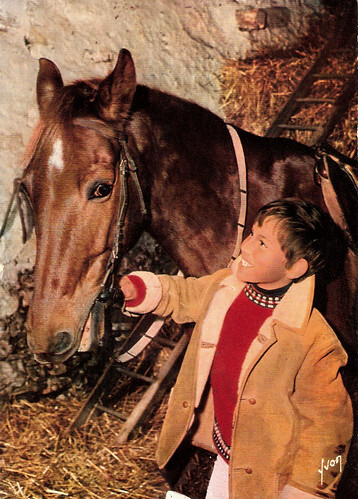
French postcard by Editions d'art Yvon, Paris, no. 2. Photo: RTF / Gaumont. Mehdi El Glaoui as Sébastien in Sébastien parmi les hommes/Belle, Sebastian and the Horses (Cécile Aubry, 1968).
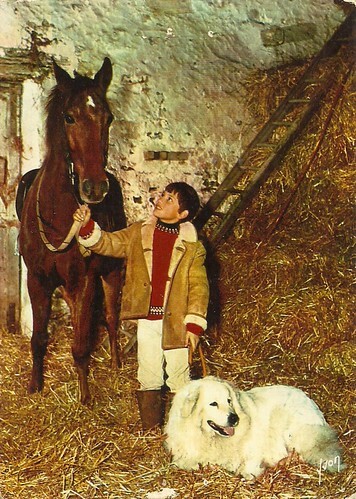
French postcard by Editions d'art Yvon, Paris, no. 7. Photo: RTF / Gaumont. Mehdi El Glaoui as Sébastien in Sébastien parmi les hommes (Cécile Aubry, 1968).
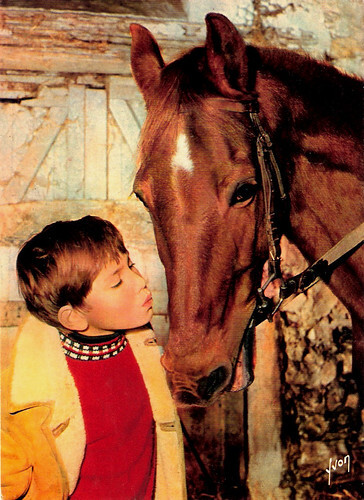
French postcard by Editions d'art Yvon, Paris, no. 81. Photo: RTF / Gaumont. Mehdi El Glaoui as Sébastien in Sébastien parmi les hommes/Belle, Sebastian and the Horses (Cécile Aubry, 1968).
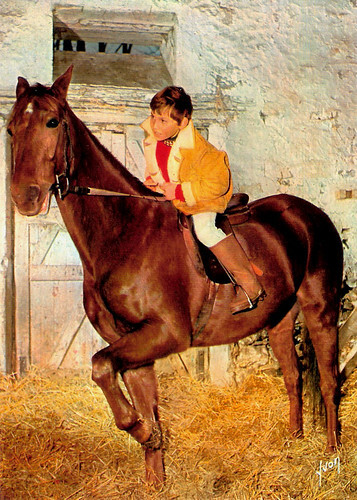
French postcard by Editions d'art Yvon, Paris, no. 8. Photo: RTF / Gaumont. Mehdi El Glaoui as Sébastien in Sébastien parmi les hommes/Belle, Sebastian and the Horses (Cécile Aubry, 1968).
César as director for the Best Short Fiction Film
In real life, the 16-year-old Mehdi El Glaoui also applied for emancipation after a childhood marked by a very present mother and a distant father. With his mother's agreement, he left for the Cantal region where he lived until the age of 35. He pursued a career as a film actor, assistant director and director of dramas, documentaries and commercials.
He appeared opposite Romy Schneider and Nino Castelnuovo in the film Un amour de pluie/Loving in the Rain (Jean-Claude Brialy, 1974) and with Jane Birkin and Patrick Dewaere in the sexy film comedy Catherine et Cie/Catherine & Co (Michel Boisrond, 1975).
During the 1980s and 1990s, he appeared in several TV series such as Kick, Raoul, la moto, les jeunes et les autres (1980) and in a film, the thriller Le cousin/The Informer (Alain Corneau, 1997) starring Patrick Timsit. He also wrote and directed the short film Première classe/First Class (Mehdi El Glaoui,1984) with Francis Huster and André Dussolier. In 1985, he won the César as director for the Best Short Fiction Film for it.
After a decade of absence, he appeared again on screen in the French TV programs 12-14 (2005) and Pour le plaisir (2006). He revealed that he lived near Dax, Les Landes, collected classic cars and ran a musical café. He directed another film, Mao est mort/Mao Is Dead (Mehdi El Glaoui, 2008). In 2013 Mehdi returned to the cinema screens in the remake Belle et Sébastien (Nicolas Vanier, 2013) starring Tchéky Karyo and Félix Bossuet as Sébastien. Mehdi played a supporting part in the film. In the same year, he also published his autobiography, ‘La Belle Histoire de Sébastien’.
Since 2011, Mehdi El Glaoui has been married to actress Virginie Stevenoot. They met on stage and opened a theatre in Biarritz in 2022. A few side notes. Bruno Victoire Polius, who sang ‘L’Oiseau’ for Sébastien parmi les hommes, shot to fame as a teenager. He was the lead singer of Les Poppys's hit single ‘Non non rien n'a changé’ (1971). Harry Trowbridge, also of Les Poppys, recorded ‘La sirène aux longs cheveux’ for the third series, Sébastien en de Mary-Morgane (1970). The TV series Belle et Sébastien had a lasting impact on an entire generation. The Scottish indie pop band Belle and Sebastian took their name from the TV series. The sleeve notes for their album ‘The Boy With The Arab Strap' (1998) state: "Although it is little to do with the eight of us playing music, that is where the name came from, and we are grateful to Madame Cecile Aubry for letting us use the name until now and we pay homage to her work."
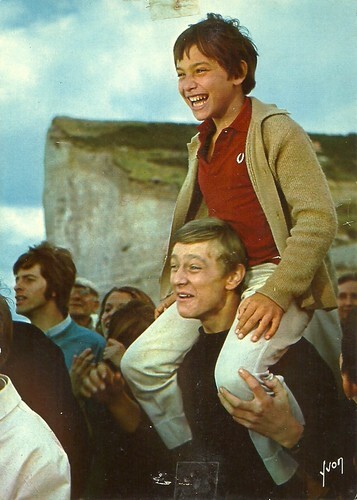
French postcard by Editions d'art Yvon, Paris, no. 40/001-14. Photo: RTF / Gaumont / Téléclip. Publicity still for the film Sebastien et la Mary-Morgane (Cécile Aubry, 1970) with Mehdi El Glaoui.
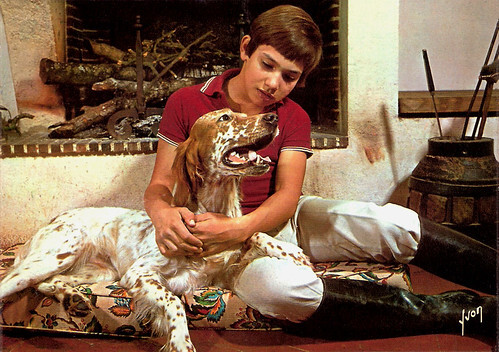
French postcard by Editions d'art Yvon, Paris, no. 40/001-16. Photo: RTF / Gaumont / Téléclip. Publicity still for the film Sebastien et la Mary-Morgane (Cécile Aubry, 1970) with Mehdi El Glaoui.
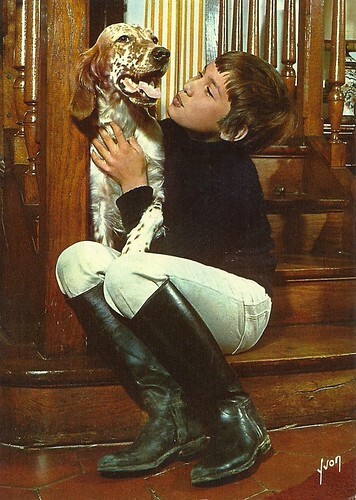
French postcard by Editions d'art Yvon, Paris, no. 40/001-18. Photo: RTF / Gaumont / Téléclip. Publicity still for the film Sebastien et la Mary-Morgane (Cécile Aubry, 1970) with Mehdi El Glaoui.
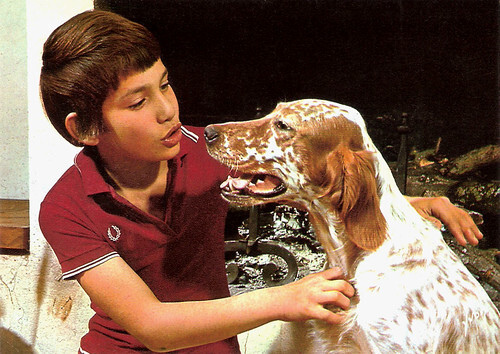
French postcard by Editions d'art Yvon, Paris, no. 40/001-19. Photo: RTF / Gaumont / Téléclip. Publicity still for the film Sebastien et la Mary-Morgane (Cécile Aubry, 1970) with Mehdi El Glaoui.
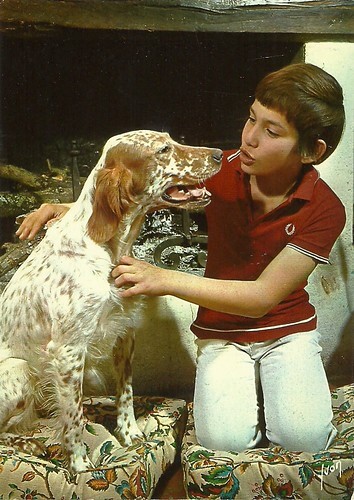
French postcard by Editions d'art Yvon, Paris, no. 40/001-20. Photo: RTF / Gaumont / Téléclip. Publicity still for the film Sebastien et la Mary-Morgane (Cécile Aubry, 1970) with Mehdi El Glaoui.
Sources: Wikipedia (Dutch, French and English), and .

French autograph card. Mehdi El Glaoui in the TV series Le jeune Fabre/The Young Fabre (Cécile Aubry, 1973).

French postcard by Editions d'art Yvon, Paris, no. 6. Photo: RTF / Gaumont. Mehdi El Glaoui as Sebastien with Belle in Sébastien parmi les hommes/Belle, Sebastian and the Horses (Cécile Aubry, 1968).

French postcard by Editions d'art Yvon, Paris. Photo: RTF, Gaumont Télévision International and Téléclip. Mehdi El Glaoui as Sebastien in the film and TV series Sebastien et la Mary-Morgane (Cécile Aubry, 1970).

French postcard by Editions d'art Yvon, Paris, no. 40/001-11. Photo: RTF / Gaumont / Téléclip. Mehdi El Glaoui and Charles Vanel in Sebastien et le Mary Morgane/Sebastian and the Mary Morgan (Cécile Aubry, 1970).

French postcard by Editions d'art Yvon, Paris, no. 40/001-12. Photo: RTF / Gaumont / Téléclip. Mehdi El Glaoui and Charles Vanel in Sebastien et le Mary Morgane/Sebastian and the Mary Morgan (Cécile Aubry, 1970). Sent by mail in 1970.
Lonely boys abandoned by their fathers
Mehdi El Mazouari El Glaoui was born in Choisy-le-Roi, France in 1956. He is the son of French author and actress Cécile Aubry and Moroccan aristocrat Si Brahim El Glaoui, caïd (local administrator) of Telouet and grandson of Thami El Glaoui, the Pasha of Marrakech. His mother and father had met during location shooting in Morocco for the Hollywood production The Black Rose (Henry Hathaway, 1951) in which Aubry co-starred with Tyrone Power and Orson Welles . In 1954, they secretly married and Mehdi was born at the Prince’s country house, the Blue Mill, some 25 miles from Paris. The name 'Mehdi' means 'guided by God' in Arabic.
At the age of 5, Mehdi made his acting début in the TV series Poly (1961–1973), produced by his mother. Poly is a pony and all other actors in the series were local amateurs, whose voices were dubbed later by professionals. Medhi’s natural acting in the series was acclaimed.
From 1965 on, he became internationally famous as Sébastien, the main character in the French TV series Belle et Sébastien/Belle and Sebastian (1965) also created (novelist, screenwriter, lyricist, narrator and co-director) by his mother. The series about a six-year-old orphan boy and his Pyrenean Mountain dog Belle was a popular success in many European countries. Flanker, the dog who played Belle, was an 18-month-old male. Directing Flanker on location was especially hard because the dog wasn't trained at all. Lots of chocolate was used to handle him on the set. One day he ran away just to drink from a mountain stream twelve miles away, and the cast and crew had to wait for his return.
Cécile Aubry was asked by the production company to write a sequel to the series. So she talked to her son Mehdi El Glaoui if he wanted to do it again. He agreed but requested her to set it during the summer, and include horses. In Sébastien parmi les hommes/Belle, Sebastian and the Horses (1968), Sebastian's father Pierre Maréchal (Claude Giraud) finds out that Sebastian is alive and invites him over to his horse ranch. Things soon get complicated when Pierre's rich fiancée finds out about Sebastian's existence. The theme song ‘L'oiseau’ (The Bird) from the second series sung by the then 8-year-old Bruno Victoire Polius, sold more than 1.6 million times.
In the third series, Sébastien et la Mary-Morgane/Sebastian and the Mary Morgan (1970), Belle has died of old age, but Sébastien falls in love with another dog. During the summer holidays, Sébastien is sent to his great-uncle Louis in Bretagne ( Charles Vanel ), an eccentric captain of a fishing vessel, named the Mary-Morgane. In contact with the uncle's servants Jonathan and Clarisse, and the daughter of the uncle's associate, Sébastien hears about the uncle's past as a resistance fighter and the loss of his wife and son. In an interview with Cécile Aubry and Mehdi El Glaoui for the DVD release of Belle et Sébastien, she said that the fact that Mehdi hardly knew his father, who she separated from soon after Mehdi's birth, inspired her to write stories for him about lonely boys abandoned by or estranged from their fathers. This is true of this series, and also of the TV series Le jeune Fabre/The Young Fabre (1973). Mehdi played a young teenager who is looking for his real father. He is expelled from his school and travels to Paris to experiment with life and love.

French postcard by Editions d'art Yvon, Paris, no. 1. Photo: RTF / Gaumont. Mehdi El Glaoui as Sébastien in Sébastien parmi les hommes/Belle, Sebastian and the Horses (Cécile Aubry, 1968).

French postcard by Editions d'art Yvon, Paris, no. 2. Photo: RTF / Gaumont. Mehdi El Glaoui as Sébastien in Sébastien parmi les hommes/Belle, Sebastian and the Horses (Cécile Aubry, 1968).

French postcard by Editions d'art Yvon, Paris, no. 7. Photo: RTF / Gaumont. Mehdi El Glaoui as Sébastien in Sébastien parmi les hommes (Cécile Aubry, 1968).

French postcard by Editions d'art Yvon, Paris, no. 81. Photo: RTF / Gaumont. Mehdi El Glaoui as Sébastien in Sébastien parmi les hommes/Belle, Sebastian and the Horses (Cécile Aubry, 1968).

French postcard by Editions d'art Yvon, Paris, no. 8. Photo: RTF / Gaumont. Mehdi El Glaoui as Sébastien in Sébastien parmi les hommes/Belle, Sebastian and the Horses (Cécile Aubry, 1968).
César as director for the Best Short Fiction Film
In real life, the 16-year-old Mehdi El Glaoui also applied for emancipation after a childhood marked by a very present mother and a distant father. With his mother's agreement, he left for the Cantal region where he lived until the age of 35. He pursued a career as a film actor, assistant director and director of dramas, documentaries and commercials.
He appeared opposite Romy Schneider and Nino Castelnuovo in the film Un amour de pluie/Loving in the Rain (Jean-Claude Brialy, 1974) and with Jane Birkin and Patrick Dewaere in the sexy film comedy Catherine et Cie/Catherine & Co (Michel Boisrond, 1975).
During the 1980s and 1990s, he appeared in several TV series such as Kick, Raoul, la moto, les jeunes et les autres (1980) and in a film, the thriller Le cousin/The Informer (Alain Corneau, 1997) starring Patrick Timsit. He also wrote and directed the short film Première classe/First Class (Mehdi El Glaoui,1984) with Francis Huster and André Dussolier. In 1985, he won the César as director for the Best Short Fiction Film for it.
After a decade of absence, he appeared again on screen in the French TV programs 12-14 (2005) and Pour le plaisir (2006). He revealed that he lived near Dax, Les Landes, collected classic cars and ran a musical café. He directed another film, Mao est mort/Mao Is Dead (Mehdi El Glaoui, 2008). In 2013 Mehdi returned to the cinema screens in the remake Belle et Sébastien (Nicolas Vanier, 2013) starring Tchéky Karyo and Félix Bossuet as Sébastien. Mehdi played a supporting part in the film. In the same year, he also published his autobiography, ‘La Belle Histoire de Sébastien’.
Since 2011, Mehdi El Glaoui has been married to actress Virginie Stevenoot. They met on stage and opened a theatre in Biarritz in 2022. A few side notes. Bruno Victoire Polius, who sang ‘L’Oiseau’ for Sébastien parmi les hommes, shot to fame as a teenager. He was the lead singer of Les Poppys's hit single ‘Non non rien n'a changé’ (1971). Harry Trowbridge, also of Les Poppys, recorded ‘La sirène aux longs cheveux’ for the third series, Sébastien en de Mary-Morgane (1970). The TV series Belle et Sébastien had a lasting impact on an entire generation. The Scottish indie pop band Belle and Sebastian took their name from the TV series. The sleeve notes for their album ‘The Boy With The Arab Strap' (1998) state: "Although it is little to do with the eight of us playing music, that is where the name came from, and we are grateful to Madame Cecile Aubry for letting us use the name until now and we pay homage to her work."

French postcard by Editions d'art Yvon, Paris, no. 40/001-14. Photo: RTF / Gaumont / Téléclip. Publicity still for the film Sebastien et la Mary-Morgane (Cécile Aubry, 1970) with Mehdi El Glaoui.

French postcard by Editions d'art Yvon, Paris, no. 40/001-16. Photo: RTF / Gaumont / Téléclip. Publicity still for the film Sebastien et la Mary-Morgane (Cécile Aubry, 1970) with Mehdi El Glaoui.

French postcard by Editions d'art Yvon, Paris, no. 40/001-18. Photo: RTF / Gaumont / Téléclip. Publicity still for the film Sebastien et la Mary-Morgane (Cécile Aubry, 1970) with Mehdi El Glaoui.

French postcard by Editions d'art Yvon, Paris, no. 40/001-19. Photo: RTF / Gaumont / Téléclip. Publicity still for the film Sebastien et la Mary-Morgane (Cécile Aubry, 1970) with Mehdi El Glaoui.

French postcard by Editions d'art Yvon, Paris, no. 40/001-20. Photo: RTF / Gaumont / Téléclip. Publicity still for the film Sebastien et la Mary-Morgane (Cécile Aubry, 1970) with Mehdi El Glaoui.
Sources: Wikipedia (Dutch, French and English), and .
Published on September 13, 2024 22:00
September 12, 2024
Alfonso Cassini
Alfonso Cassini (1858-1921) was an Italian actor of theatre and silent cinema. He appeared in more than 70 films, often as the father or partner of the silent divas of the Italian cinema.
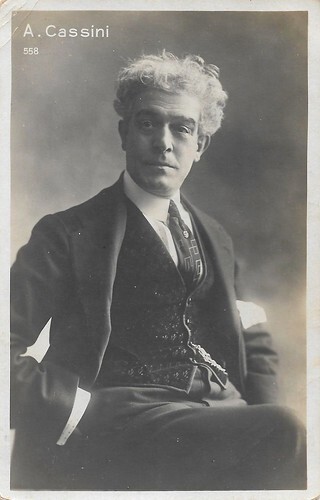
Italian postcard by Ed. G. Vettori, Bologna, no. 558.
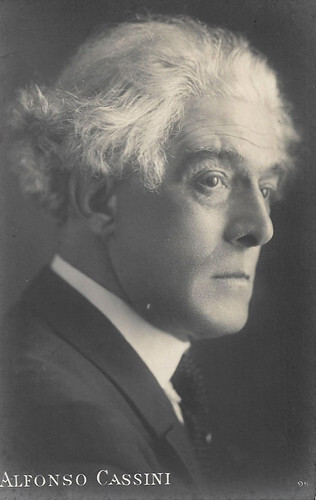
Italian postcard by Fotocelere, Torino, no. 95.
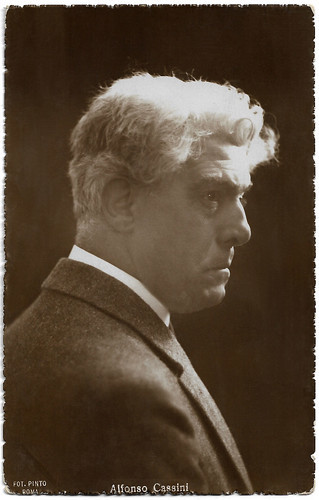
Italian postcard by Ed. Traldi, Milano. Photo: Pinto, Roma.
A bit-part or character actor
Alfonso Cassini was born in Bologna, Italy, in 1858. He began his stage career in 1876.
Over the years Cassini played as 'generico' (bit-part actor) or 'caratterista' (character actor) in the companies of Francesco Gervasi Benincasa, Ermete Novelli and Virgilio Talli.
In 1902, Cassini married actress-director Giulia Cassini-Rizzotto, daughter of a Sicilian stage playwright and actor. With Talli-Gramatica-Calabresi, the couple worked intensively until 1905 and played in numerous productions carried out by the distinguished company. From 1906 to 1912, they acted with the troupe belonging to Tina Di Lorenzo and Armando Falconi .
Between 1912 and 1913 the couple appeared in various heavily emotive melodramas at Latium Film in Rome, a company that had already hired numerous theatre actors. They then moved to Roma Film in 1913, and Etna Film in Catania, Sicily, in 1914, where Giulia became First Actress. Etna Film at the time was considered an excellent production company due to the quality of its equipment and its technical-artistic staff. In 1914 Giulia also opened an acting school in Rome, called Ars Film.
Alfonso Cassini played at Etna in such films as La danza del diavolo (Giuseppe De Liguoro, 1914) and Christus (Giuseppe De Liguoro, 1914) - not to be confused with the Cines production by Antamoro and Guazzzoni. In 1915, when Italy entered World War I, the couple returned to Rome and began to work for Tiber Film. In 1915, he also worked on stage at the Campioni-Baccani company. Until his death, Cassini worked for various film companies such as Cines, Italia Ars Film, Itala Film, and Fert.
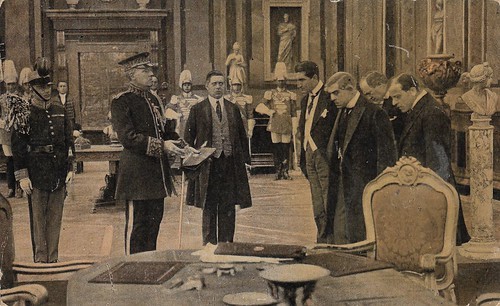
Spanish collector's card by Chocolate Pi, Barcelona, series of 6 cards, card no. 4. Photo: J. Verdaguer / Tiber Film. Ignazio Lupi (left) and Alfonso Cassini as the Lord Chancellor (the blond, elder man right) in Il potere sovrano (Baldassarre Negroni, Percy Nash, 1916). The Spanish title on the cards is Poder Soberano. The man in the middle may be Orlando (as banker Jost).
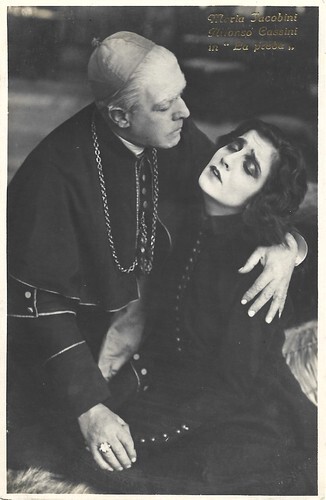
Italian postcard by G.B. Falci, Milano, no. 153. Maria Jacobini and Alfonso Cassini in La preda/The Prey (Guglielmo Zorzi, 1921).
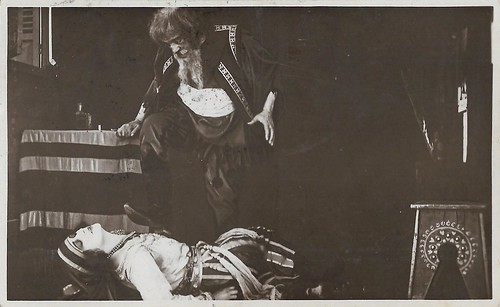
Italian postcard. Photo: Fert. Italia Almirante Manzini and Alfonso Cassini in Zingari (Mario Almirante, 1920). Caption: Jammadar shouts to Vielka: I will crush you!
Father of the divas
Italian critics praised Alfonso Cassini for his masterful and effective performances, his versatility, and his excellent make-up. In 1918 he and his wife attempted to produce and direct films themselves with their own production company Cassini-Rizzotto. Giulia thus directed her own husband in Scugní, which was partly autobiographically based. Afterwards, the couple separated.
Alfonso Cassini then often played the father of the leading characters played by the Italian divas or their male partners. The actor also worked twice with Italia Almirante, in Femmina (Augusto Genina, 1918), and La statua di carne/The Statue of Flesh (Mario Almirante, 1921). With another diva, Hesperia , he appeared in La signora delle camelie/The Lady of the Camelias (Baldassarre Negroni, 1915) and La cuccagna/The Bonanza (Baldassarre Negroni, 1917).
Other diva films in which he acted were Christus (Giulio Antamoro, 1916) with Leda Gys , La falena (Carmine Gallone, 1916) with Lyda Borelli , L'onestà del peccato (Augusto Genina, 1918) with Maria Jacobini , Zoya (Giulio Antamoro, 1920) with Diana Karenne , and La preda/The prey (Guglielmo Zorzi, 1920) with Maria Jacobini.
He also played Diomira Jacobini 's Robinson Crusoe-like father in L'isola della felicità/The Island of Happiness (Luciano Doria, 1921). Finally, he had a major part as the poor elderly newsagent 'Papa Re' in the Luigi Pirandello adaptation Lo scaldino (Augusto Genina, 1920), starring Kally Sambuccini in what she later remembered as her best film.
Alfonso Cassini died in Rome, in 1921. All in all, he acted in some 70 films. Cassini married actress-director Giulia Cassini-Rizzotto in 1902, and they had two children together.
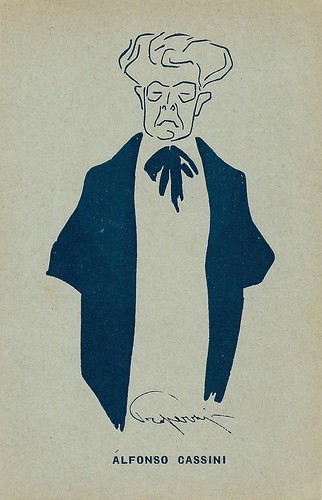
Italian postcard. Caricature by Sandro Properzi for Le Maschere, Rome.
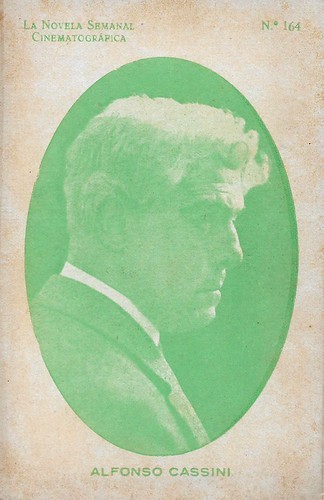
Spanish collectors card by La Novela Semanal Cinematográfica, no. 164.
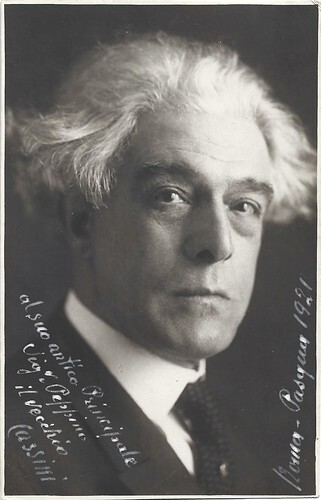
Italian postcard. Sent by mail in Rome, Easter 1921.
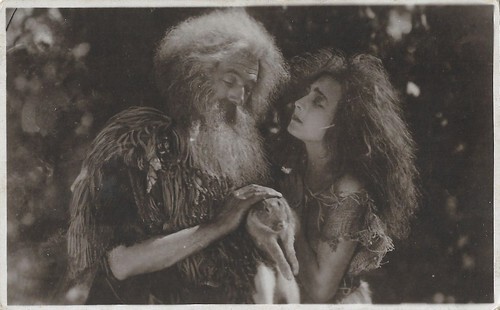
Italian postcard. Photo: Fert Film. Diomira Jacobini and Alfonso Cassini in L'isola della felicità/The Island of Happiness (Luciano Doria, 1921). Caption: The happiness of a simple life. While the back of the card erroneously identifies the man as Alberto Collo , it is Alfonso Cassini whom we see here. He plays the father of the main character, the young woman Magala, who lives on a deserted island.
Sources: Alessandro Faccioli and Marzia Maino (Women Film Pioneers Project). Wikipedia (Italian) and .

Italian postcard by Ed. G. Vettori, Bologna, no. 558.

Italian postcard by Fotocelere, Torino, no. 95.

Italian postcard by Ed. Traldi, Milano. Photo: Pinto, Roma.
A bit-part or character actor
Alfonso Cassini was born in Bologna, Italy, in 1858. He began his stage career in 1876.
Over the years Cassini played as 'generico' (bit-part actor) or 'caratterista' (character actor) in the companies of Francesco Gervasi Benincasa, Ermete Novelli and Virgilio Talli.
In 1902, Cassini married actress-director Giulia Cassini-Rizzotto, daughter of a Sicilian stage playwright and actor. With Talli-Gramatica-Calabresi, the couple worked intensively until 1905 and played in numerous productions carried out by the distinguished company. From 1906 to 1912, they acted with the troupe belonging to Tina Di Lorenzo and Armando Falconi .
Between 1912 and 1913 the couple appeared in various heavily emotive melodramas at Latium Film in Rome, a company that had already hired numerous theatre actors. They then moved to Roma Film in 1913, and Etna Film in Catania, Sicily, in 1914, where Giulia became First Actress. Etna Film at the time was considered an excellent production company due to the quality of its equipment and its technical-artistic staff. In 1914 Giulia also opened an acting school in Rome, called Ars Film.
Alfonso Cassini played at Etna in such films as La danza del diavolo (Giuseppe De Liguoro, 1914) and Christus (Giuseppe De Liguoro, 1914) - not to be confused with the Cines production by Antamoro and Guazzzoni. In 1915, when Italy entered World War I, the couple returned to Rome and began to work for Tiber Film. In 1915, he also worked on stage at the Campioni-Baccani company. Until his death, Cassini worked for various film companies such as Cines, Italia Ars Film, Itala Film, and Fert.

Spanish collector's card by Chocolate Pi, Barcelona, series of 6 cards, card no. 4. Photo: J. Verdaguer / Tiber Film. Ignazio Lupi (left) and Alfonso Cassini as the Lord Chancellor (the blond, elder man right) in Il potere sovrano (Baldassarre Negroni, Percy Nash, 1916). The Spanish title on the cards is Poder Soberano. The man in the middle may be Orlando (as banker Jost).

Italian postcard by G.B. Falci, Milano, no. 153. Maria Jacobini and Alfonso Cassini in La preda/The Prey (Guglielmo Zorzi, 1921).

Italian postcard. Photo: Fert. Italia Almirante Manzini and Alfonso Cassini in Zingari (Mario Almirante, 1920). Caption: Jammadar shouts to Vielka: I will crush you!
Father of the divas
Italian critics praised Alfonso Cassini for his masterful and effective performances, his versatility, and his excellent make-up. In 1918 he and his wife attempted to produce and direct films themselves with their own production company Cassini-Rizzotto. Giulia thus directed her own husband in Scugní, which was partly autobiographically based. Afterwards, the couple separated.
Alfonso Cassini then often played the father of the leading characters played by the Italian divas or their male partners. The actor also worked twice with Italia Almirante, in Femmina (Augusto Genina, 1918), and La statua di carne/The Statue of Flesh (Mario Almirante, 1921). With another diva, Hesperia , he appeared in La signora delle camelie/The Lady of the Camelias (Baldassarre Negroni, 1915) and La cuccagna/The Bonanza (Baldassarre Negroni, 1917).
Other diva films in which he acted were Christus (Giulio Antamoro, 1916) with Leda Gys , La falena (Carmine Gallone, 1916) with Lyda Borelli , L'onestà del peccato (Augusto Genina, 1918) with Maria Jacobini , Zoya (Giulio Antamoro, 1920) with Diana Karenne , and La preda/The prey (Guglielmo Zorzi, 1920) with Maria Jacobini.
He also played Diomira Jacobini 's Robinson Crusoe-like father in L'isola della felicità/The Island of Happiness (Luciano Doria, 1921). Finally, he had a major part as the poor elderly newsagent 'Papa Re' in the Luigi Pirandello adaptation Lo scaldino (Augusto Genina, 1920), starring Kally Sambuccini in what she later remembered as her best film.
Alfonso Cassini died in Rome, in 1921. All in all, he acted in some 70 films. Cassini married actress-director Giulia Cassini-Rizzotto in 1902, and they had two children together.

Italian postcard. Caricature by Sandro Properzi for Le Maschere, Rome.

Spanish collectors card by La Novela Semanal Cinematográfica, no. 164.

Italian postcard. Sent by mail in Rome, Easter 1921.

Italian postcard. Photo: Fert Film. Diomira Jacobini and Alfonso Cassini in L'isola della felicità/The Island of Happiness (Luciano Doria, 1921). Caption: The happiness of a simple life. While the back of the card erroneously identifies the man as Alberto Collo , it is Alfonso Cassini whom we see here. He plays the father of the main character, the young woman Magala, who lives on a deserted island.
Sources: Alessandro Faccioli and Marzia Maino (Women Film Pioneers Project). Wikipedia (Italian) and .
Published on September 12, 2024 22:00
September 11, 2024
Caterina Valente (1931-2024)
On 9 September 2024, Italian singer, dancer and actress Caterina Valente (1931) passed away at 93. In the late 1950s and early 1960s, she was the queen of the German Schlager music. Her popularity was global, and she played and sang in fifteen films. The Guinness Book of World Records recognised her as Europe's most successful female recording artist, with over 1350 albums to her credit.
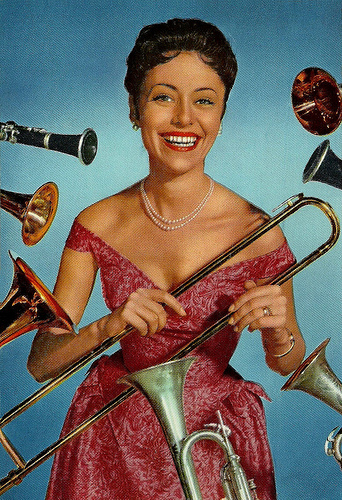
Vintage postcard.
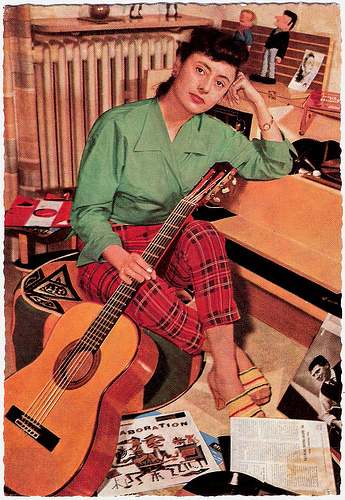
German postcard by WS-Druck, Wanne-Eickel, no. F 23. Photo: Ringpress.
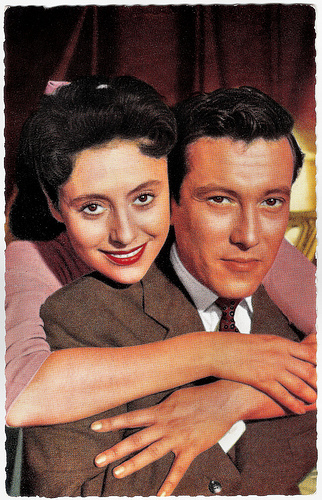
German postcard by Kolibri-Verlag, Minden/Westf., no. F 32. Photo: Ringpress / Vogelmann. Publicity still for Bonjour Kathrin (Karl Anton, 1956) with Dietmar Schönherr .
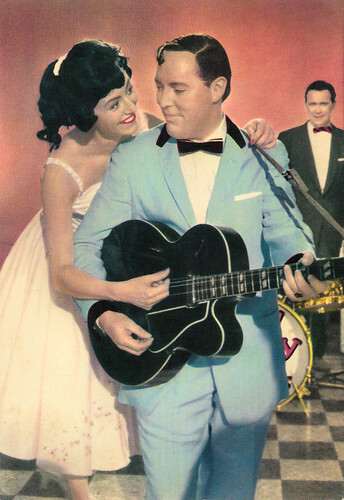
West German postcard by ISV, no. H 27. Photo: Constantin. Caterina Valente and Bill Haley and the Comets in Hier bin ich - hier bleib' ich/Here I Am, Here I Stay (Werner Jacobs, 1959).
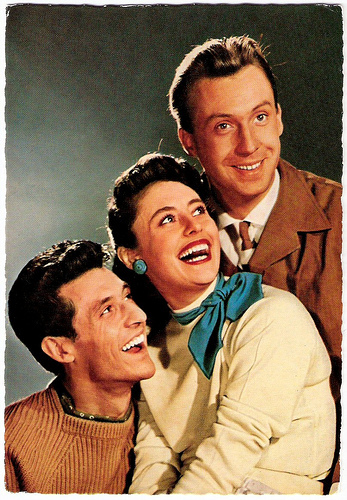
German postcard by WS-Druck, Wanne-Eickel, no. F 73. Photo: Lantin. With Peter Alexander and Silvio Francesco .
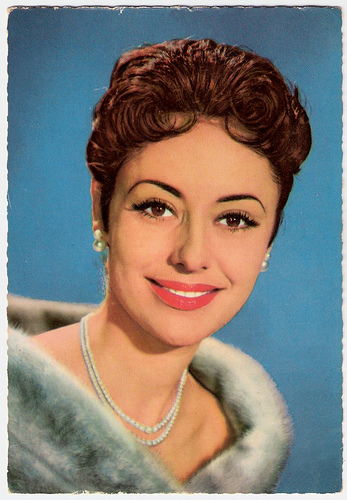
German postcard by ISV, no. L 2. Photo: Klaus Collignon.
Initial years
Caterina Valente was born in Paris, France, in 1931 in an Italian artist family. Her father Giuseppe Valente was a well-known accordion player, and her mother Maria Valente a musical clown. She had three siblings. With her older brother, the late singer and actor Silvio Francesco , she made later many records together, and he would be a frequent guest and musical director on her stage as well as TV shows.
Caterina started her career as a singer and dancer at the circus Grock. In 1952 she married juggler Erik van Aro who recognised her talent and accompanied her in her initial years of worldwide success. Their son is the singer Eric van Aro, Jr.
A year later, she made her first recordings for Polydor with the orchestra of Kurt Edelhagen. Soon afterwards she achieved great success with songs such as 'Dreh dich nicht um' (Don't Turn Around). Her hit 'Ganz Paris träumt von der Liebe' (1954), based on the Cole Porter song 'I Love Paris', sold more than 500,000 copies.
After her first musical successes, she sang and danced in the crime film Mannequins für Rio/Party Girls for Sale (Kurt Neumann, 1954) starring Johanna Matz and Raymond Burr.
The next year she performed in such German musicals as Ball im Savoy/Ball at Savoy (Paul Martin, 1955), and with Peter Alexander in Liebe, Tanz und 1000 Schlager/Love, Dance, and 1000 Songs (Paul Martin, 1955).
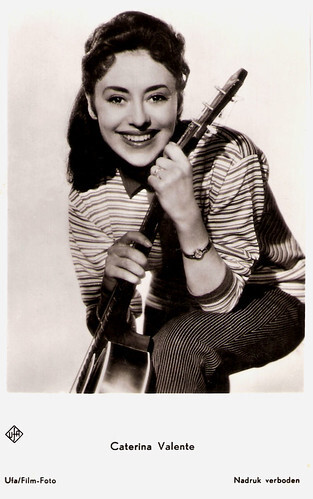
Dutch postcard by Gebr. Spanjersberg N.V., Rotterdam, no. 3928. Photo: Ufa.
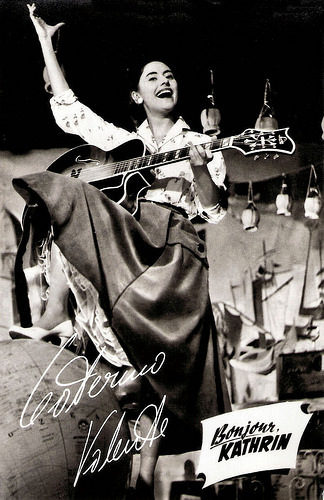
East-German postcard by VEB Progress Film-Vertrieb, no. 175, 1956. Retail price: 0,20 DM. Photo: publicity still for Bonjour, Kathrin (Karl Anton, 1956).
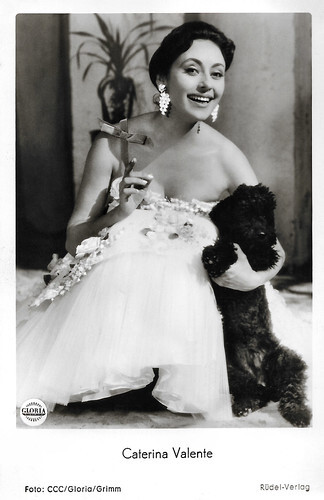
West German postcard by Rüdel-Verlag, Hamburg-Bergedorf. Photo: CCC / Gloria / Grimm. Caterina Valente in Du bist Musik/Music in Your Heart (Paul Martin, 1956).
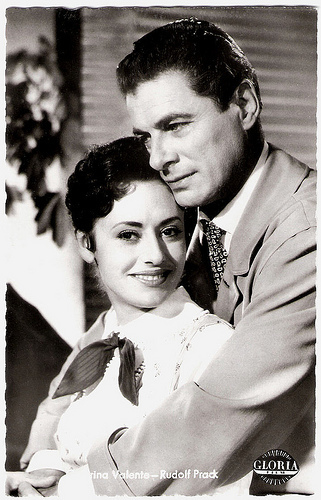
German postcard by Kolibri-Verlag G.m.b.H., Minden/Westf., no. 2952. Photo: CCC / Gloria. Publicity still for Das einfache Mädchen/The Simple Girl (Werner Jacobs, 1957) with Rudolf Prack .
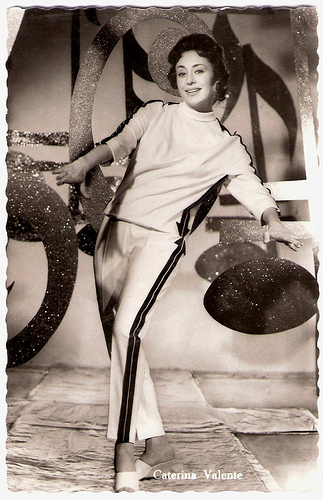
Dutch postcard by N.V. v.h. Weenenk & Snel, Baarn, no. 880. Photo: Hafbo. Publicity still for Hier bin ich, Hier bleib ich/Here I Am, Here I Stay (Werner Jacobs, 1959).
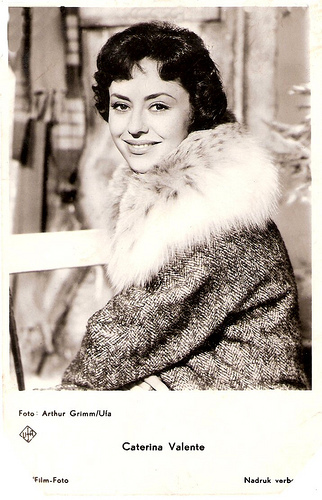
Dutch postcard by Gebr. Spanjersberg N.V., Rotterdam, no. 1159. Photo: Arthur Grimm / Universum-Film Aktiengesellschaft (Ufa), Berlin-Tempelhof.
Bossanova girl
In 1954 and 1955 Caterina Valente had international success with 'Malagueña'. The song which introduced the Bossanova in Europe was written for her by Cuban composer Ernesto Lecuona. It charted first in Europe and eventually in England and the US.
Malaguena was featured on American TV in the Colgate Comedy Hour with Gordon MacRae. 'Malaguena' was followed by 'Analucia', also written by Lecuona, which when re-released in an English version as 'The Breeze and I' became a top ten hit in both Great Britain and the US.
By this time Valente had become a truly multi-lingual artist, performing her cabaret act and issuing recordings in six languages: French, German, Italian, English, Spanish and Swedish.
In France, she made the musical Casino de Paris (André Hunebelle, 1957) with Gilbert Bécaud and Vittorio de Sica .
In Germany, she continued to make popular Schlagerfilms like Hier bin ich - hier bleib' ich/Here I Am, Here I Stay (Werner Jacobs, 1959) with Hans Holt . In the US she was nominated for a Grammy Award in 1959.
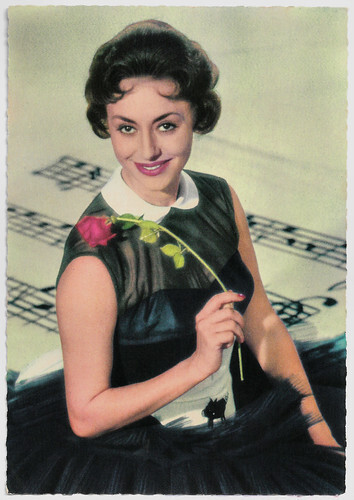
West German postcard by ISV, no. N 10. Photo: CCC / Grimm.
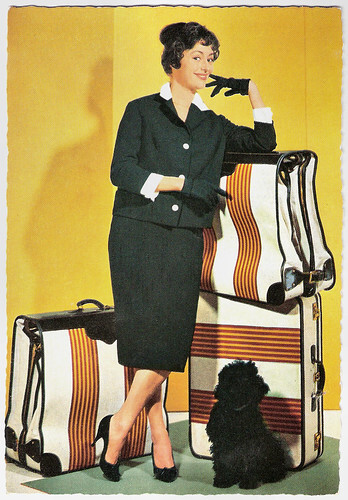
West German postcard by WS-Druck, Wanne-Eickel, no. F 151.
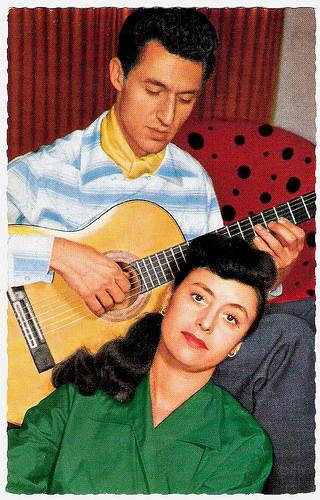
German postcard by Kolibri-Verlag G.m.b.H, Minden (Westf.), no F 31. Photo: Ringpress / Vogelmann. With Silvio Francesco .
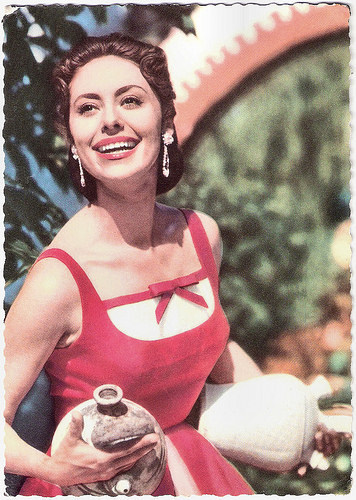
German postcard by Ufa, Berlin-Tempelhof, no. CK-55. Retail price: 30 Pfg. Photo: Arthur Grimm / Ufa.
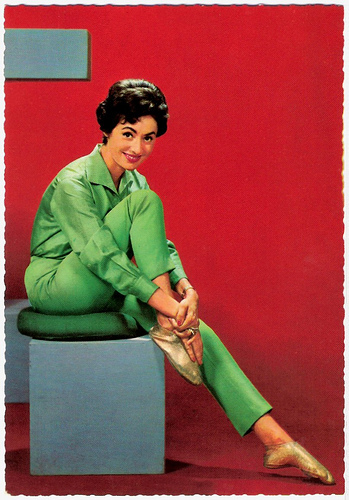
German postcard by Krüger, no. 902/22. Photo: Teldec / Farabola.
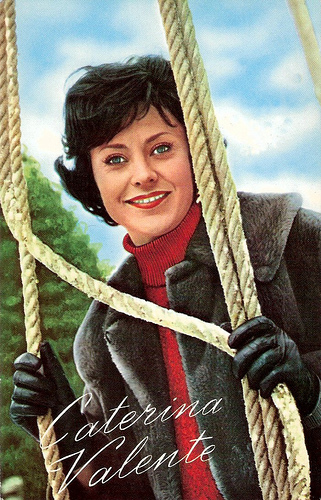
Dutch postcard, mailed in 1964.
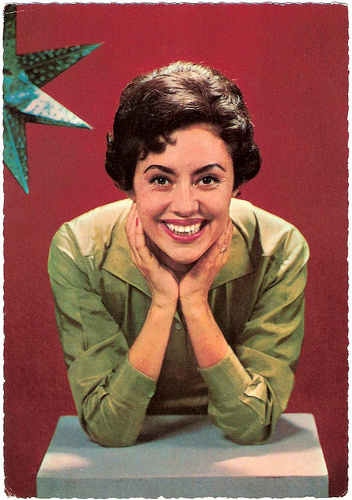
German postcard by Kruger, no. 902/19. Photo: Teldec / Farabola.
Girltalk
During the early 1960s, Caterina Valente switched alliances with Decca Records and scored several hits with them, including 'Itsy Bitsy Teenie Weenie Honolulu Strand Bikini', and 'Quando, Quando, Quando'. Valente worked with the legendary Claus Ogerman and recorded material in both Italian and English. Her version of 'La Golondrina' appeared on one of the first charity albums, 'All-Star Festival' (1963). The proceeds from that album went to aid refugees.
Between 1966 and 1972 she was a frequent guest on the Dean Martin Show and other American TV shows. From the mid-1950s to the 1980s German, Italian, Swiss and Austrian television produced more than a dozen series of Valente-Shows.
Over the years, she has recorded or performed with many international stars, including Louis Armstrong , Benny Goodman, Ella Fitzgerald, Woody Herman, the Tommy Dorsey Orchestra and Chet Baker.
In 1988 she issued 'Caterina 86', a recording made with the Count Basie Orchestra. In 1986 she enjoyed her fiftieth year on stage jubilee with the German TV show Bravo, Catrin! which attracted 17 million spectators. The Italian jazz CD 'A briglia sciolta' (1989) became Valente’s best-selling CD worldwide.
In 2001, she released her latest album of newly recorded material 'Girltalk', with harpist Catherine Michel. Among her many awards are the German Bundesverdienstkreuz (Cross of Merit, 1968), Großes Bundesverdienstkreuz (Grand Cross of Merit, 1985), and the Italian Premio Gabardi (Lifetime Achievement Award, 2004). In 1972, Valente married her musical director, British composer and jazz pianist Roy Budd. They had a son, Alexander Budd, but they divorced in 1979. Since then, Caterina Valente lived in her villa at the lake of Lugano in Switzerland. There she died in 2024 at the age of 93.
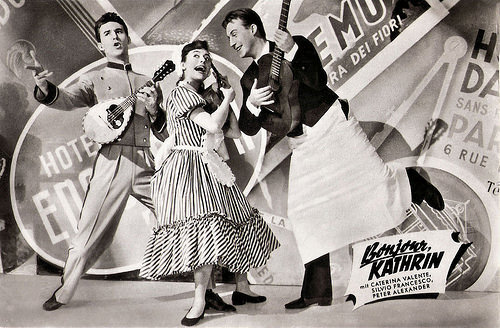
East-German postcard by VEB Progress Film-Vertrieb, no. 164, 1956. Retail price: 0,20 DM. Photo: publicity still for Bonjour, Kathrin (Karl Anton, 1956) with Silvio Francesco and Peter Alexander .
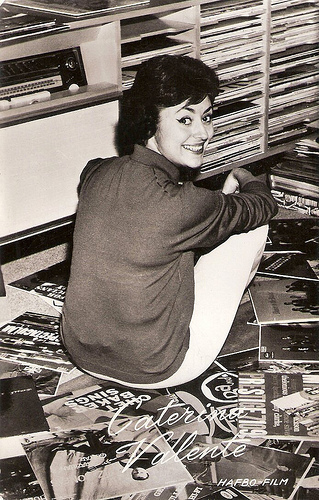
Dutch postcard by Takken, Utrecht, no. AX 4197.
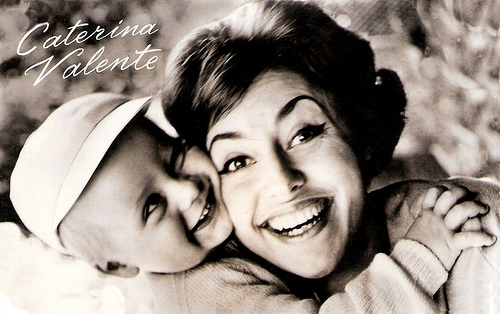
Dutch postcard by Takken, Utrecht, no. AX 4198. With her son Eric.
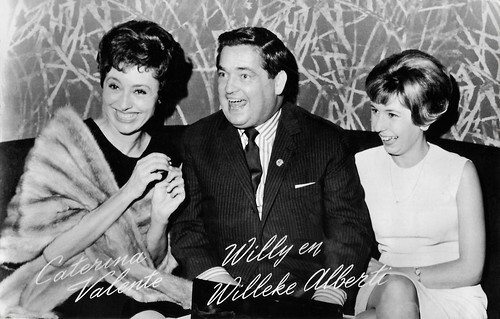
Dutch postcard by Takken, Utrecht, no. AX 5486. Caterina Valente with Willy Alberti and Willeke Alberti.
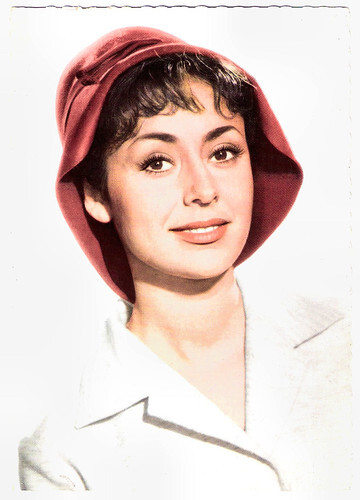
West German postcard by UFA, Berlin-Tempelhof, no. C-318. Photo: Arthur Grimm / UFA.
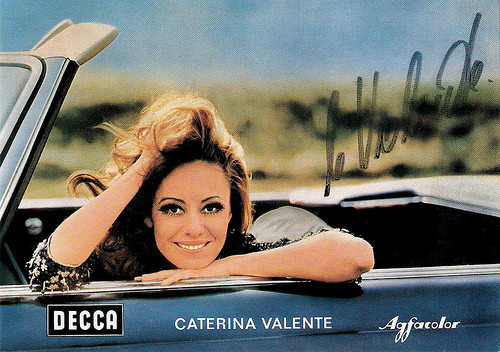
German promotion card by Decca, no. 225.
Caterina Valente sings 'Es gibt noch Märchen' (There are still fairy tales) in the schlagerfilm Das einfache Mädchen/The Ordinary Girl (Werner Jacobs, 1957). Source: Wyrubowa (YouTube).
Sources: Stacia Proefrock (AllMusic), (IMDb), CaterinaValente.com, Wikipedia, and .

Vintage postcard.

German postcard by WS-Druck, Wanne-Eickel, no. F 23. Photo: Ringpress.

German postcard by Kolibri-Verlag, Minden/Westf., no. F 32. Photo: Ringpress / Vogelmann. Publicity still for Bonjour Kathrin (Karl Anton, 1956) with Dietmar Schönherr .

West German postcard by ISV, no. H 27. Photo: Constantin. Caterina Valente and Bill Haley and the Comets in Hier bin ich - hier bleib' ich/Here I Am, Here I Stay (Werner Jacobs, 1959).

German postcard by WS-Druck, Wanne-Eickel, no. F 73. Photo: Lantin. With Peter Alexander and Silvio Francesco .

German postcard by ISV, no. L 2. Photo: Klaus Collignon.
Initial years
Caterina Valente was born in Paris, France, in 1931 in an Italian artist family. Her father Giuseppe Valente was a well-known accordion player, and her mother Maria Valente a musical clown. She had three siblings. With her older brother, the late singer and actor Silvio Francesco , she made later many records together, and he would be a frequent guest and musical director on her stage as well as TV shows.
Caterina started her career as a singer and dancer at the circus Grock. In 1952 she married juggler Erik van Aro who recognised her talent and accompanied her in her initial years of worldwide success. Their son is the singer Eric van Aro, Jr.
A year later, she made her first recordings for Polydor with the orchestra of Kurt Edelhagen. Soon afterwards she achieved great success with songs such as 'Dreh dich nicht um' (Don't Turn Around). Her hit 'Ganz Paris träumt von der Liebe' (1954), based on the Cole Porter song 'I Love Paris', sold more than 500,000 copies.
After her first musical successes, she sang and danced in the crime film Mannequins für Rio/Party Girls for Sale (Kurt Neumann, 1954) starring Johanna Matz and Raymond Burr.
The next year she performed in such German musicals as Ball im Savoy/Ball at Savoy (Paul Martin, 1955), and with Peter Alexander in Liebe, Tanz und 1000 Schlager/Love, Dance, and 1000 Songs (Paul Martin, 1955).

Dutch postcard by Gebr. Spanjersberg N.V., Rotterdam, no. 3928. Photo: Ufa.

East-German postcard by VEB Progress Film-Vertrieb, no. 175, 1956. Retail price: 0,20 DM. Photo: publicity still for Bonjour, Kathrin (Karl Anton, 1956).

West German postcard by Rüdel-Verlag, Hamburg-Bergedorf. Photo: CCC / Gloria / Grimm. Caterina Valente in Du bist Musik/Music in Your Heart (Paul Martin, 1956).

German postcard by Kolibri-Verlag G.m.b.H., Minden/Westf., no. 2952. Photo: CCC / Gloria. Publicity still for Das einfache Mädchen/The Simple Girl (Werner Jacobs, 1957) with Rudolf Prack .

Dutch postcard by N.V. v.h. Weenenk & Snel, Baarn, no. 880. Photo: Hafbo. Publicity still for Hier bin ich, Hier bleib ich/Here I Am, Here I Stay (Werner Jacobs, 1959).

Dutch postcard by Gebr. Spanjersberg N.V., Rotterdam, no. 1159. Photo: Arthur Grimm / Universum-Film Aktiengesellschaft (Ufa), Berlin-Tempelhof.
Bossanova girl
In 1954 and 1955 Caterina Valente had international success with 'Malagueña'. The song which introduced the Bossanova in Europe was written for her by Cuban composer Ernesto Lecuona. It charted first in Europe and eventually in England and the US.
Malaguena was featured on American TV in the Colgate Comedy Hour with Gordon MacRae. 'Malaguena' was followed by 'Analucia', also written by Lecuona, which when re-released in an English version as 'The Breeze and I' became a top ten hit in both Great Britain and the US.
By this time Valente had become a truly multi-lingual artist, performing her cabaret act and issuing recordings in six languages: French, German, Italian, English, Spanish and Swedish.
In France, she made the musical Casino de Paris (André Hunebelle, 1957) with Gilbert Bécaud and Vittorio de Sica .
In Germany, she continued to make popular Schlagerfilms like Hier bin ich - hier bleib' ich/Here I Am, Here I Stay (Werner Jacobs, 1959) with Hans Holt . In the US she was nominated for a Grammy Award in 1959.

West German postcard by ISV, no. N 10. Photo: CCC / Grimm.

West German postcard by WS-Druck, Wanne-Eickel, no. F 151.

German postcard by Kolibri-Verlag G.m.b.H, Minden (Westf.), no F 31. Photo: Ringpress / Vogelmann. With Silvio Francesco .

German postcard by Ufa, Berlin-Tempelhof, no. CK-55. Retail price: 30 Pfg. Photo: Arthur Grimm / Ufa.

German postcard by Krüger, no. 902/22. Photo: Teldec / Farabola.

Dutch postcard, mailed in 1964.

German postcard by Kruger, no. 902/19. Photo: Teldec / Farabola.
Girltalk
During the early 1960s, Caterina Valente switched alliances with Decca Records and scored several hits with them, including 'Itsy Bitsy Teenie Weenie Honolulu Strand Bikini', and 'Quando, Quando, Quando'. Valente worked with the legendary Claus Ogerman and recorded material in both Italian and English. Her version of 'La Golondrina' appeared on one of the first charity albums, 'All-Star Festival' (1963). The proceeds from that album went to aid refugees.
Between 1966 and 1972 she was a frequent guest on the Dean Martin Show and other American TV shows. From the mid-1950s to the 1980s German, Italian, Swiss and Austrian television produced more than a dozen series of Valente-Shows.
Over the years, she has recorded or performed with many international stars, including Louis Armstrong , Benny Goodman, Ella Fitzgerald, Woody Herman, the Tommy Dorsey Orchestra and Chet Baker.
In 1988 she issued 'Caterina 86', a recording made with the Count Basie Orchestra. In 1986 she enjoyed her fiftieth year on stage jubilee with the German TV show Bravo, Catrin! which attracted 17 million spectators. The Italian jazz CD 'A briglia sciolta' (1989) became Valente’s best-selling CD worldwide.
In 2001, she released her latest album of newly recorded material 'Girltalk', with harpist Catherine Michel. Among her many awards are the German Bundesverdienstkreuz (Cross of Merit, 1968), Großes Bundesverdienstkreuz (Grand Cross of Merit, 1985), and the Italian Premio Gabardi (Lifetime Achievement Award, 2004). In 1972, Valente married her musical director, British composer and jazz pianist Roy Budd. They had a son, Alexander Budd, but they divorced in 1979. Since then, Caterina Valente lived in her villa at the lake of Lugano in Switzerland. There she died in 2024 at the age of 93.

East-German postcard by VEB Progress Film-Vertrieb, no. 164, 1956. Retail price: 0,20 DM. Photo: publicity still for Bonjour, Kathrin (Karl Anton, 1956) with Silvio Francesco and Peter Alexander .

Dutch postcard by Takken, Utrecht, no. AX 4197.

Dutch postcard by Takken, Utrecht, no. AX 4198. With her son Eric.

Dutch postcard by Takken, Utrecht, no. AX 5486. Caterina Valente with Willy Alberti and Willeke Alberti.

West German postcard by UFA, Berlin-Tempelhof, no. C-318. Photo: Arthur Grimm / UFA.

German promotion card by Decca, no. 225.
Caterina Valente sings 'Es gibt noch Märchen' (There are still fairy tales) in the schlagerfilm Das einfache Mädchen/The Ordinary Girl (Werner Jacobs, 1957). Source: Wyrubowa (YouTube).
Sources: Stacia Proefrock (AllMusic), (IMDb), CaterinaValente.com, Wikipedia, and .
Published on September 11, 2024 22:00
September 10, 2024
Ross Verlag, Part 2: The Triumph of Silent Hollywood
EFSP brings a tribute to Ross Verlag in 16 posts. The German publishing company produced thousands of star postcards from the late 1910s till the early 1940s. In Part 1 of this tribute about the first years the focus of the Ross cards was on German actors and films. Officially, the import ban had been lifted in 1919, but German entrepreneurs still managed to hold back foreign films for quite a while. In 1923-1924 there was a reversal in dominance in the German national film market: German production dominated no longer the cinemas and Hollywood conquered the German screens. The Ross postcards reflect what happened. Here are 25 of our favourite Ross postcards of Hollywood stars, published between 1924 and 1927.
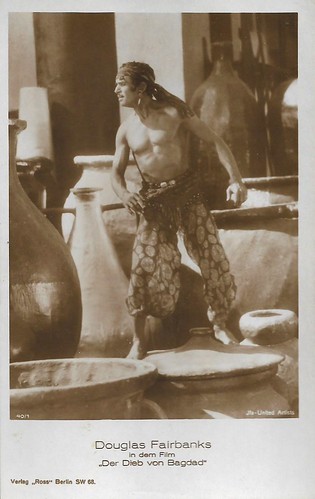
German postcard by Ross Verlag, Berlin, no. 40/1. Photo: IFA / United Artists. Douglas Fairbanks in The Thief of Bagdad (Raoul Walsh, 1924).
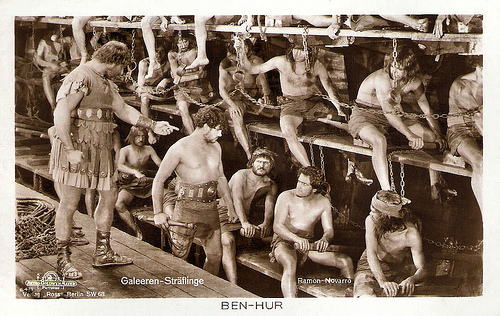
German postcard by Ross Verlag, Berlin, no. 64/1. Photo: Metro-Goldwyn-Mayer (MGM) / Fanamet. Publicity still for Ben-Hur: A Tale of the Christ (Fred Niblo, 1925) with Ramon Novarro . Caption: 'Galeeren-Sträflinge' (convicts).
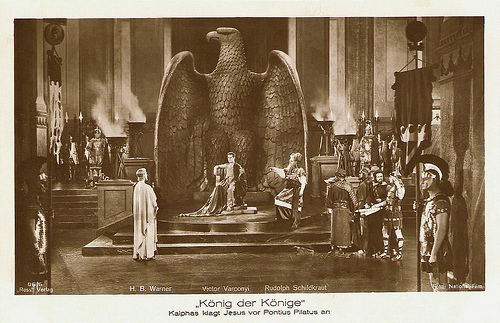
German postcard by Ross Verlag, no. 86/6. Photo: National-Film. Publicity still for King of Kings (Cecil B. De Mille, 1927) with Victor Varconi , H.B. Warner and Rudolph Schildkraut. Caption: Caiphas accuses Jesus before Pontius Pilate.
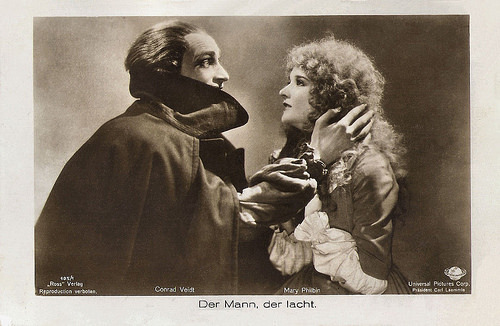
German postcard by Ross Verlag, no. 105/1. Photo: Universal Pictures Corp. Publicity still for The Man Who Laughs (Paul Leni, 1928) with Conrad Veidt and Mary Philbin .
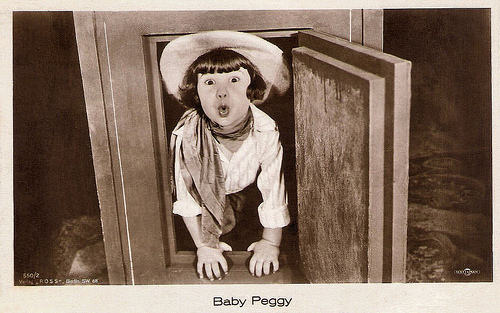
Baby Peggy . German postcard by Ross Verlag, Berlin, no. 550/2, 1919-1924. Photo: Unifilman.
Crisis in the German film industry
The Golden Twenties was a particularly vibrant period in the history of Berlin. After the Greater Berlin Act (1920), the city became the third-largest municipality in the world and experienced its heyday as a major world city. Berlin attracted a large number of foreign visitors working in the very well-developed film industry. Weimar cinema enjoyed primacy at home and growing recognition abroad
In 1917 a few large German film companies came together to unite production, distribution and presentation under one studio, the Ufa (Universum Film AG) in Berlin-Tempelhof. In 1921, the studio was privatised. Ufa was now the largest and most advanced studio in Europe. It brought together the greatest talents, including the producer Erich Pommer, and the directors Fritz Lang , Friedrich Wilhelm Murnau and Ernst Lubitsch .
The major Hollywood studios, which had offices in Berlin, sought to attract the most talented directors. In 1922, Paramount brought Ernst Lubitsch to Hollywood. He became the uncontested master of the elegant American comedy, and the famous 'Lubitsch touch'. Friedrich Wilhelm Murnau followed a few years later.
The Weimar Republic lived in the shadow of inflation until late 1923. After the stabilisation of the German currency starting in November 1924, the German film industry, in general, entered a period of crisis: foreign sales stalled due to low-profit margins, and the German market became profitable once again for American film studios. The new currency allowed importers to buy foreign films at a more reasonable cost and imports took over a larger share of the market. In 1923, 417 features were censored in Germany: including 253 German productions and 103 American. Five years later, 520 features were censored of which 221 were German and 205 American films.
Ufa's managers made severe miscalculations concerning two large-scale productions, Die Nibelungen (1924) and Metropolis (1926). This situation was made even worse as the result of the Parufamet agreement, Ufa had entered into in 1925 with the American companies Paramount Pictures and Metro-Goldwyn-Mayer. In March 1927, the company faced bankruptcy. Thomas J. Saunders in his study 'Hollywood in Berlin: American Cinema and Weimar Germany': "American tariffs and resistance to German imports, as well as the departure of leading filmmakers to the United States, threatened to reduce German cinema to an appendage of Hollywood."
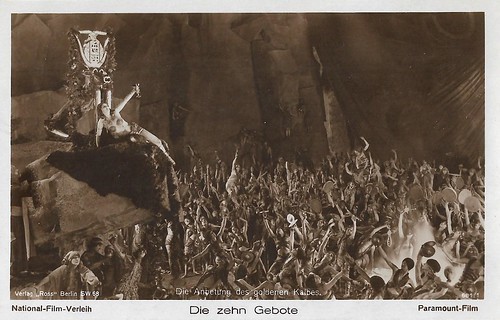
German postcard by Ross Verlag, no. 681/1. Photo: Paramount-Film / National-Verleih. Estelle Taylor is the woman who embraces the Golden Calf, in The Ten Commandments (Cecil B. DeMille, 1923). Caption: The Adoration of the Golden Calf.
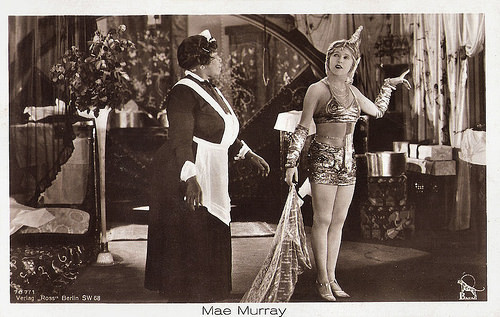
German postcard by Ross Verlag, no. 787/1. Photo: British-American-Films A.G. Balag. Photo: publicity still for Broadway Rose (Robert Z. Leonard, 1922) with Mae Murray and Pauline Dempsey.
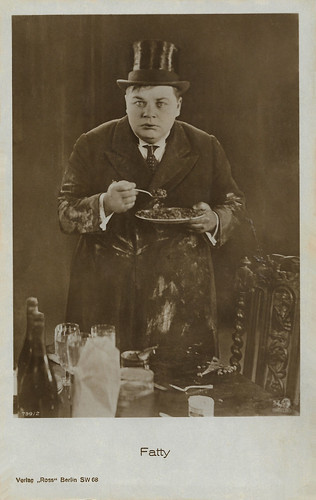
German postcard by Ross Verlag, Berlin, no. 799/2, 1925-1926. Photo: Phoebus Film. Roscoe ‘Fatty’ Arbuckle .
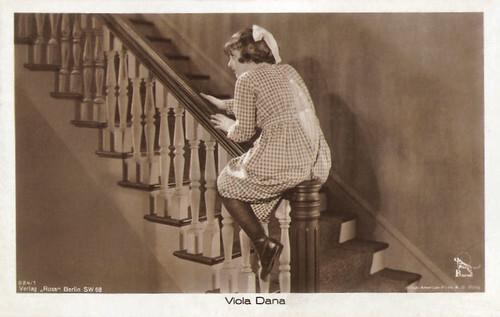
German postcard by Ross Verlag, Berlin, no. 824/1, 1925-1926. Photo: British-American Films AG (BAFAG). Viola Dana .
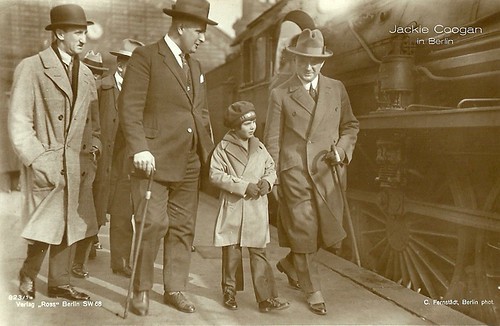
German postcard by Ross Verlag, Berlin, no. 923/1. Photo: C. Fernstädt, Berlin. Caption: Jackie Coogan in Berlin. The man at the far left is Coogan's father, John Henry 'Jack' Coogan Jr.
Hollywood comes to Berlin
The photo above was taken during Jackie Coogan European's tour in 1924. According to Wikipedia , Coogan, working with Near East Relief (NER), toured across the United States and Europe in 1924 on a "Children's Crusade" as part of his fundraising drive, which provided more than $1 million in clothing, food, and other contributions (worth more than $13 million in 2012 dollars), funds raised for Armenian genocide orphans. Coogan was honoured by officials in the United States, Greece, and Rome, where he had an audience with Pope Pius XI. Coogan may well have been the first star to use his status for a humanitarian cause. He for sure became known as the star with a conscience.
In addition, the tour promoted Coogan's film A Boy of Flanders, which, oddly enough, takes place in the Netherlands and not in Belgium (of which Flanders is a part). Coogan was also dressed up in a typical Volendammer (Dutch) folkloristic outfit. In The Netherlands, the film was therefore rebaptised 'Een Hollandsche jongen' (A Dutch Boy).
According to the newspapers, in September 1924, Jackie Coogan docked in Southampton with the SS Leviathan and then visited London, Paris, Rome, and Athens. Coogan was accompanied by his father Jack, his tutor Mrs. Kora Newell, and his manager and future stepfather, Arthur Bernstein. His mother stayed home, as she was expecting her second son. After ten days of holidays in early October in Semmering (Austria), the trip continued to Budapest, Vienna, and Berlin. Attempts to have him visit Amsterdam as well failed.
After a return to Paris, he took the ship back to the US on 4 November, as he had to work from 28 October on the film sets again. Huge crowds attended Coogan's visits, reaching its climax in October 1924 in Athens, according to his biographer Diana Serra Cary, when he handed over the bills of lading for the relief cargo in the presence of Greek and American dignitaries and some 7000 orphans in the care of Near East Relief.
Coogan was awarded with the Silver Cross of the Order of St. George. Way before TV or the internet, the media coverage of printed press, film magazines and newsreels on the tour was huge. The Ross Verlag postcards on Coogan's Berlin visit are part of this.
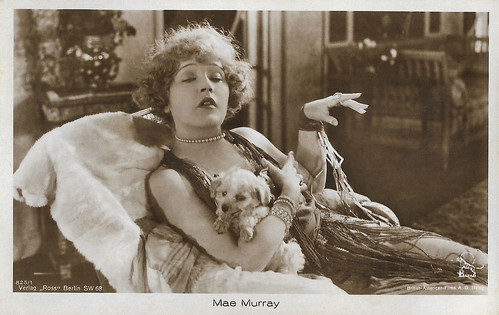
German postcard by Ross Verlag, no. 825/1, 1925-1926. Photo: British-American-Films A.G. (Bafag). Mae Murray in Peacock Alley (Robert Z. Leonard, 1922).
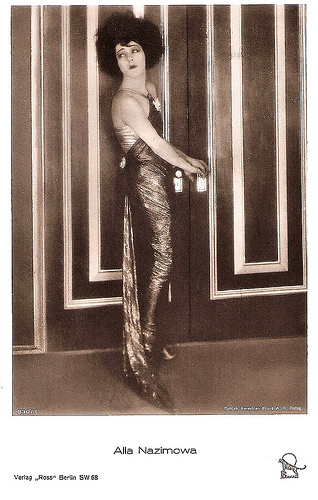
German postcard by Ross Verlag, no. 830/1, 1925-1926. Photo: British-American Films A.G. Balag. Publicity still for Camille (Ray C. Smallwood, 1921) featuring Alla Nazimova .
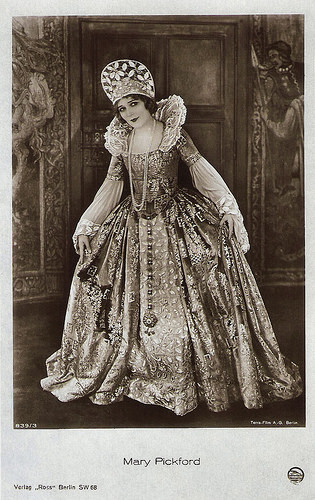
German postcard by Ross Verlag, no. 839/3. Photo: Terra Film A.G., Berlin. Publicity still for Dorothy Vernon of Haddon Hall (Marshall Neilan, 1924), featuring Mary Pickford .
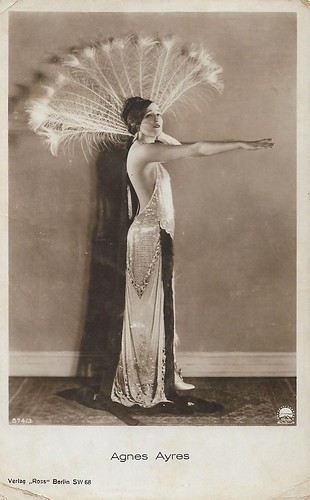
German postcard by Ross Verlag, no. 874/3, 1925-1926. Photo: Paramount. Agnes Ayres
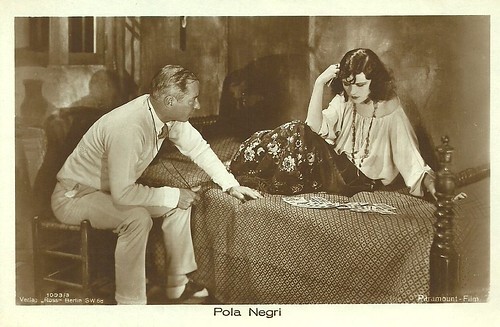
German postcard by Ross Verlag, no. 1093/3. Photo: Paramount. Herbert Brenon directs Pola Negri , who plays a gipsy fortune teller in the American silent film The Spanish Dancer (1923).
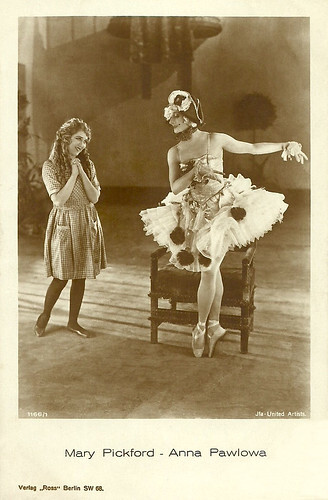
German postcard by Ross Verlag, Berlin, no. 1166/1, 1927-1928. Photo: United Artists. Mary Pickford wears her dress from Little Annie Rooney (William Beaudine, 1925). This then seems to contradict the saying on the internet that this photo with Anna Pavlova was taken on the set of The Thief of Bagdad (Raoul Walsh, 1924). The German premiere of Little Annie Rooney, released in Germany as Die kleine Annemarie, took place in May 1926, with Mary Pickford and Douglas Fairbanks present.
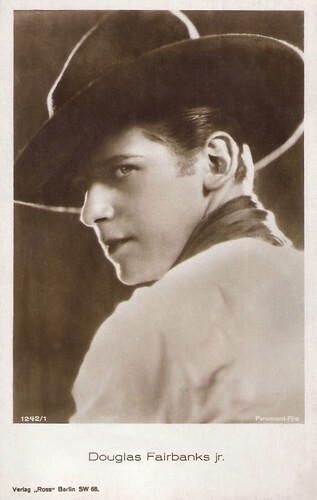
German postcard by Ross Verlag, Berlin, no. 1242/1, 1927-1928. Photo: Paramount Film. Douglas Fairbanks Jr.
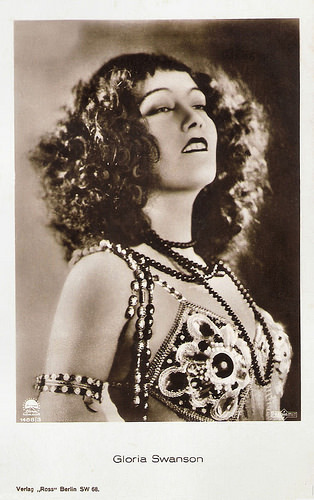
German postcard by Ross Verlag, no. 1488/3, 1927-1928. Photo: Paramount / Parafumet. Publicity still for Stage Struck (Allan Dwan, 1925), starring Gloria Swanson .
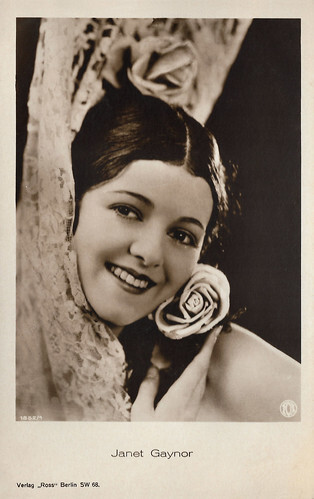
German postcard by Ross Verlag, no. 1852/1, 1927-1928. Photo: Max Munn Autrey / Fox. Janet Gaynor .
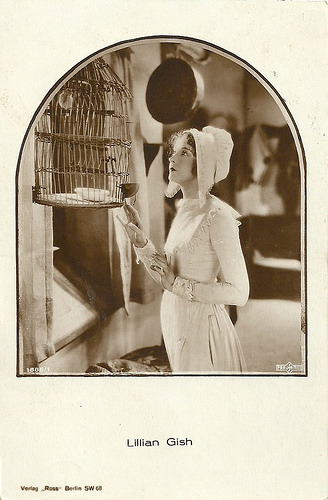
German postcard by Ross Verlag, no. 1885/1. Photo: Parufamet. Lillian Gish in The Scarlet Letter (Victor Sjöström, 1926).
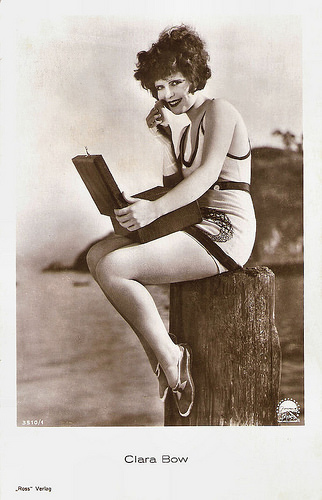
German postcard by Ross Verlag, no. 2510/1, 1928-1929. Photo: Paramount. Clara Bow .
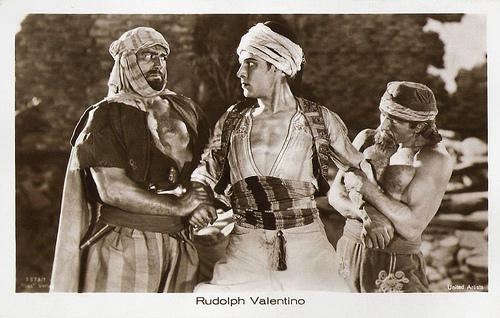
German postcard by Ross Verlag, no. 3373/1, 1928-1929. Photo: United Artists. Publicity still for The Son of the Sheik (George Fitzmaurice, 1926), starring Rudolph Valentino .
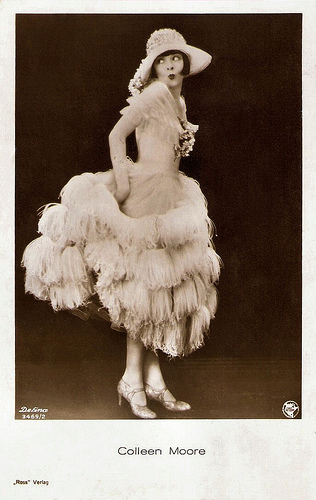
German postcard by Ross Verlag, no. 3469/2, 1928-1929. Photo: DeFina. Colleen Moore .
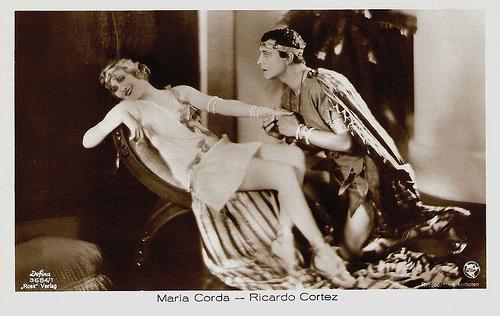
German postcard by Ross Verlag, no. 3684/1, 1928-1929. Photo: Defina. Publicity still for The Private Life of Helen of Troy (Alexander Korda, 1927) with Maria Corda and Ricardo Cortez .
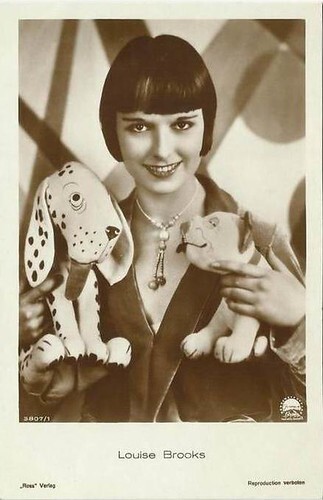
German postcard by Ross Verlag, no. 3807/1, 1928-1929. Photo: Paramount. Louise Brooks holding two stuffed toys from the period – Dismal Desmond and Bonzo . Collection: Jean Ritsema / Ross Verlag Movie Star Postcards.
Sources: Thomas J. Saunders (Hollywood in Berlin: American cinema and Weimar Germany), Kristin Thompson (Exporting Entertainment: America in the World Film Market, 1907-1934), Wikipedia and .
Thanks, Jean! The Ross Verlag Tribute will be continued next week.

German postcard by Ross Verlag, Berlin, no. 40/1. Photo: IFA / United Artists. Douglas Fairbanks in The Thief of Bagdad (Raoul Walsh, 1924).

German postcard by Ross Verlag, Berlin, no. 64/1. Photo: Metro-Goldwyn-Mayer (MGM) / Fanamet. Publicity still for Ben-Hur: A Tale of the Christ (Fred Niblo, 1925) with Ramon Novarro . Caption: 'Galeeren-Sträflinge' (convicts).

German postcard by Ross Verlag, no. 86/6. Photo: National-Film. Publicity still for King of Kings (Cecil B. De Mille, 1927) with Victor Varconi , H.B. Warner and Rudolph Schildkraut. Caption: Caiphas accuses Jesus before Pontius Pilate.

German postcard by Ross Verlag, no. 105/1. Photo: Universal Pictures Corp. Publicity still for The Man Who Laughs (Paul Leni, 1928) with Conrad Veidt and Mary Philbin .

Baby Peggy . German postcard by Ross Verlag, Berlin, no. 550/2, 1919-1924. Photo: Unifilman.
Crisis in the German film industry
The Golden Twenties was a particularly vibrant period in the history of Berlin. After the Greater Berlin Act (1920), the city became the third-largest municipality in the world and experienced its heyday as a major world city. Berlin attracted a large number of foreign visitors working in the very well-developed film industry. Weimar cinema enjoyed primacy at home and growing recognition abroad
In 1917 a few large German film companies came together to unite production, distribution and presentation under one studio, the Ufa (Universum Film AG) in Berlin-Tempelhof. In 1921, the studio was privatised. Ufa was now the largest and most advanced studio in Europe. It brought together the greatest talents, including the producer Erich Pommer, and the directors Fritz Lang , Friedrich Wilhelm Murnau and Ernst Lubitsch .
The major Hollywood studios, which had offices in Berlin, sought to attract the most talented directors. In 1922, Paramount brought Ernst Lubitsch to Hollywood. He became the uncontested master of the elegant American comedy, and the famous 'Lubitsch touch'. Friedrich Wilhelm Murnau followed a few years later.
The Weimar Republic lived in the shadow of inflation until late 1923. After the stabilisation of the German currency starting in November 1924, the German film industry, in general, entered a period of crisis: foreign sales stalled due to low-profit margins, and the German market became profitable once again for American film studios. The new currency allowed importers to buy foreign films at a more reasonable cost and imports took over a larger share of the market. In 1923, 417 features were censored in Germany: including 253 German productions and 103 American. Five years later, 520 features were censored of which 221 were German and 205 American films.
Ufa's managers made severe miscalculations concerning two large-scale productions, Die Nibelungen (1924) and Metropolis (1926). This situation was made even worse as the result of the Parufamet agreement, Ufa had entered into in 1925 with the American companies Paramount Pictures and Metro-Goldwyn-Mayer. In March 1927, the company faced bankruptcy. Thomas J. Saunders in his study 'Hollywood in Berlin: American Cinema and Weimar Germany': "American tariffs and resistance to German imports, as well as the departure of leading filmmakers to the United States, threatened to reduce German cinema to an appendage of Hollywood."

German postcard by Ross Verlag, no. 681/1. Photo: Paramount-Film / National-Verleih. Estelle Taylor is the woman who embraces the Golden Calf, in The Ten Commandments (Cecil B. DeMille, 1923). Caption: The Adoration of the Golden Calf.

German postcard by Ross Verlag, no. 787/1. Photo: British-American-Films A.G. Balag. Photo: publicity still for Broadway Rose (Robert Z. Leonard, 1922) with Mae Murray and Pauline Dempsey.

German postcard by Ross Verlag, Berlin, no. 799/2, 1925-1926. Photo: Phoebus Film. Roscoe ‘Fatty’ Arbuckle .

German postcard by Ross Verlag, Berlin, no. 824/1, 1925-1926. Photo: British-American Films AG (BAFAG). Viola Dana .

German postcard by Ross Verlag, Berlin, no. 923/1. Photo: C. Fernstädt, Berlin. Caption: Jackie Coogan in Berlin. The man at the far left is Coogan's father, John Henry 'Jack' Coogan Jr.
Hollywood comes to Berlin
The photo above was taken during Jackie Coogan European's tour in 1924. According to Wikipedia , Coogan, working with Near East Relief (NER), toured across the United States and Europe in 1924 on a "Children's Crusade" as part of his fundraising drive, which provided more than $1 million in clothing, food, and other contributions (worth more than $13 million in 2012 dollars), funds raised for Armenian genocide orphans. Coogan was honoured by officials in the United States, Greece, and Rome, where he had an audience with Pope Pius XI. Coogan may well have been the first star to use his status for a humanitarian cause. He for sure became known as the star with a conscience.
In addition, the tour promoted Coogan's film A Boy of Flanders, which, oddly enough, takes place in the Netherlands and not in Belgium (of which Flanders is a part). Coogan was also dressed up in a typical Volendammer (Dutch) folkloristic outfit. In The Netherlands, the film was therefore rebaptised 'Een Hollandsche jongen' (A Dutch Boy).
According to the newspapers, in September 1924, Jackie Coogan docked in Southampton with the SS Leviathan and then visited London, Paris, Rome, and Athens. Coogan was accompanied by his father Jack, his tutor Mrs. Kora Newell, and his manager and future stepfather, Arthur Bernstein. His mother stayed home, as she was expecting her second son. After ten days of holidays in early October in Semmering (Austria), the trip continued to Budapest, Vienna, and Berlin. Attempts to have him visit Amsterdam as well failed.
After a return to Paris, he took the ship back to the US on 4 November, as he had to work from 28 October on the film sets again. Huge crowds attended Coogan's visits, reaching its climax in October 1924 in Athens, according to his biographer Diana Serra Cary, when he handed over the bills of lading for the relief cargo in the presence of Greek and American dignitaries and some 7000 orphans in the care of Near East Relief.
Coogan was awarded with the Silver Cross of the Order of St. George. Way before TV or the internet, the media coverage of printed press, film magazines and newsreels on the tour was huge. The Ross Verlag postcards on Coogan's Berlin visit are part of this.

German postcard by Ross Verlag, no. 825/1, 1925-1926. Photo: British-American-Films A.G. (Bafag). Mae Murray in Peacock Alley (Robert Z. Leonard, 1922).

German postcard by Ross Verlag, no. 830/1, 1925-1926. Photo: British-American Films A.G. Balag. Publicity still for Camille (Ray C. Smallwood, 1921) featuring Alla Nazimova .

German postcard by Ross Verlag, no. 839/3. Photo: Terra Film A.G., Berlin. Publicity still for Dorothy Vernon of Haddon Hall (Marshall Neilan, 1924), featuring Mary Pickford .

German postcard by Ross Verlag, no. 874/3, 1925-1926. Photo: Paramount. Agnes Ayres

German postcard by Ross Verlag, no. 1093/3. Photo: Paramount. Herbert Brenon directs Pola Negri , who plays a gipsy fortune teller in the American silent film The Spanish Dancer (1923).

German postcard by Ross Verlag, Berlin, no. 1166/1, 1927-1928. Photo: United Artists. Mary Pickford wears her dress from Little Annie Rooney (William Beaudine, 1925). This then seems to contradict the saying on the internet that this photo with Anna Pavlova was taken on the set of The Thief of Bagdad (Raoul Walsh, 1924). The German premiere of Little Annie Rooney, released in Germany as Die kleine Annemarie, took place in May 1926, with Mary Pickford and Douglas Fairbanks present.

German postcard by Ross Verlag, Berlin, no. 1242/1, 1927-1928. Photo: Paramount Film. Douglas Fairbanks Jr.

German postcard by Ross Verlag, no. 1488/3, 1927-1928. Photo: Paramount / Parafumet. Publicity still for Stage Struck (Allan Dwan, 1925), starring Gloria Swanson .

German postcard by Ross Verlag, no. 1852/1, 1927-1928. Photo: Max Munn Autrey / Fox. Janet Gaynor .

German postcard by Ross Verlag, no. 1885/1. Photo: Parufamet. Lillian Gish in The Scarlet Letter (Victor Sjöström, 1926).

German postcard by Ross Verlag, no. 2510/1, 1928-1929. Photo: Paramount. Clara Bow .

German postcard by Ross Verlag, no. 3373/1, 1928-1929. Photo: United Artists. Publicity still for The Son of the Sheik (George Fitzmaurice, 1926), starring Rudolph Valentino .

German postcard by Ross Verlag, no. 3469/2, 1928-1929. Photo: DeFina. Colleen Moore .

German postcard by Ross Verlag, no. 3684/1, 1928-1929. Photo: Defina. Publicity still for The Private Life of Helen of Troy (Alexander Korda, 1927) with Maria Corda and Ricardo Cortez .

German postcard by Ross Verlag, no. 3807/1, 1928-1929. Photo: Paramount. Louise Brooks holding two stuffed toys from the period – Dismal Desmond and Bonzo . Collection: Jean Ritsema / Ross Verlag Movie Star Postcards.
Sources: Thomas J. Saunders (Hollywood in Berlin: American cinema and Weimar Germany), Kristin Thompson (Exporting Entertainment: America in the World Film Market, 1907-1934), Wikipedia and .
Thanks, Jean! The Ross Verlag Tribute will be continued next week.
Published on September 10, 2024 22:00
September 9, 2024
Rudolf Forster
Austrian film actor Rudolf Forster (1884-1968) appeared in more than 100 films between 1914 and 1968. He was known for Zur Chronik von Grieshuus/Chronicles of the Gray House (1925), Die 3 Groschen-Oper/The Threepenny Opera (1931) and Das Glas Wasser/A Glass of Water (1960).
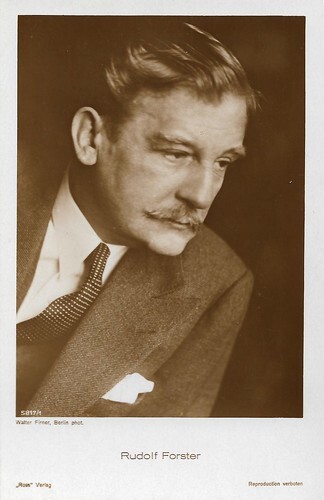
German postcard by Ross Verlag, no. 5817/1, 1930-1931. Photo: Walter Firner, Berlin.
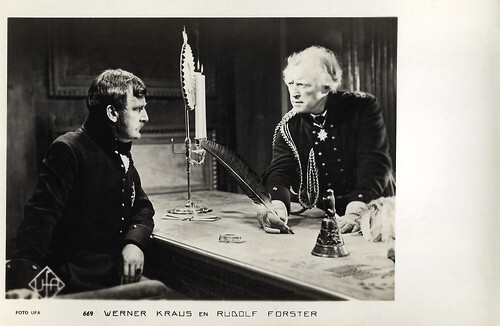
Dutch postcard, no. 663. Photo: Ufa. Werner Krauss and Rudolf Forster in Yorck (Gustav Ucicky, 1931).
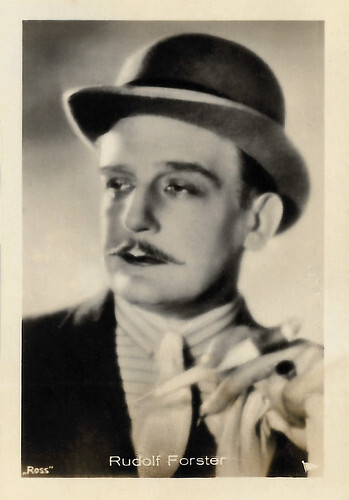
German collector card by Hänson. Photo: National / Ross Verlag. Rudolf Forster in Die Dreigroschenoper/The Threepenny Opera (G.W. Pabst, 1932).
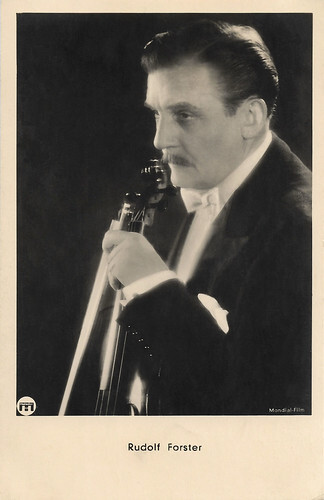
Austrian postcard by Iris Verlag, no. 6565. Photo: Matador-Film / Mondial-Film. Rudolf Forster in Der träumende Mund/Melo/Dreaming Lips (Paul Czinner, 1932).
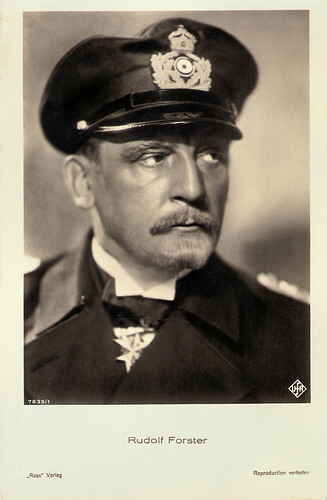
German postcard by Ross Verlag, no. 7833/1, 1932-1933. Photo: Ufa. Rudolf Forster in Morgenrot/Dawn (Gustav Ucicky, 1933).
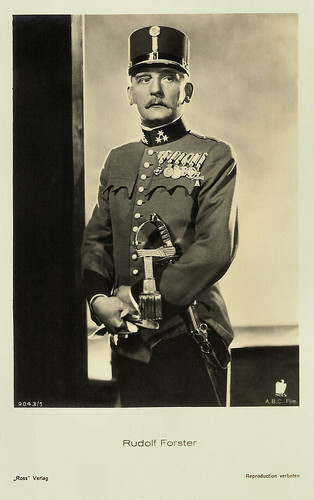
German postcard by Ross Verlag, no. 9043/1, 1935-1936. Photo: N.D.L.S. / A.B.C. Film. Rudolf Forster in Hohe Schule/The Secret of Cavelli (Erich Engel, 1934).
Homesick after three years in the U.S.
Rudolf Heribert Anton Forster was born in Gröbming, Austria-Hungary, in 1884. Forster studied acting at the Vienna Conservatory. He was the son of tax official Dr Anton Forster and his wife Josefine, née Bartscht. Rudolf trained as an actor at the Vienna Conservatory after attending a village school and grammar school.
In 1903, he made his stage debut in Graz. From 1903 to 1904 he played at the travelling theatre Vereinigte Theater Graz and then at theatres in Linz, Berlin and Ohligs. From 1907 to 1909 he worked at the Theater in der Josefstadt in Vienna, from 1909 to 1910 at the Berlin Theatre, then again in Vienna, including at the Volksbühne from 1913 to 1915. He fought in the First World War from 1915 to 1918. From 1920 to 1932, he was a member of the Berlin State Theatre under the artistic director Leopold Jessner.
From 1919, Forster appeared in the cinema, initially in heroic or elegant romantic roles in silent films. Forster was often assigned by director Friedrich Zelnik , who knew how to integrate the tall and slim shape of the actor into his films such as Die Marionetten der Fürstin/Marionettes of the Princess (Friedrich Zelnik, 1924). He played the ambitious Junker Detlev in one of Ufa's biggest projects, the Theodor Storm adaptation Zur Chronik von Grieshuus/Chronicles of the Gray House (Arthur von Gerlach, 1925).
He also starred opposite Werner Krauss and Jenny Jugo as the quirky poet Scarron in the comedy Die Hose/The Trousers (Hans Behrendt, 1927), the film version of Carl Sternheim's play. He also was the leader of a right-wing extremist secret society in Richard Oswald 's thriller Feme/Assassination (1927). Forster's first sound film was Georg Wilhelm Pabst's film Die 3 Groschen-Oper/The Threepenny Opera (G.W. Pabst, 1931) in which he starred as Mackie Messer, the king of the thieves and an irresistible pimp. In the Prussian film Yorck (Gustav Ucicky, 1931), he was King Friedrich Wilhelm III and in the war drama Morgenrot/Dawn (Gustav Ucicky, 1933), he starred as a submarine commander.
After 1933, Forster worked increasingly in Austria again. His film appearances during the turmoil of Nazi Germany were rare. In Hohe Schule/The Secret of Cavelli (Erich Engel, 1934), he played a count and trick rider, and in ... nur ein Komödiant/Only a Comedian (Erich Engel, 1935) an actor who ‘doubles’ a duke. In 1937, he fled the Nazis and emigrated to the U.S. He performed on Broadway and lived with his wife, actress Eleonora von Mendelssohn in Manhattan for a time. In Hollywood, he played in the film Island of Lost Men (Kurt Neumann, 1939) starring Anna May Wong . After three years in the U.S., he became homesick. The couple divorced and Forster returned to Germany in 1940 to resume his career there. Von Mendelsohn remained in Manhattan until she died in 1951.
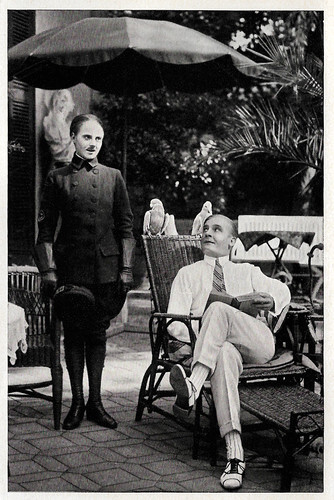
German collectors card by Ross Verlag in the series Vom Werden Deutscher Filmkunst - Der Stumme Film, no. 176, Group 43. Photo: Ossi Oswalda-Film. Caption: Ossi Oswalda as chauffeur and Rudolf Forster in Amor am Steuer (Victor Janson, 1921).
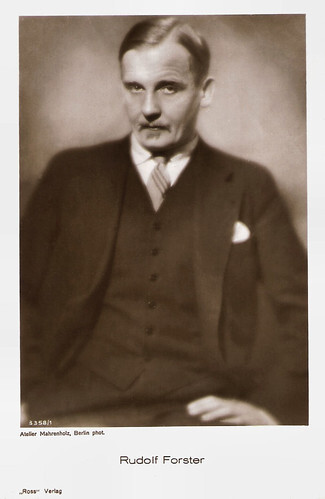
German postcard by Film-Foto-Verlag, no. 3358/1, 1928-1929. Photo: Mahrenholz, Berlin.
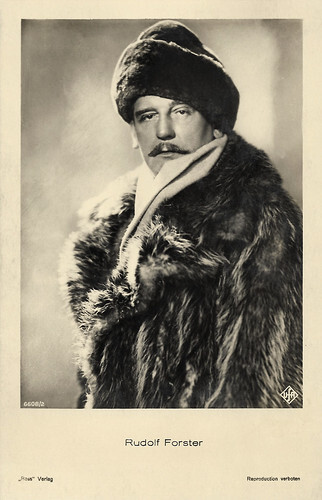
German postcard by Ross Verlag, no. 6608/2, 1931-1932. Photo: Ufa. Rudolf Forster in Yorck (Gustav Ucicky, 1931).
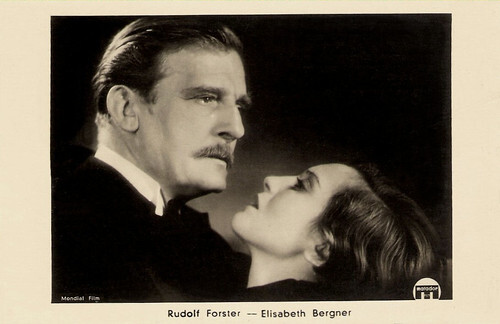
Austrian postcard by Iris-Verlag, no. 6508, distributed in the Netherlands by Jacon Stuvé's echte Nougat. Photo: Mondial Film / Matador Film. Rudolf Forster and Elisabeth Bergner in Der träumende Mund/Dreaming Lips (Paul Czinner, 1932).
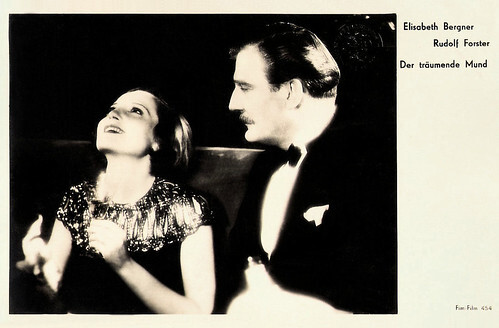
Dutch postcard by Fim Film, no. 454. Elisabeth Bergner and Rudolph Forster in Der träumende Mund/Dreaming Lips (Paul Czinner, 1932).
Grand seigneur character roles
Back in Austria, Rudolf Forster starred in the anti-Semitic film Wien 1910/Vienna 1910 (E. W. Emo, 1943) as the anti-Semitic Viennese mayor Karl Lueger. On stage, he played at the Deutsches Theater Berlin and Vienna. In 1944, Forster was on the list of those pardoned by the Reich Ministry for Popular Enlightenment and Propaganda.
After the war, he initially devoted himself to the theatre in Vienna and in both German states. In 1948-1949, he toured Switzerland and in 1963, he appeared at the Salzburg Festival in Faust II. In post-war German films, he specialised in gentlemanly or aristocratic character roles. He could be seen opposite Käthe Dorsch and Hildegard Knef in Erich Engel’s romantic comedy Fahrt ins Glück/Journey Into Happiness which was filmed in 1944 but not released until 1948.
In the historical spy drama Spionage/Espionage (Franz Antel, 1955), he played a field marshal and chief of staff of the Austro-Hungarian army alongside Ewald Balser as Colonel Redl. It was based on the real story of Alfred Redl, an officer serving with Austrian Military Intelligence who was also secretly spying for the hostile Russian Empire before the First World War.
Forster appeared opposite Gustav Gründgens and Liselotte Pulver in the historical comedy Das Glas Wasser/A Glass of Water (Helmut Käutner, 1960). In the crime comedy Er kanns nicht lassen/He Can't Stop Doing It (Axel von Ambesser, 1962), he played the superior bishop of Father Brown ( Heinz Rühmann ). It was loosely based on the Father Brown stories by G. K. Chesterton. The film follows in the post-war tradition of German Krimi films, similar to the series of Edgar Wallace adaptations popular at the time.
Forster also appeared in Krimis such as Im Stahlnetz des Dr. Mabuse/The Return of Doctor Mabuse (Harald Reinl, 1961) starring Gert Fröbe, Der Henker von London/The Executioner of London based on Bryan Edgar Wallace and another Edgar Wallace adaptation, Die Gruft mit dem Rätselschloß/The Curse of the Hidden Vault (Franz Josef Gottlieb, 1964) starring Harald Leipnitz. In his later films, Forster mostly embodied the typical grand seigneur. His autobiography ‘Das Spiel, mein Leben’ was published by Propyläen Verlag in 1967. Rudolf Forster was married twice. In 1938, he married the actress Eleonora von Mendelssohn in California. They divorced in 1940. From 1944, his second marriage was to Wilhelmine Karoline Klara Schachschneider, who also administered his estate. Rudolf Forster died in Bad Aussee, Austria, five days before his 84th birthday in 1968. His grave is in the Bad Aussee cemetery.
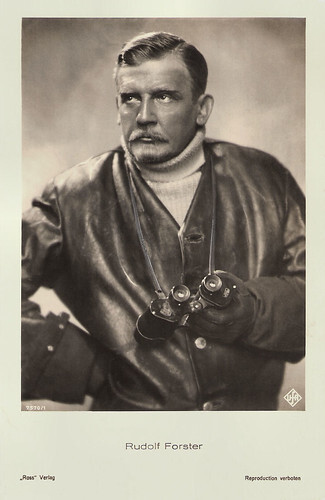
German postcard by Ross Verlag, no. 7570/1, 1932-1933. Photo: Ufa. Rudolf Forster in Morgenrot/Dawn (Vernon Sewell, Gustav Ucicky, 1933). Released three days after Adolf Hitler became Chancellor, Morgenrot was the first film to have its screening in Nazi Germany. It became a symbol of the new times touted by the Nazi regime.
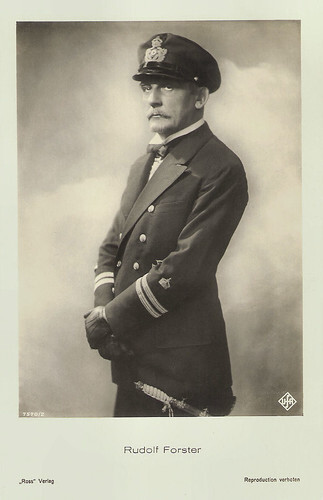
German postcard by Ross Verlag, no. 7570/2, 1932-1933. Photo: Ufa. Rudolf Forster in Morgenrot/Dawn (Vernon Sewell, Gustav Ucicky, 1933).
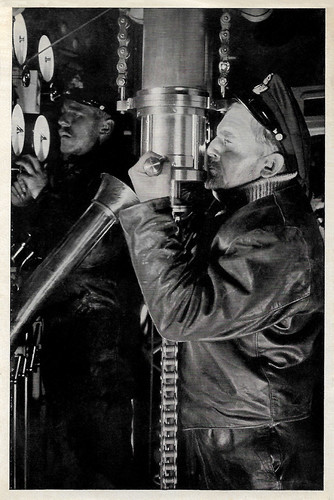
German collectors card in the series 'Vom Werden deutscher Filmkunst - Der Tonfilm', album no. 11, image no. 123. Photo: Ufa / Ross Verlag. Rudolf Forster in Morgenrot/Dawn (Vernon Sewell, Gustav Ucicky, 1933).
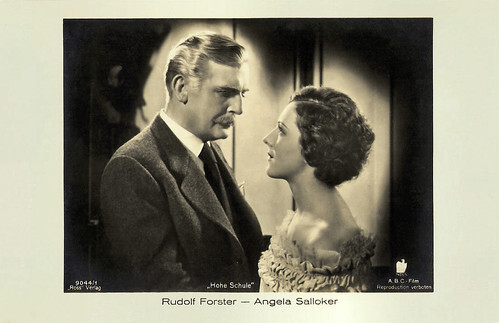
German postcard by Ross Verlag, no. 9044/1, 1935-1936. Photo: A.B.C.-Film / Neue Deutsch Lichtspiel-Syndikat Verleih (N.D.L.S.). Rudolf Forster and Angela Salloker in Hohe Schule/The Secret of Cavelli (Erich Engel, 1934).
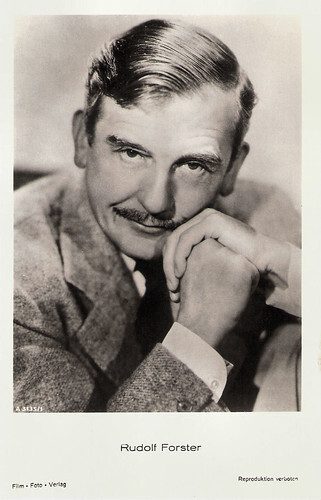
German postcard by Film-Foto-Verlag, no. A 3135/1, 1941-1944.
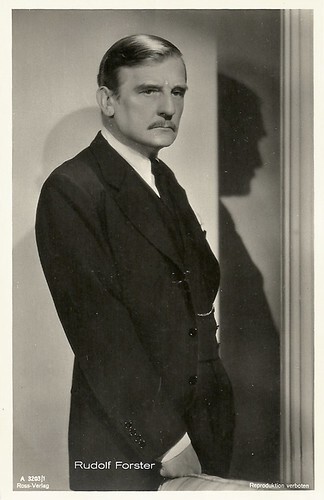
German postcard by Ross Verlag, no. A 3203/1, 1941-1942.
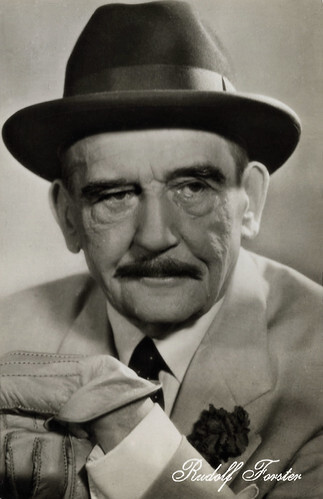
East German postcard by VEB Progress Filmvertrieb Starfoto, no. 34/280. Photo: DEFA / Kilian. Rudolf Forster in the Swedish-German feature Spielbank-Affäre/Casino Affair (Arthur Pohl, 1957).
Sources: Wikipedia (German and English), and .

German postcard by Ross Verlag, no. 5817/1, 1930-1931. Photo: Walter Firner, Berlin.

Dutch postcard, no. 663. Photo: Ufa. Werner Krauss and Rudolf Forster in Yorck (Gustav Ucicky, 1931).

German collector card by Hänson. Photo: National / Ross Verlag. Rudolf Forster in Die Dreigroschenoper/The Threepenny Opera (G.W. Pabst, 1932).

Austrian postcard by Iris Verlag, no. 6565. Photo: Matador-Film / Mondial-Film. Rudolf Forster in Der träumende Mund/Melo/Dreaming Lips (Paul Czinner, 1932).

German postcard by Ross Verlag, no. 7833/1, 1932-1933. Photo: Ufa. Rudolf Forster in Morgenrot/Dawn (Gustav Ucicky, 1933).

German postcard by Ross Verlag, no. 9043/1, 1935-1936. Photo: N.D.L.S. / A.B.C. Film. Rudolf Forster in Hohe Schule/The Secret of Cavelli (Erich Engel, 1934).
Homesick after three years in the U.S.
Rudolf Heribert Anton Forster was born in Gröbming, Austria-Hungary, in 1884. Forster studied acting at the Vienna Conservatory. He was the son of tax official Dr Anton Forster and his wife Josefine, née Bartscht. Rudolf trained as an actor at the Vienna Conservatory after attending a village school and grammar school.
In 1903, he made his stage debut in Graz. From 1903 to 1904 he played at the travelling theatre Vereinigte Theater Graz and then at theatres in Linz, Berlin and Ohligs. From 1907 to 1909 he worked at the Theater in der Josefstadt in Vienna, from 1909 to 1910 at the Berlin Theatre, then again in Vienna, including at the Volksbühne from 1913 to 1915. He fought in the First World War from 1915 to 1918. From 1920 to 1932, he was a member of the Berlin State Theatre under the artistic director Leopold Jessner.
From 1919, Forster appeared in the cinema, initially in heroic or elegant romantic roles in silent films. Forster was often assigned by director Friedrich Zelnik , who knew how to integrate the tall and slim shape of the actor into his films such as Die Marionetten der Fürstin/Marionettes of the Princess (Friedrich Zelnik, 1924). He played the ambitious Junker Detlev in one of Ufa's biggest projects, the Theodor Storm adaptation Zur Chronik von Grieshuus/Chronicles of the Gray House (Arthur von Gerlach, 1925).
He also starred opposite Werner Krauss and Jenny Jugo as the quirky poet Scarron in the comedy Die Hose/The Trousers (Hans Behrendt, 1927), the film version of Carl Sternheim's play. He also was the leader of a right-wing extremist secret society in Richard Oswald 's thriller Feme/Assassination (1927). Forster's first sound film was Georg Wilhelm Pabst's film Die 3 Groschen-Oper/The Threepenny Opera (G.W. Pabst, 1931) in which he starred as Mackie Messer, the king of the thieves and an irresistible pimp. In the Prussian film Yorck (Gustav Ucicky, 1931), he was King Friedrich Wilhelm III and in the war drama Morgenrot/Dawn (Gustav Ucicky, 1933), he starred as a submarine commander.
After 1933, Forster worked increasingly in Austria again. His film appearances during the turmoil of Nazi Germany were rare. In Hohe Schule/The Secret of Cavelli (Erich Engel, 1934), he played a count and trick rider, and in ... nur ein Komödiant/Only a Comedian (Erich Engel, 1935) an actor who ‘doubles’ a duke. In 1937, he fled the Nazis and emigrated to the U.S. He performed on Broadway and lived with his wife, actress Eleonora von Mendelssohn in Manhattan for a time. In Hollywood, he played in the film Island of Lost Men (Kurt Neumann, 1939) starring Anna May Wong . After three years in the U.S., he became homesick. The couple divorced and Forster returned to Germany in 1940 to resume his career there. Von Mendelsohn remained in Manhattan until she died in 1951.

German collectors card by Ross Verlag in the series Vom Werden Deutscher Filmkunst - Der Stumme Film, no. 176, Group 43. Photo: Ossi Oswalda-Film. Caption: Ossi Oswalda as chauffeur and Rudolf Forster in Amor am Steuer (Victor Janson, 1921).

German postcard by Film-Foto-Verlag, no. 3358/1, 1928-1929. Photo: Mahrenholz, Berlin.

German postcard by Ross Verlag, no. 6608/2, 1931-1932. Photo: Ufa. Rudolf Forster in Yorck (Gustav Ucicky, 1931).

Austrian postcard by Iris-Verlag, no. 6508, distributed in the Netherlands by Jacon Stuvé's echte Nougat. Photo: Mondial Film / Matador Film. Rudolf Forster and Elisabeth Bergner in Der träumende Mund/Dreaming Lips (Paul Czinner, 1932).

Dutch postcard by Fim Film, no. 454. Elisabeth Bergner and Rudolph Forster in Der träumende Mund/Dreaming Lips (Paul Czinner, 1932).
Grand seigneur character roles
Back in Austria, Rudolf Forster starred in the anti-Semitic film Wien 1910/Vienna 1910 (E. W. Emo, 1943) as the anti-Semitic Viennese mayor Karl Lueger. On stage, he played at the Deutsches Theater Berlin and Vienna. In 1944, Forster was on the list of those pardoned by the Reich Ministry for Popular Enlightenment and Propaganda.
After the war, he initially devoted himself to the theatre in Vienna and in both German states. In 1948-1949, he toured Switzerland and in 1963, he appeared at the Salzburg Festival in Faust II. In post-war German films, he specialised in gentlemanly or aristocratic character roles. He could be seen opposite Käthe Dorsch and Hildegard Knef in Erich Engel’s romantic comedy Fahrt ins Glück/Journey Into Happiness which was filmed in 1944 but not released until 1948.
In the historical spy drama Spionage/Espionage (Franz Antel, 1955), he played a field marshal and chief of staff of the Austro-Hungarian army alongside Ewald Balser as Colonel Redl. It was based on the real story of Alfred Redl, an officer serving with Austrian Military Intelligence who was also secretly spying for the hostile Russian Empire before the First World War.
Forster appeared opposite Gustav Gründgens and Liselotte Pulver in the historical comedy Das Glas Wasser/A Glass of Water (Helmut Käutner, 1960). In the crime comedy Er kanns nicht lassen/He Can't Stop Doing It (Axel von Ambesser, 1962), he played the superior bishop of Father Brown ( Heinz Rühmann ). It was loosely based on the Father Brown stories by G. K. Chesterton. The film follows in the post-war tradition of German Krimi films, similar to the series of Edgar Wallace adaptations popular at the time.
Forster also appeared in Krimis such as Im Stahlnetz des Dr. Mabuse/The Return of Doctor Mabuse (Harald Reinl, 1961) starring Gert Fröbe, Der Henker von London/The Executioner of London based on Bryan Edgar Wallace and another Edgar Wallace adaptation, Die Gruft mit dem Rätselschloß/The Curse of the Hidden Vault (Franz Josef Gottlieb, 1964) starring Harald Leipnitz. In his later films, Forster mostly embodied the typical grand seigneur. His autobiography ‘Das Spiel, mein Leben’ was published by Propyläen Verlag in 1967. Rudolf Forster was married twice. In 1938, he married the actress Eleonora von Mendelssohn in California. They divorced in 1940. From 1944, his second marriage was to Wilhelmine Karoline Klara Schachschneider, who also administered his estate. Rudolf Forster died in Bad Aussee, Austria, five days before his 84th birthday in 1968. His grave is in the Bad Aussee cemetery.

German postcard by Ross Verlag, no. 7570/1, 1932-1933. Photo: Ufa. Rudolf Forster in Morgenrot/Dawn (Vernon Sewell, Gustav Ucicky, 1933). Released three days after Adolf Hitler became Chancellor, Morgenrot was the first film to have its screening in Nazi Germany. It became a symbol of the new times touted by the Nazi regime.

German postcard by Ross Verlag, no. 7570/2, 1932-1933. Photo: Ufa. Rudolf Forster in Morgenrot/Dawn (Vernon Sewell, Gustav Ucicky, 1933).

German collectors card in the series 'Vom Werden deutscher Filmkunst - Der Tonfilm', album no. 11, image no. 123. Photo: Ufa / Ross Verlag. Rudolf Forster in Morgenrot/Dawn (Vernon Sewell, Gustav Ucicky, 1933).

German postcard by Ross Verlag, no. 9044/1, 1935-1936. Photo: A.B.C.-Film / Neue Deutsch Lichtspiel-Syndikat Verleih (N.D.L.S.). Rudolf Forster and Angela Salloker in Hohe Schule/The Secret of Cavelli (Erich Engel, 1934).

German postcard by Film-Foto-Verlag, no. A 3135/1, 1941-1944.

German postcard by Ross Verlag, no. A 3203/1, 1941-1942.

East German postcard by VEB Progress Filmvertrieb Starfoto, no. 34/280. Photo: DEFA / Kilian. Rudolf Forster in the Swedish-German feature Spielbank-Affäre/Casino Affair (Arthur Pohl, 1957).
Sources: Wikipedia (German and English), and .
Published on September 09, 2024 22:00
September 6, 2024
Cate Blanchett
Australian actress Cate Blanchett (1969) is one of the best performers of her generation. She is known for her versatile work in independent films, blockbusters and drama. She has received two Oscars, four British Academy Film Awards and four Golden Globes.
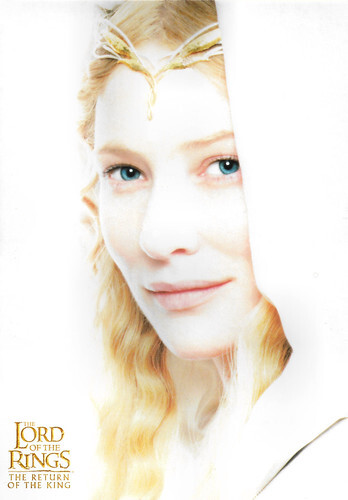
British postcard by GB Posters, Sheffield, no. PC 0710. Photo: New Line Cinema. Cate Blanchett as Galadriel in The Lord of the Rings - The Return of the King (Peter Jackson, 2003).
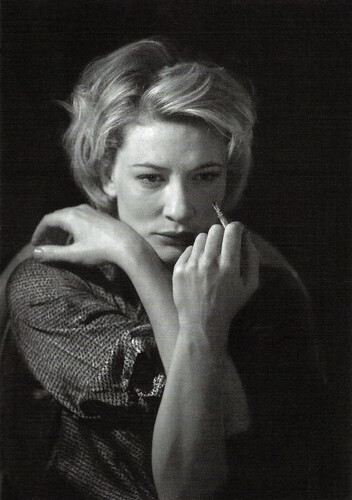
German postcard by Gallery Salz und Silber. Photo: Simon Annand. Caption: Cate Blanchett. Albery Theatre, Plenty, 1999.
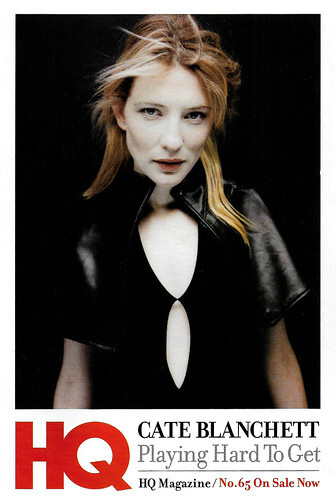
Australian freecard by AvantCard for HQ, no. 3146. Photo: Lorenzo Agius / Public, London. Caption: Cate Blanchett, Playing Hard To Get.
Purely positive reviews for her roles
Catherine Élise ‘Cate’ Blanchett was born in Ivanhoe, a suburb of Melbourne in 1969. Her American father Robert DeWitt Blanchett Jr. was a Texas naval officer who became an advertising executive, and her Australian mother June (née Gamble), was a property developer and teacher. They met when Robert's ship broke down in Melbourne. Cate is the second of three children, with an older brother and a younger sister.
When Blanchett was ten, her father died of a heart attack, leaving her mother to raise the family. During her teenage years, Cate had a penchant for dressing in traditionally masculine clothing, and went through goth and punk phases, at one point shaving her head. After high school, she began a degree in economics and fine arts at the University of Melbourne but dropped out after one year to travel overseas. While in Egypt, Blanchett was asked to be an extra as an American cheerleader in the Egyptian boxing film Kaboria (Khairy Beshara, 1990). In need of money, she accepted the job.
On returning to Australia, she moved to Sydney and enrolled at the National Institute of Dramatic Art (NIDA) in 1992. After her studies, she joined the Sydney Theatre Company. There she starred in ‘Top Girls’. In 1993, she won two major theatre awards, the Newcomer Award from the Sydney Theatre Critics Circle for her role in the musical ‘Kafka Dances’, and the Rosemont Best Actress Award for her role in David Mamet's ‘Oleanna’, in which she starred opposite Geoffrey Rush. Blanchett moved into television. She starred in the popular series Heartland (1994) and Police Rescue (1994). She received purely positive reviews for her roles and her television and theatre careers prospered.
In 1997, Blanchett made her film debut in the American-Australian production Paradise Road (Bruce Beresford, 1997). In this prisoner-of-war drama, she starred as an Australian nurse captured by the Japanese Army during World War II opposite Glenn Close and Frances McDormand. She won the Australian Film Institute's Best Actress Award for her second film, the romantic comedy Thank God He Met Lizzie (Cherie Nowlan, 1997). Her role as eccentric heiress Lucinda Leplastrier in the romantic drama Oscar and Lucinda (Gillian Armstrong, 1997), opposite Ralph Fiennes, got her attention from abroad.
In 1998, Blanchett played the role of young Queen Elizabeth I of England in the British drama Elizabeth (Shekhar Kapur., 1998). The film received eight Oscar nominations, including one for Best Actress, for Blanchett. She lost the Academy Award to Gwyneth Paltrow, but she did receive a Golden Globe. The following year, she acted in such films as Pushing Tin (Mike Newell, 1999), An Ideal Husband (1999) and The Talented Mr Ripley (Anthony Minghella, 1999), starring Matt Damon as Tom Ripley.
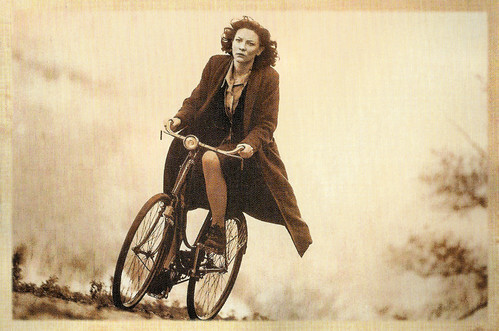
Australian Freecard by AvantCard, no. 6391, 2002. Photo: FilmFour. Cate Blanchett in Charlotte Gray (Gillian Armstrong, 2001).
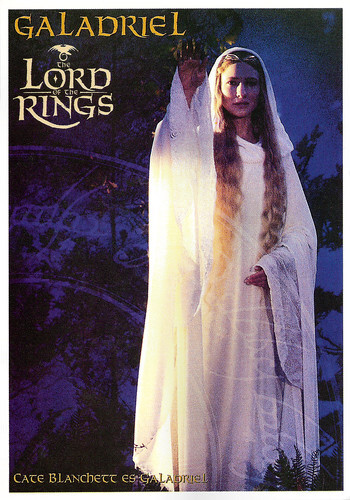
Spanish postcard by Memory Card, no. 741. Cate Blanchett in The Lord of the Rings - The Fellowship of the Ring (Peter Jackson, 2001).
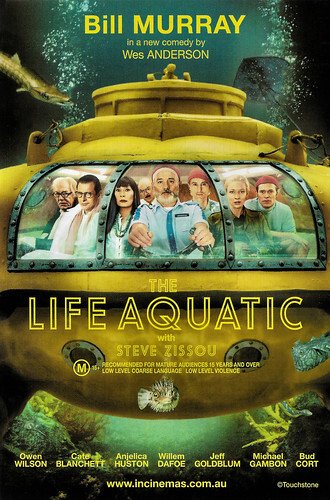
Australian Freecard by AvantCard. Photo: Touchstone. Image: a poster of The Life Aquatic with Steve Zissou (Wes Anderson, 2004) with Bill Murray, Cate Blanchett, Angelica Huston, Willem Dafoe, Jeff Goldblum, Michael Gambon, Owen Wilson, and Bud Cort.
A wonder of acting
More international roles in a wide variety of international films followed for Cate Blanchett. In the new century, she did mystery in The Gift (Sam Raimi, 2000) with Keanu Reeves , comedy in Bandits (Barry Levinson, 2001) with Billy Bob Thornton and Bruce Willis, and drama in Heaven (Tom Tykwer, 2002) with Giovanni Ribisi.
She reached a whole new audience with the role of the elf leader Galadriel in Peter Jackson's Blockbuster The Lord of the Rings trilogy: The Fellowship of the Ring (2001), The Two Towers (2002), and The Return of the King (2003). Later, she played the role of Galadriel again in the story that precedes The Lord of the Rings, The Hobbit trilogy: An Unexpected Journey (Peter Jackson, 2012), The Desolation of Smaug (Peter Jackson, 2013), and The Battle of the Five Armies (Peter Jackson, 2014).
She played the title role in Veronica Guerin (Joel Schumacher, 2003) and played Katharine Hepburn in The Aviator (Martin Scorsese, 2004) opposite Leonardo DiCaprio . For this role, she won the Oscar for Best Female Supporting Actor. Roger Ebert lauded the performance, describing it as "delightful and yet touching; mannered and tomboyish". In 2004, she played a pregnant journalist in the adventure comedy-drama The Life Aquatic With Steve Zissou (Wes Anderson, 2004) starring Bill Murray as Steve Zissou, an eccentric oceanographer who sets out with his crew to exact revenge on the ‘jaguar shark’ that ate his partner Esteban. During the shooting of the film, she was also pregnant in real life.
After this, she returned to Australia for the film Little Fish (Rowan Woods, 2005) in which she played an ex-drug addict. She acted opposite Brad Pitt in the acclaimed psychological drama Babel (Alejandro González Iñárritu, 2006). For the psychological thriller Notes on a Scandal (Richard Eyre, 2006) opposite Dame Judi Dench, she was nominated for an Oscar in the ‘Best Supporting Actress category. In 2007, she played the role of Queen Elizabeth for the second time, in Elizabeth: The Golden Age (Shekhar Kapur, 2007). That year, she also starred as Jude Quinn, one of six incarnations of Bob Dylan in the experimental film I'm Not There (Todd Hayes, 2007), for which she was awarded a Golden Globe. Roger Ebert: "That Blanchett could appear in the same Toronto International Film Festival playing Elizabeth and Bob Dylan, both splendidly, is a wonder of acting." Next, Blanchett appeared in Steven Spielberg's Indiana Jones and the Kingdom of the Crystal Skull (2008), as the villainous KGB agent Col. Dr. Irina Spalko. That year, she also starred alongside Brad Pitt in David Fincher's Oscar-nominated The Curious Case of Benjamin Button (2008).
Blanchett and her husband Andrew Upton became co-CEOs and artistic directors of the Sydney Theatre Company. In 2009, she returned to acting in the theatre with the Sydney Theatre Company. In 2010, she starred as Lady Marion opposite Russell Crowe's titular hero in Ridley Scott's epic Robin Hood. Blanchett won an Oscar in 2013 for the lead role of Jasmine in the tragicomedy Blue Jasmine (Woody Allen, 2013). Blanchett also starred as Lydia Tár, a fictional renowned conductor, in Tár (Todd Field, 2022). Her performance received rave reviews. For the performance, Blanchett won her second Volpi Cup for best actress, her fourth Golden Globe Award and her fourth BAFTA Award. Subsequently, she received her eighth Oscar nomination. In 2023, Blanchett co-starred in the Australian drama film The New Boy (Warwick Thornton, 2023), which she also produced. It follows a young Aboriginal Australian orphan boy who is brought into a Christian monastery, run by a renegade nun, where he begins to question his faith and loyalty to his heritage. In 1997, Cate Blanchett married playwright Andrew Upton. They have three sons together and adopted a daughter in 2015.
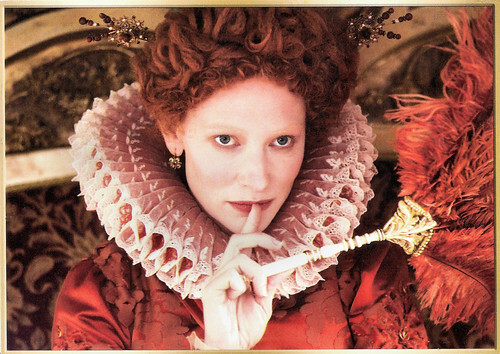
German postcard by Universal Pictures.de for the DVD release. Photo: Universal. Publicity still for Elizabeth: the Golden Age (Shekhar Kapur, 2007).
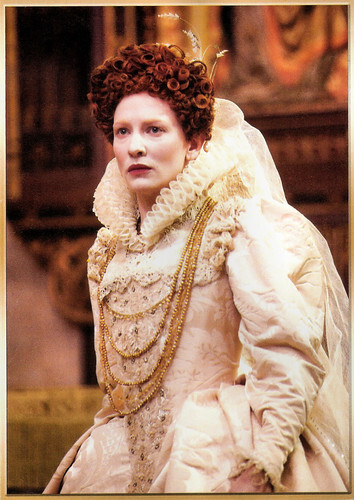
German postcard by Universal Pictures.de for the DVD release. Photo: Universal. Publicity still for Elizabeth: the Golden Age (Shekhar Kapur, 2007).
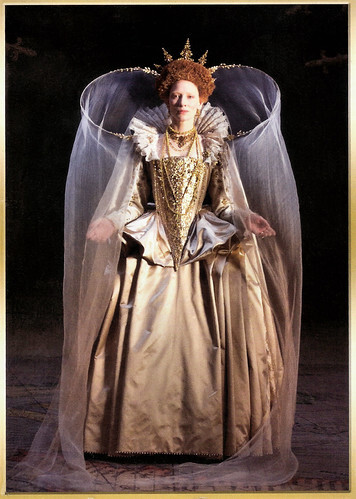
German postcard by Universal Pictures.de for the DVD release. Photo: Universal. Publicity still for Elizabeth: the Golden Age (Shekhar Kapur, 2007).
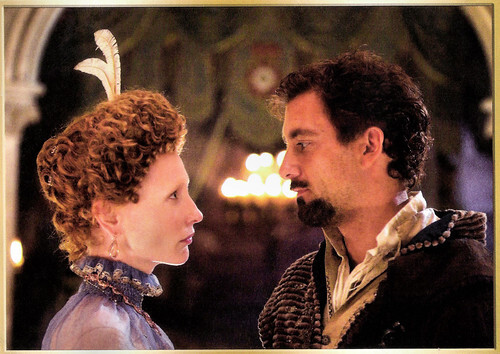
German postcard by Universal Pictures.de for the DVD release. Photo: Universal. Cate Blanchett and Clive Owen in Elizabeth: the Golden Age (Shekhar Kapur, 2007).
Sources: Wikipedia (Dutch, German and English) and .

British postcard by GB Posters, Sheffield, no. PC 0710. Photo: New Line Cinema. Cate Blanchett as Galadriel in The Lord of the Rings - The Return of the King (Peter Jackson, 2003).

German postcard by Gallery Salz und Silber. Photo: Simon Annand. Caption: Cate Blanchett. Albery Theatre, Plenty, 1999.

Australian freecard by AvantCard for HQ, no. 3146. Photo: Lorenzo Agius / Public, London. Caption: Cate Blanchett, Playing Hard To Get.
Purely positive reviews for her roles
Catherine Élise ‘Cate’ Blanchett was born in Ivanhoe, a suburb of Melbourne in 1969. Her American father Robert DeWitt Blanchett Jr. was a Texas naval officer who became an advertising executive, and her Australian mother June (née Gamble), was a property developer and teacher. They met when Robert's ship broke down in Melbourne. Cate is the second of three children, with an older brother and a younger sister.
When Blanchett was ten, her father died of a heart attack, leaving her mother to raise the family. During her teenage years, Cate had a penchant for dressing in traditionally masculine clothing, and went through goth and punk phases, at one point shaving her head. After high school, she began a degree in economics and fine arts at the University of Melbourne but dropped out after one year to travel overseas. While in Egypt, Blanchett was asked to be an extra as an American cheerleader in the Egyptian boxing film Kaboria (Khairy Beshara, 1990). In need of money, she accepted the job.
On returning to Australia, she moved to Sydney and enrolled at the National Institute of Dramatic Art (NIDA) in 1992. After her studies, she joined the Sydney Theatre Company. There she starred in ‘Top Girls’. In 1993, she won two major theatre awards, the Newcomer Award from the Sydney Theatre Critics Circle for her role in the musical ‘Kafka Dances’, and the Rosemont Best Actress Award for her role in David Mamet's ‘Oleanna’, in which she starred opposite Geoffrey Rush. Blanchett moved into television. She starred in the popular series Heartland (1994) and Police Rescue (1994). She received purely positive reviews for her roles and her television and theatre careers prospered.
In 1997, Blanchett made her film debut in the American-Australian production Paradise Road (Bruce Beresford, 1997). In this prisoner-of-war drama, she starred as an Australian nurse captured by the Japanese Army during World War II opposite Glenn Close and Frances McDormand. She won the Australian Film Institute's Best Actress Award for her second film, the romantic comedy Thank God He Met Lizzie (Cherie Nowlan, 1997). Her role as eccentric heiress Lucinda Leplastrier in the romantic drama Oscar and Lucinda (Gillian Armstrong, 1997), opposite Ralph Fiennes, got her attention from abroad.
In 1998, Blanchett played the role of young Queen Elizabeth I of England in the British drama Elizabeth (Shekhar Kapur., 1998). The film received eight Oscar nominations, including one for Best Actress, for Blanchett. She lost the Academy Award to Gwyneth Paltrow, but she did receive a Golden Globe. The following year, she acted in such films as Pushing Tin (Mike Newell, 1999), An Ideal Husband (1999) and The Talented Mr Ripley (Anthony Minghella, 1999), starring Matt Damon as Tom Ripley.

Australian Freecard by AvantCard, no. 6391, 2002. Photo: FilmFour. Cate Blanchett in Charlotte Gray (Gillian Armstrong, 2001).

Spanish postcard by Memory Card, no. 741. Cate Blanchett in The Lord of the Rings - The Fellowship of the Ring (Peter Jackson, 2001).

Australian Freecard by AvantCard. Photo: Touchstone. Image: a poster of The Life Aquatic with Steve Zissou (Wes Anderson, 2004) with Bill Murray, Cate Blanchett, Angelica Huston, Willem Dafoe, Jeff Goldblum, Michael Gambon, Owen Wilson, and Bud Cort.
A wonder of acting
More international roles in a wide variety of international films followed for Cate Blanchett. In the new century, she did mystery in The Gift (Sam Raimi, 2000) with Keanu Reeves , comedy in Bandits (Barry Levinson, 2001) with Billy Bob Thornton and Bruce Willis, and drama in Heaven (Tom Tykwer, 2002) with Giovanni Ribisi.
She reached a whole new audience with the role of the elf leader Galadriel in Peter Jackson's Blockbuster The Lord of the Rings trilogy: The Fellowship of the Ring (2001), The Two Towers (2002), and The Return of the King (2003). Later, she played the role of Galadriel again in the story that precedes The Lord of the Rings, The Hobbit trilogy: An Unexpected Journey (Peter Jackson, 2012), The Desolation of Smaug (Peter Jackson, 2013), and The Battle of the Five Armies (Peter Jackson, 2014).
She played the title role in Veronica Guerin (Joel Schumacher, 2003) and played Katharine Hepburn in The Aviator (Martin Scorsese, 2004) opposite Leonardo DiCaprio . For this role, she won the Oscar for Best Female Supporting Actor. Roger Ebert lauded the performance, describing it as "delightful and yet touching; mannered and tomboyish". In 2004, she played a pregnant journalist in the adventure comedy-drama The Life Aquatic With Steve Zissou (Wes Anderson, 2004) starring Bill Murray as Steve Zissou, an eccentric oceanographer who sets out with his crew to exact revenge on the ‘jaguar shark’ that ate his partner Esteban. During the shooting of the film, she was also pregnant in real life.
After this, she returned to Australia for the film Little Fish (Rowan Woods, 2005) in which she played an ex-drug addict. She acted opposite Brad Pitt in the acclaimed psychological drama Babel (Alejandro González Iñárritu, 2006). For the psychological thriller Notes on a Scandal (Richard Eyre, 2006) opposite Dame Judi Dench, she was nominated for an Oscar in the ‘Best Supporting Actress category. In 2007, she played the role of Queen Elizabeth for the second time, in Elizabeth: The Golden Age (Shekhar Kapur, 2007). That year, she also starred as Jude Quinn, one of six incarnations of Bob Dylan in the experimental film I'm Not There (Todd Hayes, 2007), for which she was awarded a Golden Globe. Roger Ebert: "That Blanchett could appear in the same Toronto International Film Festival playing Elizabeth and Bob Dylan, both splendidly, is a wonder of acting." Next, Blanchett appeared in Steven Spielberg's Indiana Jones and the Kingdom of the Crystal Skull (2008), as the villainous KGB agent Col. Dr. Irina Spalko. That year, she also starred alongside Brad Pitt in David Fincher's Oscar-nominated The Curious Case of Benjamin Button (2008).
Blanchett and her husband Andrew Upton became co-CEOs and artistic directors of the Sydney Theatre Company. In 2009, she returned to acting in the theatre with the Sydney Theatre Company. In 2010, she starred as Lady Marion opposite Russell Crowe's titular hero in Ridley Scott's epic Robin Hood. Blanchett won an Oscar in 2013 for the lead role of Jasmine in the tragicomedy Blue Jasmine (Woody Allen, 2013). Blanchett also starred as Lydia Tár, a fictional renowned conductor, in Tár (Todd Field, 2022). Her performance received rave reviews. For the performance, Blanchett won her second Volpi Cup for best actress, her fourth Golden Globe Award and her fourth BAFTA Award. Subsequently, she received her eighth Oscar nomination. In 2023, Blanchett co-starred in the Australian drama film The New Boy (Warwick Thornton, 2023), which she also produced. It follows a young Aboriginal Australian orphan boy who is brought into a Christian monastery, run by a renegade nun, where he begins to question his faith and loyalty to his heritage. In 1997, Cate Blanchett married playwright Andrew Upton. They have three sons together and adopted a daughter in 2015.

German postcard by Universal Pictures.de for the DVD release. Photo: Universal. Publicity still for Elizabeth: the Golden Age (Shekhar Kapur, 2007).

German postcard by Universal Pictures.de for the DVD release. Photo: Universal. Publicity still for Elizabeth: the Golden Age (Shekhar Kapur, 2007).

German postcard by Universal Pictures.de for the DVD release. Photo: Universal. Publicity still for Elizabeth: the Golden Age (Shekhar Kapur, 2007).

German postcard by Universal Pictures.de for the DVD release. Photo: Universal. Cate Blanchett and Clive Owen in Elizabeth: the Golden Age (Shekhar Kapur, 2007).
Sources: Wikipedia (Dutch, German and English) and .
Published on September 06, 2024 22:00
September 5, 2024
Carlo Keil-Möller
Handsome Swedish actor Carlo Keil-Möller appeared in several silent Scandinavian films. He also worked as a director and screenwriter.
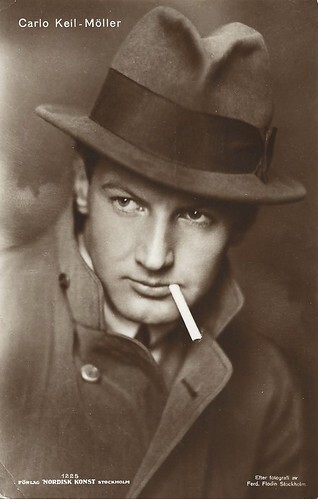
Swedish postcard by Förlag Nordisk Konst, Stockholm, no. 1225. Photo: Ferd. Flodin, Stockholm.
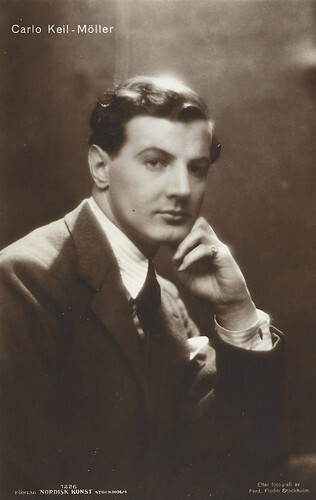
Swedish postcard by Förlag Nordisk Konst, Stockholm, no. 1226. Photo: Ferd. Flodin, Stockholm.
A rich estate owner, incapable of running his affairs
Carl Otto (Carlo) Keil-Möller was born in 1890 in Örgryte, Sweden. He was the son of Johan Mauritz Möller, a city broker, and Olga Antonia Keil. He grew up in Gothenburg and after graduating in 1910, he studied at Uppsala University, which resulted in a Bachelor of Arts degree in 1914.
After studying theatre with Louise Fahlman, Signe Hebbe and Gustaf Fredrikson, he made his professional theatre debut in 1915 at the Intima Theatre He there remained until 1921 and often acted under the direction of Einar Fröberg in plays by Strindberg, Molière, Hauptmann, Shakespeare, and others.
Between 1922 and 1927 Carlo Keil-Möller acted at the Helsingborg City Theatre, often under the direction of Torsten Hammarén and Gerda Lundequist-Dalström, later also Gösta Cederlund.
Carlo Keil-Möller debuted on screen opposite Gösta Ekman and Mary Johnson in the Skandia production Mästerkatten i stövlar/Puss in Boots (John W. Brunius, 1918). In this film he played a rich estate owner, incapable of running his affairs, so Ekman as the 'Puss in Boots' helps him out. Johnson played his love interest.
At Skandia, Keil-Möller and Johnson were reunited in Robinson i skärgården/A Modern Robinson (Rune Carlsten, 1920), while together with Ekman they were also reunited in En lyckoriddare/ A Fortune Hunter (John W. Brunius, 1921). In the latter Ekman is the dashing rogue who steals Johnson's heart.
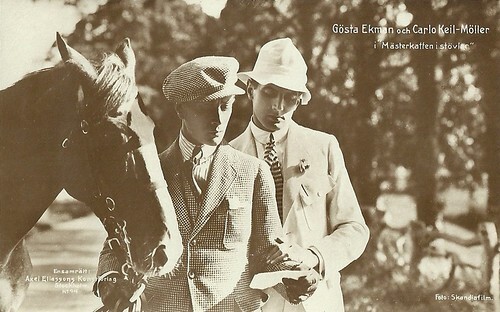
Swedish postcard by Axel Eliassons Konstförlag, Stockholm, no. 94. Photo: Skandiafilm. Gösta Ekman and Carlo Keil-Möller in the Swedish silent romantic film Mästerkatten i stövlar/Puss in boots (John W. Brunius, 1918).
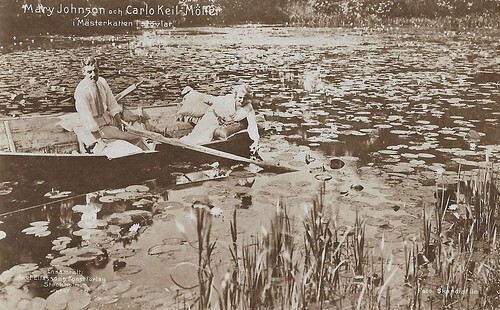
Swedish postcard by Axel Eliassons Konstförlag, Stockholm, no. 97. Photo: Skandia Film. Mary Johnson and Carl Keil-Möller in Mästerkatten i stövlar/Puss in boots (John W. Brunius, 1918).
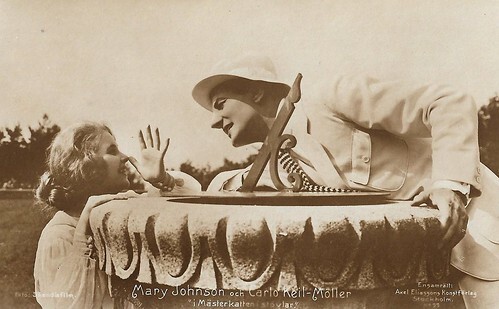
Swedish postcard by Axel Eliassons Konstförlag, Stockholm, no. 99. Photo: Skandiafilm. Mary Johnson and Carl Keil-Möller in Mästerkatten i stövlar/Puss in boots (John W. Brunius, 1918).
Two aristocrats who love fast cars - and each other
In 1923 Carlo Keil-Möller shifted to screenwriting, starting with Brunius' film Johan Ulfstjerna (John Brunius, 1923) with Ivan Hedqvist and Einar Hanson . He also scripted the comedy En piga bland pigor/A Maid Among Maids (John Brunius, 1924). In this film, Keil-Möller played the last male lead of his film career, opposite Magda Holm, who plays a fun-loving girl who breaks off her engagement and becomes a maid on a farm.
Keil-Möller ended his career in silent film by co-writing the Gösta Ekman vehicle Unga greven tar flickan och priset/The Young Count Takes the Girl and the Prize (1924), directed by Rune Carlsten, about two aristocrats who love fast cars - and each other. From 1927 to 1934, Carlo Keil-Möller worked as a theatre director at the Lorensberg Theatre and from 1934 to 1935 at the Gothenburg City Theatre.
Between 1935 and 1939, he co-wrote two films at Svensk Filmindustri that were filmed, the drama Äventyret/Adventure (Per-Axel Branner, 1936) starring Karin Swanström and the crime drama Ett brott/A Crime (Anders Henrikson, 1940). Two other scripts were never filmed. He co-directed one film, the comedy En flicka kommer till sta'n/A Girl Comes to the City (Carlo Keil-Möller, Thor Brooks, 1939), starring Isa Quensel.
In 1939, he was hired as the first director at Dramaten, where he remained until 1946. He became a specialist in staging comedies and he also wrote a number himself. In addition, from 1929 to 1943 Keil-Möller was a film reviewer at Göteborgs Handels- och Sjöfartstidning and from 1943 to 1945 at Morgontidningen.
Carlo Keil-Möller married Thomasine Stjernswärd, née Piper in 1947. Keil-Möller died in Blentarps parish, Skåne, in 1958 at the age of 68 and was buried in Sövde cemetery.
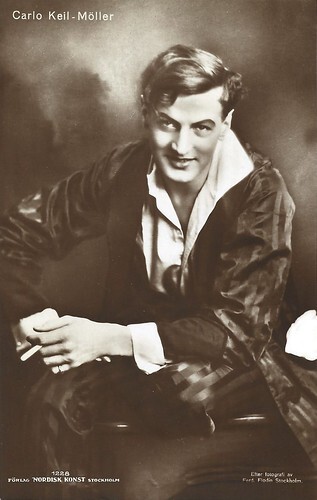
Swedish postcard by Förlag Nordisk Konst, Stockholm, no. 1228. Photo: Ferd. Flodin, Stockholm.
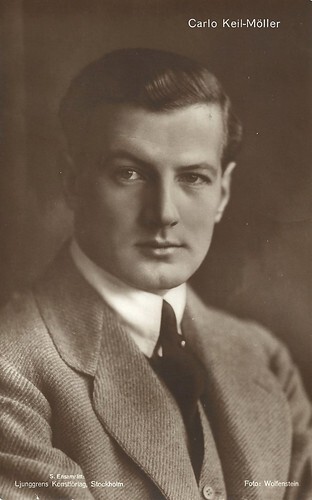
Swedish postcard by Ljunggrens Konstförlag, Stockholm, no. 5 Photo: Wolfenstein.
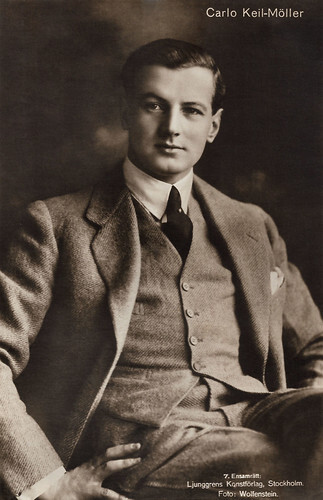
Swedish postcard by Ljunggrens Konstförlag, Stockholm, no. 7. Photo: Wolfenstein.
Sources: Svenskfilmdatabas, Wikipedia (English and Swedish) and .

Swedish postcard by Förlag Nordisk Konst, Stockholm, no. 1225. Photo: Ferd. Flodin, Stockholm.

Swedish postcard by Förlag Nordisk Konst, Stockholm, no. 1226. Photo: Ferd. Flodin, Stockholm.
A rich estate owner, incapable of running his affairs
Carl Otto (Carlo) Keil-Möller was born in 1890 in Örgryte, Sweden. He was the son of Johan Mauritz Möller, a city broker, and Olga Antonia Keil. He grew up in Gothenburg and after graduating in 1910, he studied at Uppsala University, which resulted in a Bachelor of Arts degree in 1914.
After studying theatre with Louise Fahlman, Signe Hebbe and Gustaf Fredrikson, he made his professional theatre debut in 1915 at the Intima Theatre He there remained until 1921 and often acted under the direction of Einar Fröberg in plays by Strindberg, Molière, Hauptmann, Shakespeare, and others.
Between 1922 and 1927 Carlo Keil-Möller acted at the Helsingborg City Theatre, often under the direction of Torsten Hammarén and Gerda Lundequist-Dalström, later also Gösta Cederlund.
Carlo Keil-Möller debuted on screen opposite Gösta Ekman and Mary Johnson in the Skandia production Mästerkatten i stövlar/Puss in Boots (John W. Brunius, 1918). In this film he played a rich estate owner, incapable of running his affairs, so Ekman as the 'Puss in Boots' helps him out. Johnson played his love interest.
At Skandia, Keil-Möller and Johnson were reunited in Robinson i skärgården/A Modern Robinson (Rune Carlsten, 1920), while together with Ekman they were also reunited in En lyckoriddare/ A Fortune Hunter (John W. Brunius, 1921). In the latter Ekman is the dashing rogue who steals Johnson's heart.

Swedish postcard by Axel Eliassons Konstförlag, Stockholm, no. 94. Photo: Skandiafilm. Gösta Ekman and Carlo Keil-Möller in the Swedish silent romantic film Mästerkatten i stövlar/Puss in boots (John W. Brunius, 1918).

Swedish postcard by Axel Eliassons Konstförlag, Stockholm, no. 97. Photo: Skandia Film. Mary Johnson and Carl Keil-Möller in Mästerkatten i stövlar/Puss in boots (John W. Brunius, 1918).

Swedish postcard by Axel Eliassons Konstförlag, Stockholm, no. 99. Photo: Skandiafilm. Mary Johnson and Carl Keil-Möller in Mästerkatten i stövlar/Puss in boots (John W. Brunius, 1918).
Two aristocrats who love fast cars - and each other
In 1923 Carlo Keil-Möller shifted to screenwriting, starting with Brunius' film Johan Ulfstjerna (John Brunius, 1923) with Ivan Hedqvist and Einar Hanson . He also scripted the comedy En piga bland pigor/A Maid Among Maids (John Brunius, 1924). In this film, Keil-Möller played the last male lead of his film career, opposite Magda Holm, who plays a fun-loving girl who breaks off her engagement and becomes a maid on a farm.
Keil-Möller ended his career in silent film by co-writing the Gösta Ekman vehicle Unga greven tar flickan och priset/The Young Count Takes the Girl and the Prize (1924), directed by Rune Carlsten, about two aristocrats who love fast cars - and each other. From 1927 to 1934, Carlo Keil-Möller worked as a theatre director at the Lorensberg Theatre and from 1934 to 1935 at the Gothenburg City Theatre.
Between 1935 and 1939, he co-wrote two films at Svensk Filmindustri that were filmed, the drama Äventyret/Adventure (Per-Axel Branner, 1936) starring Karin Swanström and the crime drama Ett brott/A Crime (Anders Henrikson, 1940). Two other scripts were never filmed. He co-directed one film, the comedy En flicka kommer till sta'n/A Girl Comes to the City (Carlo Keil-Möller, Thor Brooks, 1939), starring Isa Quensel.
In 1939, he was hired as the first director at Dramaten, where he remained until 1946. He became a specialist in staging comedies and he also wrote a number himself. In addition, from 1929 to 1943 Keil-Möller was a film reviewer at Göteborgs Handels- och Sjöfartstidning and from 1943 to 1945 at Morgontidningen.
Carlo Keil-Möller married Thomasine Stjernswärd, née Piper in 1947. Keil-Möller died in Blentarps parish, Skåne, in 1958 at the age of 68 and was buried in Sövde cemetery.

Swedish postcard by Förlag Nordisk Konst, Stockholm, no. 1228. Photo: Ferd. Flodin, Stockholm.

Swedish postcard by Ljunggrens Konstförlag, Stockholm, no. 5 Photo: Wolfenstein.

Swedish postcard by Ljunggrens Konstförlag, Stockholm, no. 7. Photo: Wolfenstein.
Sources: Svenskfilmdatabas, Wikipedia (English and Swedish) and .
Published on September 05, 2024 22:00
September 4, 2024
Egy dollar (1924)
Hungarian silent actress Ila Lóth was the star of the German-Hungarian coproduction Egy Dollár/One Dollar also known as Az egyhuszasos lány (Uwe Jens Krafft, 1924). Egy Dollár/One Dollar was filmed, including exteriors shot at the Hamburg harbour, in 1923.
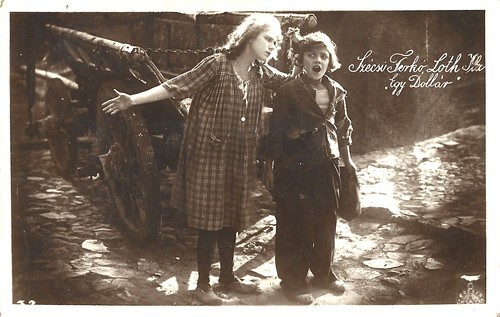
Hungarian postcard by K Ltd, no. 32. Photo: Corvin Film / May Film. Ila Lóth and Ferenc 'Ferkó' Szécsi in Egy Dollár/One Dollar aka Az egyhuszasos lány (Uwe Jens Krafft, 1924).
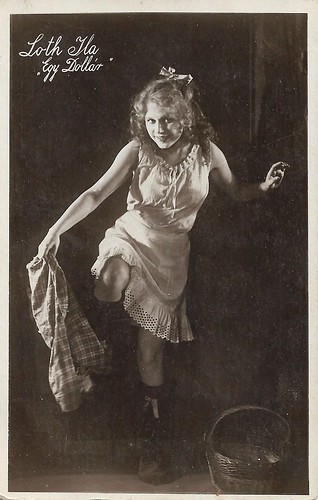
Hungarian postcard. Photo: Corvin Film / May Film. Ila Lóth in Egy Dollár/One Dollar aka Az egyhuszasos lány (Uwe Jens Krafft, 1924).
A filthy little pawnshop
Egy Dollár/One Dollar (Uwe Jens Krafft, 1924) is situated in Hamburg. In an off-site corner of the port quarter, the rich Bagger (Lajos Réthey) lives in his filthy little pawn shop. One day a mother (Irma Lányi) steps in with her daughter. She wants to sell all her belongings to be able to set out to care for her uncle who fell ill in a distant country.
The mother is forced to even put her daughter, Maggie ( Ila Lóth ) in pawn to the usurper. She gets one dollar to make it for the fares.
At this time, the greedy usurer can only see a free maidservant in the girl. As years pass by and Maggie’s beauty unfolds, the old Bagger falls in love with her and wants to marry her.
Fortunately, her mother returns just in time and takes Maggie out of pawn from Bagger. So Maggie can marry her true love, Charley Brown (Gábor Rajnay), the noble youth who became demoralised and disowned due to his light-mindedness. Regretting his sins, he returned to his hometown as a seaman.
Egy Dollár/One Dollar (Uwe Jens Krafft, 1924) has survived, writes Márton Kurutz of the National Film Institute in Budapest us. Only the dream scene is missing. Márton, many thanks for mailing us the plot of the film and the information about the existing copy!
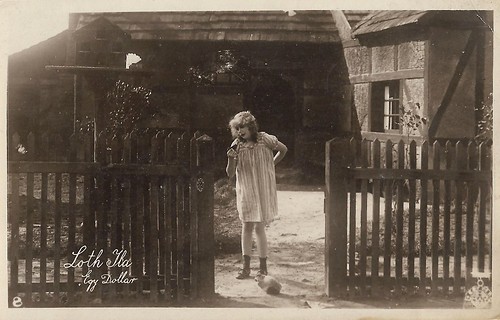
Hungarian postcard, no. 2. Photo: Corvin Film / May Film. Ila Lóth in Egy Dollár/One Dollar aka Az egyhuszasos lány (Uwe Jens Krafft, 1924).
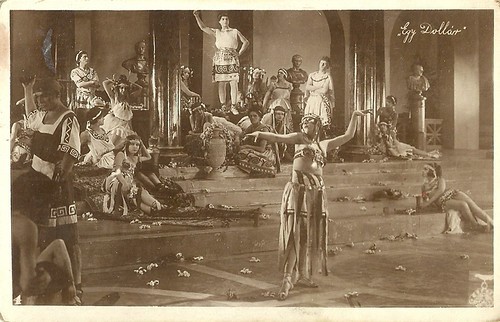
Hungarian postcard, no. 4. Photo: Corvin Film / May Film. Ila Lóth in Egy Dollár/One Dollar aka Az egyhuszasos lány (Uwe Jens Krafft, 1924).
The Picture of Dorian Gray
Ila Lóth was discovered by screenwriter József Pakots in 1917 and became a member of the Star Film Company. Soon she was a popular star of the Hungarian silent cinema.
Loth starred in several films directed by actor-turned-director Alfréd Deésy. She was the maid in Raskolnikov (Alfréd Deésy, 1917) and Sybil Vane in Az élet királya/The Picture of Dorian Gray (Alfréd Deésy, 1918), with Norbert Dán as Gray and Béla Lugosi ,w ho performed in the film under the name Arisztid Olt, as Lord Henry Wotton. Az élet királya/The Picture of Dorian Gray was described as an "almost unprecedented success" in the local Budapest press. Sadly, no copy of the film is known to exist.
In later years, Béla Balogh directed her at Star Film. She played the miller's daughter Marta in his Hegyek alján/Under the Mountains (Bela Balogh, 1920), with Iván Petrovich . Ila Lóth also appeared as Gladys in Az ötödik osztály/The Fifth Class (Béla Balogh, 1920) and as Beatrix in Lengyelvér/The Polish Castle (Béla Balogh 1920) again opposite Petrovich.
Meanwhile, in 1919 Loth had also begun to alternate Star Film with the Corvin Film Factory, on the recommendation of Alexander Korda. She appeared in several films as a naive young girl, such as Maggie in Egy dollár/Az egyhuszasos lány (Uwe Jens Krafft, 1923), co-produced by Joe May's May Film. Future Hollywood actor Paul Lukas played a small part as a sailor. Egy Dollár/One Dollar (Uwe Jens Krafft, 1924) was probably Loth's last silent film.
Beforehand, Loth had also made some films at Emelka in Munich, such as Der Verfluchte (Franz Osten, 1921), with Violetta Napierska , and Schattenkinder des Glücks (Franz Osten, 1922), with Vilma Banky . All in all, Loth acted in some 35 silent films. In 1923, Ila Lóth married Győző János Rohoczy Storer in Budapest and retired for a long time. From 1948 onward, she played again small parts in films but also acted on stage at the Madách Theater. From 1960 she also appeared in some TV movies and one series. Through her daughter Judit, she is the grandmother of the actress Sunnyi Melles, Princess of Sayn-Wittgenstein-Sayn.
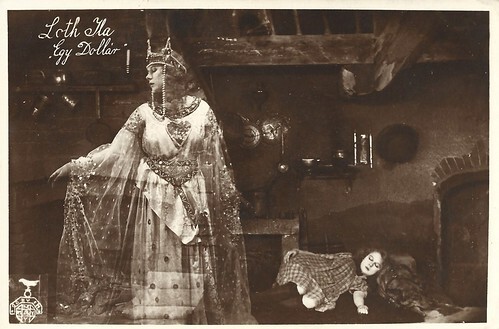
Hungarian postcard. Photo: Corvin Film / May Film. Ila Lóth in Egy Dollár/One Dollar aka Az egyhuszasos lány (Uwe Jens Krafft, 1924).
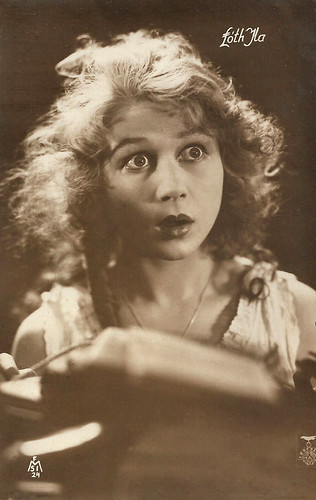
Hungarian postcard by MFSI, no 24. Photo: May. Ila Lóth in Lengyelvér/Polish Blood (Béla Balogh, 1921).
Sources: Márton Kurutz (National Film Institute, Budapest), Wikipedia (Hungarian and English) and IMDb.

Hungarian postcard by K Ltd, no. 32. Photo: Corvin Film / May Film. Ila Lóth and Ferenc 'Ferkó' Szécsi in Egy Dollár/One Dollar aka Az egyhuszasos lány (Uwe Jens Krafft, 1924).

Hungarian postcard. Photo: Corvin Film / May Film. Ila Lóth in Egy Dollár/One Dollar aka Az egyhuszasos lány (Uwe Jens Krafft, 1924).
A filthy little pawnshop
Egy Dollár/One Dollar (Uwe Jens Krafft, 1924) is situated in Hamburg. In an off-site corner of the port quarter, the rich Bagger (Lajos Réthey) lives in his filthy little pawn shop. One day a mother (Irma Lányi) steps in with her daughter. She wants to sell all her belongings to be able to set out to care for her uncle who fell ill in a distant country.
The mother is forced to even put her daughter, Maggie ( Ila Lóth ) in pawn to the usurper. She gets one dollar to make it for the fares.
At this time, the greedy usurer can only see a free maidservant in the girl. As years pass by and Maggie’s beauty unfolds, the old Bagger falls in love with her and wants to marry her.
Fortunately, her mother returns just in time and takes Maggie out of pawn from Bagger. So Maggie can marry her true love, Charley Brown (Gábor Rajnay), the noble youth who became demoralised and disowned due to his light-mindedness. Regretting his sins, he returned to his hometown as a seaman.
Egy Dollár/One Dollar (Uwe Jens Krafft, 1924) has survived, writes Márton Kurutz of the National Film Institute in Budapest us. Only the dream scene is missing. Márton, many thanks for mailing us the plot of the film and the information about the existing copy!

Hungarian postcard, no. 2. Photo: Corvin Film / May Film. Ila Lóth in Egy Dollár/One Dollar aka Az egyhuszasos lány (Uwe Jens Krafft, 1924).

Hungarian postcard, no. 4. Photo: Corvin Film / May Film. Ila Lóth in Egy Dollár/One Dollar aka Az egyhuszasos lány (Uwe Jens Krafft, 1924).
The Picture of Dorian Gray
Ila Lóth was discovered by screenwriter József Pakots in 1917 and became a member of the Star Film Company. Soon she was a popular star of the Hungarian silent cinema.
Loth starred in several films directed by actor-turned-director Alfréd Deésy. She was the maid in Raskolnikov (Alfréd Deésy, 1917) and Sybil Vane in Az élet királya/The Picture of Dorian Gray (Alfréd Deésy, 1918), with Norbert Dán as Gray and Béla Lugosi ,w ho performed in the film under the name Arisztid Olt, as Lord Henry Wotton. Az élet királya/The Picture of Dorian Gray was described as an "almost unprecedented success" in the local Budapest press. Sadly, no copy of the film is known to exist.
In later years, Béla Balogh directed her at Star Film. She played the miller's daughter Marta in his Hegyek alján/Under the Mountains (Bela Balogh, 1920), with Iván Petrovich . Ila Lóth also appeared as Gladys in Az ötödik osztály/The Fifth Class (Béla Balogh, 1920) and as Beatrix in Lengyelvér/The Polish Castle (Béla Balogh 1920) again opposite Petrovich.
Meanwhile, in 1919 Loth had also begun to alternate Star Film with the Corvin Film Factory, on the recommendation of Alexander Korda. She appeared in several films as a naive young girl, such as Maggie in Egy dollár/Az egyhuszasos lány (Uwe Jens Krafft, 1923), co-produced by Joe May's May Film. Future Hollywood actor Paul Lukas played a small part as a sailor. Egy Dollár/One Dollar (Uwe Jens Krafft, 1924) was probably Loth's last silent film.
Beforehand, Loth had also made some films at Emelka in Munich, such as Der Verfluchte (Franz Osten, 1921), with Violetta Napierska , and Schattenkinder des Glücks (Franz Osten, 1922), with Vilma Banky . All in all, Loth acted in some 35 silent films. In 1923, Ila Lóth married Győző János Rohoczy Storer in Budapest and retired for a long time. From 1948 onward, she played again small parts in films but also acted on stage at the Madách Theater. From 1960 she also appeared in some TV movies and one series. Through her daughter Judit, she is the grandmother of the actress Sunnyi Melles, Princess of Sayn-Wittgenstein-Sayn.

Hungarian postcard. Photo: Corvin Film / May Film. Ila Lóth in Egy Dollár/One Dollar aka Az egyhuszasos lány (Uwe Jens Krafft, 1924).

Hungarian postcard by MFSI, no 24. Photo: May. Ila Lóth in Lengyelvér/Polish Blood (Béla Balogh, 1921).
Sources: Márton Kurutz (National Film Institute, Budapest), Wikipedia (Hungarian and English) and IMDb.
Published on September 04, 2024 22:00
September 3, 2024
Ross Verlag, Part 1: The Beginning
EFSP brings a tribute to Ross Verlag. The German publishing company produced an estimated 40,000 real photo and photogravure postcards and other cards from the late 1910s to 1944. Ross Verlag, which can be translated as Ross Publishers, was named after the founder, Heinrich Ross. Today we start with a post with 25 sepia-tinted postcards from Ross' early years, 1919-1926, all portraying European stars of the silent cinema.
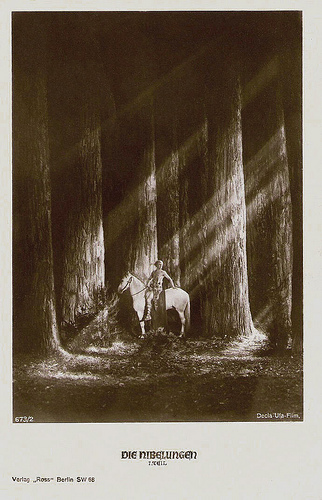
German postcard by Ross Verlag, Berlin, no. 673/2, 1919-1924. Photo: Decla-Ufa-Film. Siegfried ( Paul Richter ) in the forest in Die Nibelungen: Siegfried (Fritz Lang, 1924).
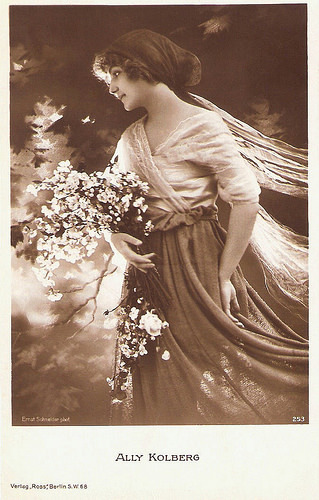
German postcard by Ross Verlag, Berlin, no. 253, 1919-1924. Photo: Ernst Schneider. Ally Kolberg .
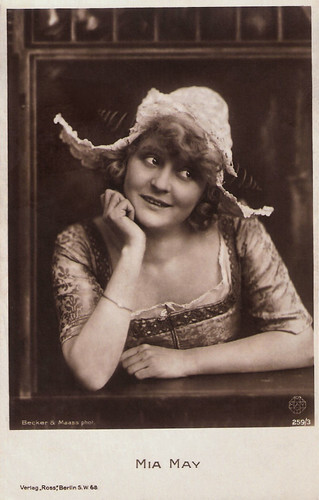
German postcard by Ross Verlag, Berlin, no. 259/3, 1919-1921. Sent by mail in Germany in 1921. Photo: Becker & Maass / May Film. Mia May .
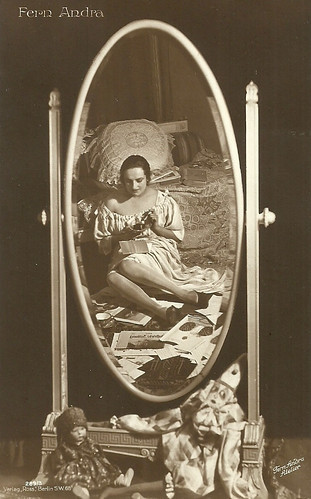
German postcard by Ross Verlag, no. 289/3. Photo: Fern Andra Atelier. Although most Ross postcards have a white border around the photos, some have no border or a much narrower one. Fern Andra .
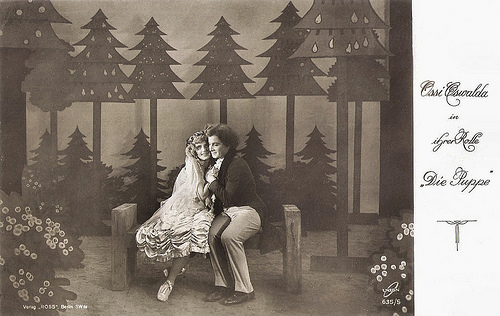
German postcard by Ross Verlag, Berlin, no. 635/5, 1919-1924. Photo: Union. Publicity still for Die Puppe/The Doll (Ernst Lubitsch, 1919) with Ossi Oswalda and Hermann Thimig .
Heinrich Ross
The founder of Ross Verlag, Heinrich Ross, was born in 1870 in Rokytno, Austria-Hungary, now a part of the Czech Republic. Sometime around 1905-1907, he began to work at the Rotophot postcard publishing company in Berlin. Rotophot had started around the turn of the century (1900) and had other offices throughout Europe, including London and Budapest.
In 1919, Heinrich founded the postcard company that bore his name, Ross Verlag. Originally, Ross operated as a distributor of postcards, but soon also became a publisher (Verlag). After Adolph Hitler came into power in 1933, the persecution of the Jews in Germany began. By 1937, Ross Verlag was no longer in its Jewish founder's control. Heinrich Ross was forced out by the National Socialists through their Arisierung (Aryanisation) program: no Jew could own a business. Interestingly enough, they retained the Ross Verlag name until 1941. Heinrich Ross boarded the passenger ship the S.S. St. Louis in Hamburg, Germany on 13 May 1939. The ship was bound for Cuba with 937 passengers, most of them German Jews. When they arrived at their destination, the Cuban government refused to allow the passengers to disembark. After many unsuccessful attempts, they next tried to dock in the USA. The United States government also refused them entry into the country. Both countries had immigration quotas that had already been filled. Having nowhere else to go, the S.S. St. Louis and its passengers were forced to head back to Europe. Decades later, a film was made about this dark and tragic chapter in history, The Voyage of the Damned (Stuart Rosenberg, 1976).
Heinrich Ross was allowed passage to England as a refugee. Heinrich spent three years in England, but in 1942 he boarded the passenger ship the S.S. Pacific Enterprise and crossed the Atlantic to America. He could join his family in New York. Heinrich had lost his fortune through Nazi confiscation, paying a 'flight tax' to leave, as well as the payment of his ship's passage.
Reportedly, at the age of 73, Heinrich Ross started working again in a machine shop in Chicago, up to the age of 84. In 1956, he and his son received compensation from Germany for the loss of their Berlin company in the amount of 50,000 Deutsche Marks. In 1957, at the age of 86, Heinrich Ross passed away at the Michael Reese Hospital in Chicago, Illinois from a stroke and pneumonia.
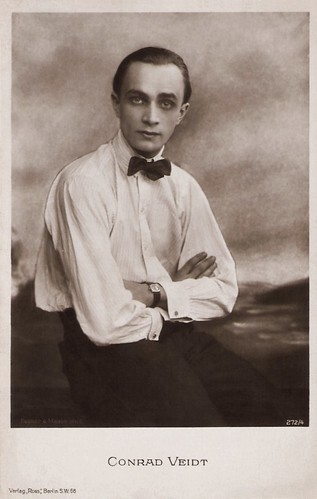
German postcard by Ross Verlag, Berlin, no. 272/4, 1919-1924. Photo: Becker & Maass. Conrad Veidt .
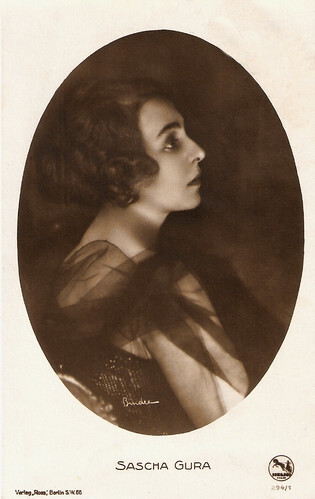
German postcard by Ross Verlag, Berlin, no. 294/1. Photo: Alex Binder/Decla. Sascha Gura .
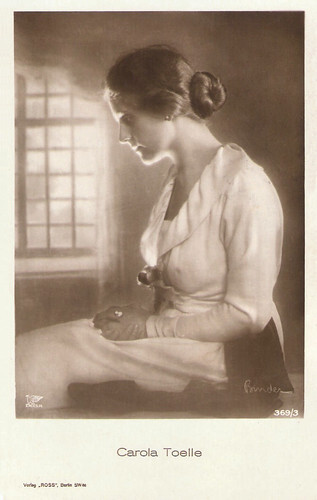
German postcard by Ross Verlag, Berlin, no. 369/3, 1919-1924. Photo: Alex Binder / Decla. Carola Toelle .
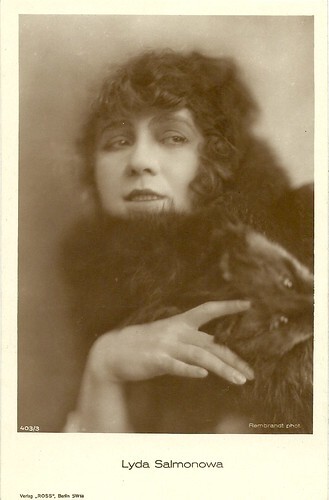
German postcard by Ross Verlag, Berlin, no. 403/3, 1919-1924. Photo: Rembrandt phot. Collection: Didier Hanson. Lyda Salmonova .
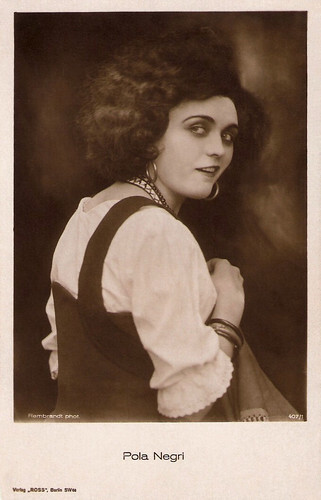
German postcard by Ross Verlag, Berlin, no. 407/1, 1919-1924. Photo: Rembrandt Phot. Pola Negri .
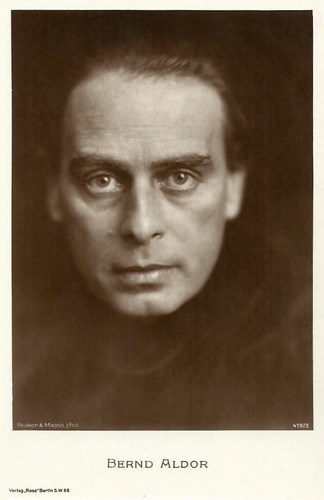
German postcard by Ross Verlag, Berlin, no. 419/3, 1919-1924. Photo: Becker & Maass, Berlin. Bernd Aldor .
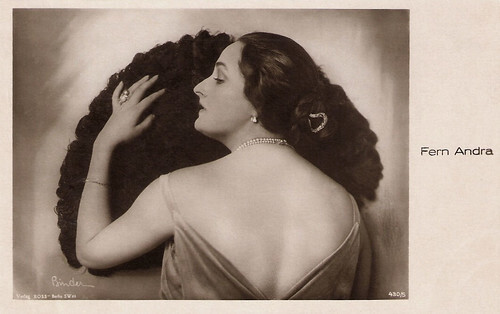
German postcard by Ross Verlag, Berlin, no. 430/5, 1919-1924. Photo: Alex Binder. Fern Andra .
Ross Verlag
The familiar Ross Verlag logo first appeared in the early 1920s. On the front of the card were the words: Verlag "Ross" Berlin SW68. SW stands for Southwest and 68 is an area code in that region of Berlin. Mark Goffee: "Ross Verlag printed real photo postcards of the highest quality, among the finest ever published of movie stars. The company licensed thousands of images from the Hollywood studios; some of those photos may have only been distributed on these postcards. In Germany, movie stars were photographed by the best European glamour studios. Quite possibly, many of these photos were taken just for publication through Ross Verlag."
The majority of the Ross Verlag cards are numbered and the numbers went up to 9997/1 and then started over again with the letter 'A'. These cards began at A 1000 and continue to around A 4096. The A numbers were issued from 1941 to 1944. During the Second World War, the Nazi publishers also started to use the name Film-Foto-Verlag .
The numbering system includes a series number, then a slash followed by a card number (for example 3112/2). The card numbers of a specific series would be of one particular actress or group of actors or a film (for example, 1028/1, 1028/2, 1028/3 and 1028/4 all show actress Lya de Putti ).
Usually, a set of cards of one or more actors would be from the same film (although not always) or photographer. Around card number 1930/1 (in the year 1928), the Verlag "Ross" Berlin SW68 on the cards changed to simply "Ross" Verlag.
Ross Verlag seemed to disappear by the end of the war, but the Film-Foto-Verlag name did reappear in the early to mid-1950s for a short while. It soon changed to UFA/Film-Foto. Whether this company had any links to the original Ross is unknown.
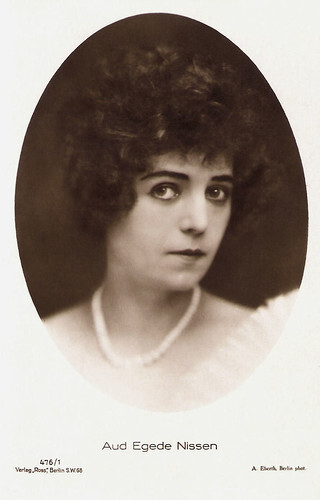
German postcard by Ross Verlag, Berlin, no. 476/1, 1919-1924. Photo: A. Eberth, Berlin. Aud Egede-Nissen .
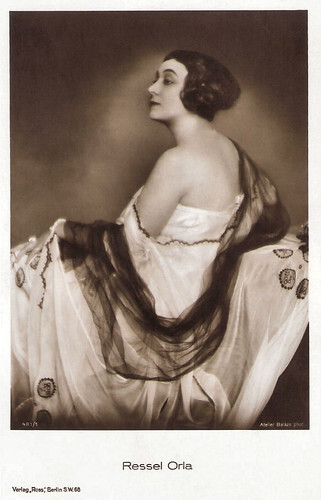
German postcard by Ross Verlag, Berlin, no. 481/1, 1919-1924. Photo: Atelier Balázs. Ressel Orla .
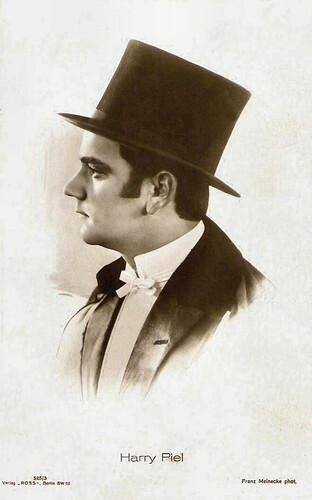
German postcard by Ross Verlag, Berlin, no. 525/3, 1919-1924. Photo: Franz Meinecke, Berlin. Harry Piel .
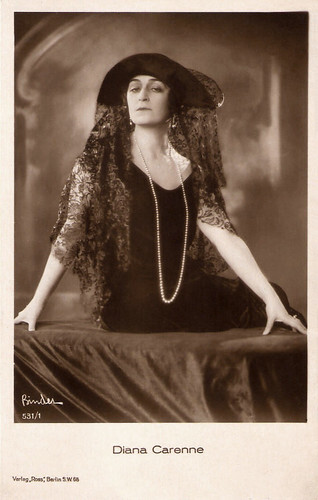
German Postcard by Ross Verlag, Berlin, no. 531/1, 1919-1924. Photo: Alex Binder. Diana Karenne .
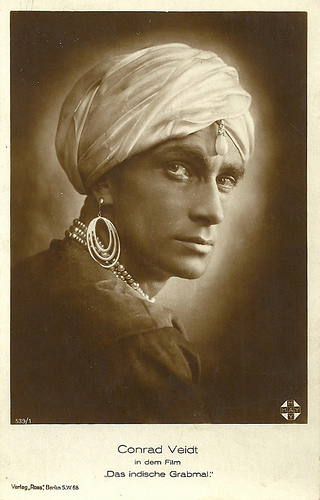
German postcard by Ross Verlag, no. 539/1. Photo: May Film. Conrad Veidt was the proud and cruel Maharajah of Eschnapur in the two-part monumental film Das indische Grabmal/The Indian Tomb (Joe May, 1921-1922).
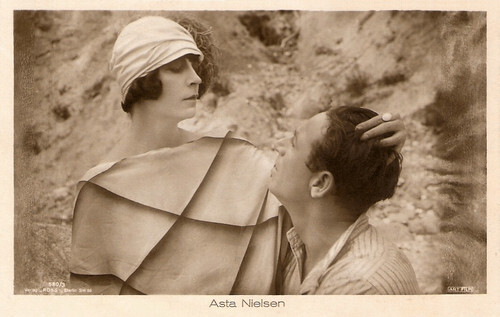
German postcard by Ross Verlag, no. 580/3, 1919-1924. Photo: Art Film. Asta Nielsen and Gregori Chmara in Der Absturz/Downfall (Ludwig Wolff, 1923).
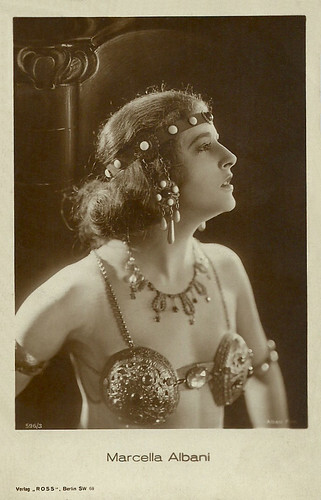
German postcard by Ross Verlag, no. 596/3, 1925-1926. Photo: Albani Film. Collection: Didier Hanson. Marcella Albani .
Mark Goffee and Jean Ritsema
On Ross Verlag Movie Star Postcards , Mark Goffee tells the company's history, and he created checklists of the Ross postcards. Since 2016, Jean Ritsema created and maintained a very useful image archive.
For EFSP, we use these lists and archives quite often, e.g. for the dating of our Ross postcards. But there is much more to discover on this wonderful site.
Goffee presents many postcards from his own collection, and he gives a lot of facts and feats. There are for example heart shaped photos on certain Ross cards, and opera stars appeared on Ross cards in roles they were famous for.
The website also presents bloopers: a few mistakes that were made on the cards, and it shows that some cards were actually drawings.
Goffee and Ritsema offer on their website many interesting links. Check it out. Next week at EFSP, we present 25 of our favourite Ross Verlag postcards with Hollywood stars of the 1920s.
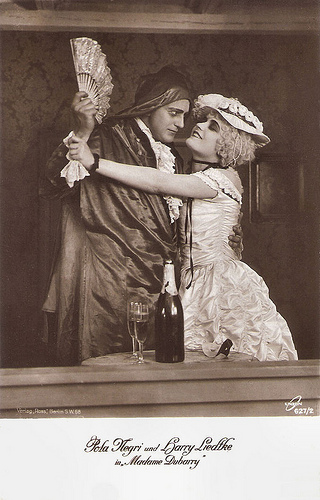
German postcard by Ross Verlag, Berlin, no. 627/2, 1919-1924. Photo: Union. Publicity still for Madame DuBarry (Ernst Lubitsch, 1919) with Pola Negri and Harry Liedtke .
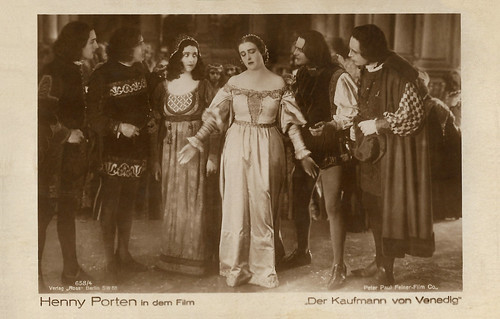
German postcard by Ross Verlag, no. 658/4. Photo: Peter Paul Felner-Film Co. Publicity still for Der Kaufmann von Venedig/The Merchant of Venice (Peter Paul Felner, 1923) with Henny Porten .
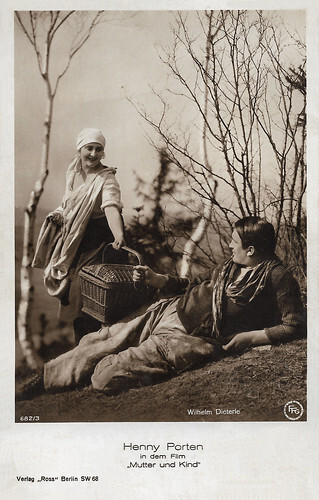
German postcard by Ross Verlag, no. 682/3. Photo: FFG (Froehlich-Flm GmbH). Henny Porten in Mutter und Kind/Mother and Child (Carl Froehlich, 1924), co-starring Wilhelm (later William) Dieterle .
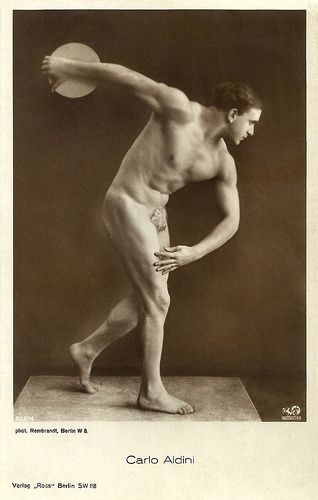
German postcard by Ross Verlag, no. 858/4. Photo: Phoebus Film / Rembrandt. Italian actor Carlo Aldini imitates Myron's discus thrower.
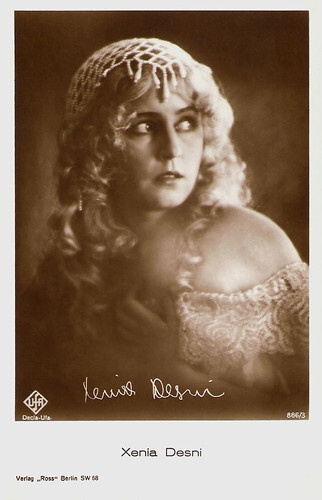
German postcard by Ross Verlag, no. 886/3, 1925-1926. Photo: Decla / Ufa. Xenia Desni.
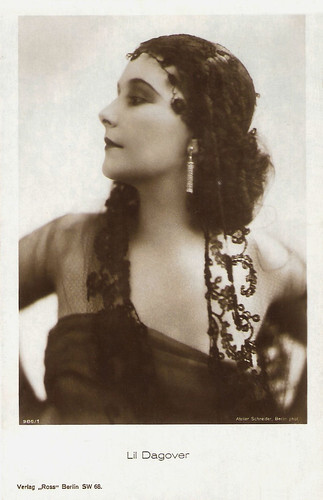
German postcard by Ross Verlag, Berlin, no. 905/1, 1925-1926. Photo: Atelier Schneider, Berlin. Lil Dagover .
Sources: Mark Goffee and Jean Ritsema (Ross Verlag Movie Star Postcards), Luminous Lint and Wikipedia (German).
The Ross Verlag Tribute is to be continued weekly.

German postcard by Ross Verlag, Berlin, no. 673/2, 1919-1924. Photo: Decla-Ufa-Film. Siegfried ( Paul Richter ) in the forest in Die Nibelungen: Siegfried (Fritz Lang, 1924).

German postcard by Ross Verlag, Berlin, no. 253, 1919-1924. Photo: Ernst Schneider. Ally Kolberg .

German postcard by Ross Verlag, Berlin, no. 259/3, 1919-1921. Sent by mail in Germany in 1921. Photo: Becker & Maass / May Film. Mia May .

German postcard by Ross Verlag, no. 289/3. Photo: Fern Andra Atelier. Although most Ross postcards have a white border around the photos, some have no border or a much narrower one. Fern Andra .

German postcard by Ross Verlag, Berlin, no. 635/5, 1919-1924. Photo: Union. Publicity still for Die Puppe/The Doll (Ernst Lubitsch, 1919) with Ossi Oswalda and Hermann Thimig .
Heinrich Ross
The founder of Ross Verlag, Heinrich Ross, was born in 1870 in Rokytno, Austria-Hungary, now a part of the Czech Republic. Sometime around 1905-1907, he began to work at the Rotophot postcard publishing company in Berlin. Rotophot had started around the turn of the century (1900) and had other offices throughout Europe, including London and Budapest.
In 1919, Heinrich founded the postcard company that bore his name, Ross Verlag. Originally, Ross operated as a distributor of postcards, but soon also became a publisher (Verlag). After Adolph Hitler came into power in 1933, the persecution of the Jews in Germany began. By 1937, Ross Verlag was no longer in its Jewish founder's control. Heinrich Ross was forced out by the National Socialists through their Arisierung (Aryanisation) program: no Jew could own a business. Interestingly enough, they retained the Ross Verlag name until 1941. Heinrich Ross boarded the passenger ship the S.S. St. Louis in Hamburg, Germany on 13 May 1939. The ship was bound for Cuba with 937 passengers, most of them German Jews. When they arrived at their destination, the Cuban government refused to allow the passengers to disembark. After many unsuccessful attempts, they next tried to dock in the USA. The United States government also refused them entry into the country. Both countries had immigration quotas that had already been filled. Having nowhere else to go, the S.S. St. Louis and its passengers were forced to head back to Europe. Decades later, a film was made about this dark and tragic chapter in history, The Voyage of the Damned (Stuart Rosenberg, 1976).
Heinrich Ross was allowed passage to England as a refugee. Heinrich spent three years in England, but in 1942 he boarded the passenger ship the S.S. Pacific Enterprise and crossed the Atlantic to America. He could join his family in New York. Heinrich had lost his fortune through Nazi confiscation, paying a 'flight tax' to leave, as well as the payment of his ship's passage.
Reportedly, at the age of 73, Heinrich Ross started working again in a machine shop in Chicago, up to the age of 84. In 1956, he and his son received compensation from Germany for the loss of their Berlin company in the amount of 50,000 Deutsche Marks. In 1957, at the age of 86, Heinrich Ross passed away at the Michael Reese Hospital in Chicago, Illinois from a stroke and pneumonia.

German postcard by Ross Verlag, Berlin, no. 272/4, 1919-1924. Photo: Becker & Maass. Conrad Veidt .

German postcard by Ross Verlag, Berlin, no. 294/1. Photo: Alex Binder/Decla. Sascha Gura .

German postcard by Ross Verlag, Berlin, no. 369/3, 1919-1924. Photo: Alex Binder / Decla. Carola Toelle .

German postcard by Ross Verlag, Berlin, no. 403/3, 1919-1924. Photo: Rembrandt phot. Collection: Didier Hanson. Lyda Salmonova .

German postcard by Ross Verlag, Berlin, no. 407/1, 1919-1924. Photo: Rembrandt Phot. Pola Negri .

German postcard by Ross Verlag, Berlin, no. 419/3, 1919-1924. Photo: Becker & Maass, Berlin. Bernd Aldor .

German postcard by Ross Verlag, Berlin, no. 430/5, 1919-1924. Photo: Alex Binder. Fern Andra .
Ross Verlag
The familiar Ross Verlag logo first appeared in the early 1920s. On the front of the card were the words: Verlag "Ross" Berlin SW68. SW stands for Southwest and 68 is an area code in that region of Berlin. Mark Goffee: "Ross Verlag printed real photo postcards of the highest quality, among the finest ever published of movie stars. The company licensed thousands of images from the Hollywood studios; some of those photos may have only been distributed on these postcards. In Germany, movie stars were photographed by the best European glamour studios. Quite possibly, many of these photos were taken just for publication through Ross Verlag."
The majority of the Ross Verlag cards are numbered and the numbers went up to 9997/1 and then started over again with the letter 'A'. These cards began at A 1000 and continue to around A 4096. The A numbers were issued from 1941 to 1944. During the Second World War, the Nazi publishers also started to use the name Film-Foto-Verlag .
The numbering system includes a series number, then a slash followed by a card number (for example 3112/2). The card numbers of a specific series would be of one particular actress or group of actors or a film (for example, 1028/1, 1028/2, 1028/3 and 1028/4 all show actress Lya de Putti ).
Usually, a set of cards of one or more actors would be from the same film (although not always) or photographer. Around card number 1930/1 (in the year 1928), the Verlag "Ross" Berlin SW68 on the cards changed to simply "Ross" Verlag.
Ross Verlag seemed to disappear by the end of the war, but the Film-Foto-Verlag name did reappear in the early to mid-1950s for a short while. It soon changed to UFA/Film-Foto. Whether this company had any links to the original Ross is unknown.

German postcard by Ross Verlag, Berlin, no. 476/1, 1919-1924. Photo: A. Eberth, Berlin. Aud Egede-Nissen .

German postcard by Ross Verlag, Berlin, no. 481/1, 1919-1924. Photo: Atelier Balázs. Ressel Orla .

German postcard by Ross Verlag, Berlin, no. 525/3, 1919-1924. Photo: Franz Meinecke, Berlin. Harry Piel .

German Postcard by Ross Verlag, Berlin, no. 531/1, 1919-1924. Photo: Alex Binder. Diana Karenne .

German postcard by Ross Verlag, no. 539/1. Photo: May Film. Conrad Veidt was the proud and cruel Maharajah of Eschnapur in the two-part monumental film Das indische Grabmal/The Indian Tomb (Joe May, 1921-1922).

German postcard by Ross Verlag, no. 580/3, 1919-1924. Photo: Art Film. Asta Nielsen and Gregori Chmara in Der Absturz/Downfall (Ludwig Wolff, 1923).

German postcard by Ross Verlag, no. 596/3, 1925-1926. Photo: Albani Film. Collection: Didier Hanson. Marcella Albani .
Mark Goffee and Jean Ritsema
On Ross Verlag Movie Star Postcards , Mark Goffee tells the company's history, and he created checklists of the Ross postcards. Since 2016, Jean Ritsema created and maintained a very useful image archive.
For EFSP, we use these lists and archives quite often, e.g. for the dating of our Ross postcards. But there is much more to discover on this wonderful site.
Goffee presents many postcards from his own collection, and he gives a lot of facts and feats. There are for example heart shaped photos on certain Ross cards, and opera stars appeared on Ross cards in roles they were famous for.
The website also presents bloopers: a few mistakes that were made on the cards, and it shows that some cards were actually drawings.
Goffee and Ritsema offer on their website many interesting links. Check it out. Next week at EFSP, we present 25 of our favourite Ross Verlag postcards with Hollywood stars of the 1920s.

German postcard by Ross Verlag, Berlin, no. 627/2, 1919-1924. Photo: Union. Publicity still for Madame DuBarry (Ernst Lubitsch, 1919) with Pola Negri and Harry Liedtke .

German postcard by Ross Verlag, no. 658/4. Photo: Peter Paul Felner-Film Co. Publicity still for Der Kaufmann von Venedig/The Merchant of Venice (Peter Paul Felner, 1923) with Henny Porten .

German postcard by Ross Verlag, no. 682/3. Photo: FFG (Froehlich-Flm GmbH). Henny Porten in Mutter und Kind/Mother and Child (Carl Froehlich, 1924), co-starring Wilhelm (later William) Dieterle .

German postcard by Ross Verlag, no. 858/4. Photo: Phoebus Film / Rembrandt. Italian actor Carlo Aldini imitates Myron's discus thrower.

German postcard by Ross Verlag, no. 886/3, 1925-1926. Photo: Decla / Ufa. Xenia Desni.

German postcard by Ross Verlag, Berlin, no. 905/1, 1925-1926. Photo: Atelier Schneider, Berlin. Lil Dagover .
Sources: Mark Goffee and Jean Ritsema (Ross Verlag Movie Star Postcards), Luminous Lint and Wikipedia (German).
The Ross Verlag Tribute is to be continued weekly.
Published on September 03, 2024 22:00
September 2, 2024
Harald Paulsen
Fast-talking German actor Harald Paulsen (1895-1954) appeared in 125 films between 1920 and 1954, including Robert Wiene's Genuine (1920) and Alraune (1930) with Brigitte Helm. He was on stage from 1913 and an ensemble member of Max Reinhardt's Deutsche Theater in the 1920s. Paulsen also played Mack the Knife in the original cast of 'Die Dreigroschenoper' (The Threepenny Opera) written by Kurt Weill and Bertolt Brecht. The show's opening number, 'Mack the Knife', became the most popular song of its time.
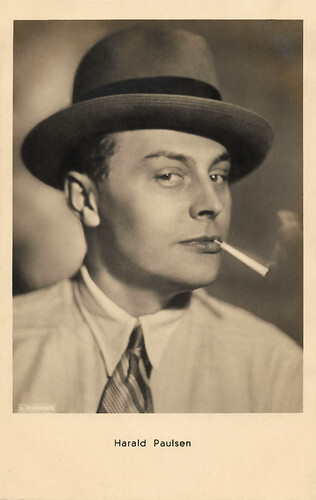
Austrian postcard by Iris Verlag, no. 6509. Photo: Von Gudenberg. Sent by mail in 1935.
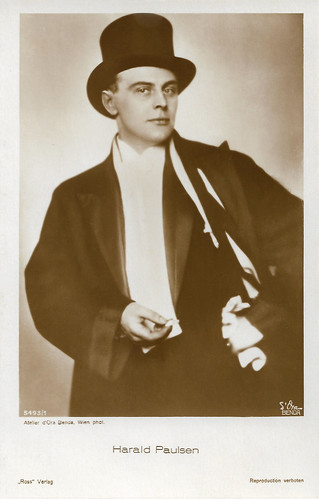
German postcard by Ross Verlag, no. 5493/1, 1930-1931. Photo: Atelier d'Ora / Benda, Wien.
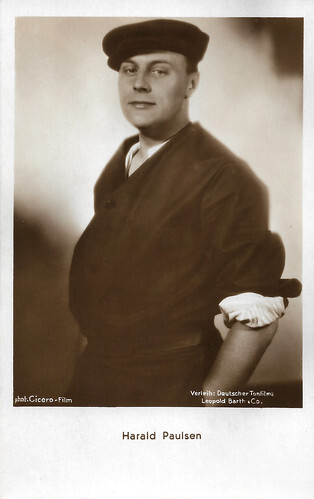
Austrian postcard by Iris Verlag. Photo: Cicero Film / Deutscher Tonfilm / Leopold Barth & Co. Perhaps a card for Eine Stunde Glück/One Hour Of Happiness (Wilhelm Dieterle, 1931), in which Paulsen played one of two engineers working the night shift at a department store who pretends to give gifts from the store to a poor girl (Evelyn Holt).
Mack the Knife
Harald Johannes David Paulsen was born in Elmshorn in the German Empire, in 1895. He first appeared on stage at age sixteen but was unable to make a living from it and earned extra money as a musician in a band. He then studied under Leopold Jessner, who was then senior director at Hamburg's Thalia Theater.
Paulsen made his debut at the Hamburg Stadttheater in 1913. From 1915 until 1917, he served in the German Army during World War I and in 1917–1918 he played at the Fronttheater in Mitau. After the end of the war, he initially toured the Ruhr and Westphalia with a touring company. In 1919 he was brought to the Deutsches Theater in Berlin by legendary stage director Max Reinhardt .
There, Paulsen quickly made a name for himself as a renowned actor and began studying singing in 1922, which made him versatile. In addition to acting, he now also appeared in operas, operettas and revues. He often acted as a bon vivant, comedian, couplets singer and dancer. He usually wrote his songs and thought-provoking poems shortly before performing. From his extensive theatrical work, his role as Mackie Messer (Mack the Knife) in the world premiere of Bertolt Brecht's 'The Threepenny Opera' is particularly noteworthy. This performance took place on 31 August 1928 at the Theater am Schiffbauerdamm. At that time, Paulsen was considered a Brecht admirer.
Paulsen also appeared in several silent films. Robert Wiene directed him in the historical drama Die Nacht der Königin Isabeau/The Night of Queen Isabeau (Robert Wiene, 1920) starring Fern Andra and Fritz Kortner , and the expressionist Horror fantasy Genuine (Robert Wiene, 1920) starring Fern Andra as an ancient and cruel divinity, who seduces men and induce them to kill as a proof of love. Paulsen co-starred in Das Mädel aus der Hölle/The Girl from Hell (Friedrich Zelnik, 1923) opposite Lya Mara and Carl Auen . He also had a major role in the Henny Porten vehicle Das Abenteuer der Sibylle Brant/The Adventures of Sybil Brent (Carl Froelich, 1925).
Harald Paulsen's acting career continued into the sound film era. Probably his best-known sound film is the Science Fiction Horror film Alraune (Richard Oswald, 1930). Like the silent 1928 version, the film again featured Brigitte Helm in the role of Alraune. He also appeared in Oswald's Horror comedy Unheimliche Geschichten/The Living Dead (Richard Oswald, 1932) starring Paul Wegener . Georg Jacoby directed him in the crime thriller Der große Bluff/The Big Bluff (Georg Jacoby, 1932) and Der kühne Schwimmer/The Daring Swimmer (Georg Jacoby, 1934), starring Ralph Arthur Roberts .
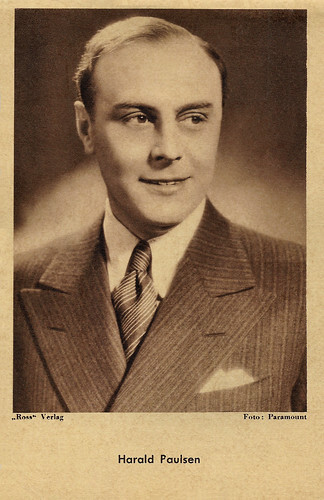
German postcard for Das Programm von Heute by Ross Verlag. Photo: Paramount. Publicity still for Der große Bluff/The Big Bluff (Georg Jacoby, 1933).
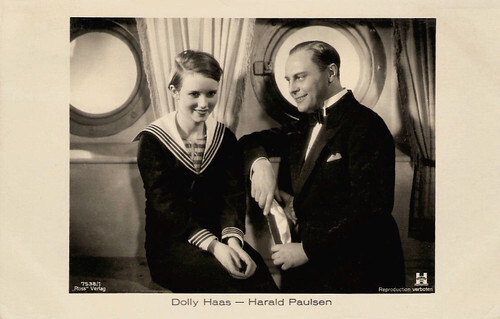
German postcard by Ross Verlag, no. 7538/1, 1932-1933. Photo: Hisa-Film-Vertrieb GmbH. Dolly Haas and Harald Paulsen in Die Kleine Schwindlerin/The Little Crook (Johannes Meyer, 1933).
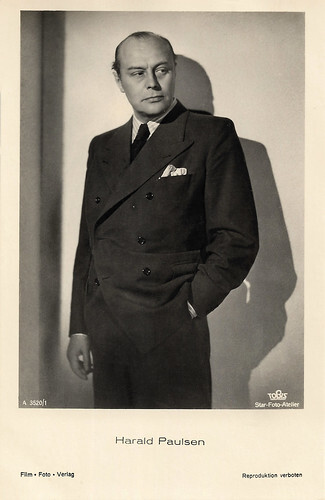
German postcard by Film-Foto-Verlag, no. A 3520/1, 1941-1944. Photo: Star-Foto-Atelier / Tobis.
A fervent National Socialist
Shortly after Adolf Hitler seized power, Harald Paulsen became a fervent National Socialist and carried the Flag of Nazi Germany for the student representatives at the May Day rally in Tempelhof. In 1938, Paulsen became director of the Theater am Nollendorfplatz in Berlin, where mainly operettas were performed at that time. He also directed and performed in singing roles.
Paulsen appeared in approximately ninety sound films, mainly mediocre comedies and operettas. He also played roles such as Imre Berczy in the melodrama Stradivari (Géza von Bolváry, 1935), Fritz Niemeyer in the drama Traumulus/The Dreamer (Carl Froelich, 1936) and the singing teacher Enrico Falotti in the comedy Wenn wir alle Engel wären/If We All Were Angels (Carl Froelich, 1936) alongside Heinz Rühmann .
In Eskapade/Escapade (Erich Waschneck, 1936), he was seen with Renate Müller and Georg Alexander . Paulsen appeared as lawyer Hanefeld together with protagonist Emil Jannings in Veit Harlan 's Nazi propaganda film Der Herrscher/The Ruler (Veit Harlan, 1937), which is still one of the reserved films today. He also appeared in the crime thriller Mordsache Holm/Murder Case Holm (Erich Engels, 1938) as Detective Wiegand.
Harald Paulsen participated in several Nazi propaganda films, such as the biopic Ohm Krüger/Uncle Krüger (Hans Steinhoff, 1941) starring Emil Jannings as the South African politician Paul Kruger and the pro-euthanasia melodrama Ich klage an/I Accuse (Wolfgang Liebeneiner, 1941). The Viennese actor Rolf Kutschera reported in his memoirs that Paulsen was notorious among his colleagues as an informant to Nazi authorities. Following the End of World War II in Europe, Paulsen was forced to resign from his position as director of the Theater am Nollendorfplatz in 1945.
Paulsen made his last screen appearance in 1954 as Count Carnero in the operetta adaptation Der Zigeunerbaron/The Gypsy Baron (Arthur Maria Rabenalt, 1954) starring Paul Hörbiger . He had appeared in around 125 films and was one of the busiest German actors of those years. Harald Paulsen died in 1954, aged 58, in the general hospital in the Hamburg borough of Altona after suffering from a stroke. He was buried in the Catholic cemetery in Elmshorn. He was married to Hilla Höfer. Their son Uwe Paulsen (1944–2014) was a stage and film actor, cabaret artist, and prolific voice actor, who dubbed foreign language film and television into German.
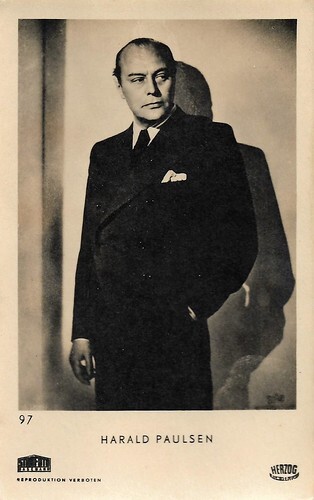
West German postcard by Star Foto Hasemann, no. 97. Photo: Herzog Film-Verleih.
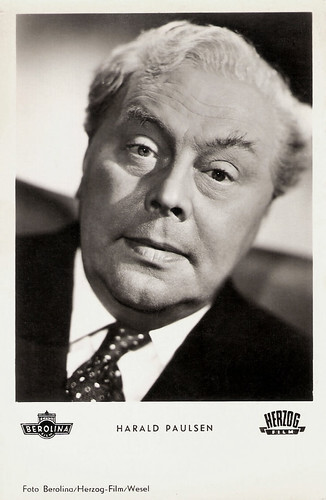
West-German postcard by Kunst und Bild, Berlin, no. A 923. Photo: Berolina / Herzog-Film / Wesel. Harald Paulsen in Briefträger Müller/Mailman Mueller (John Reinhardt, 1953).
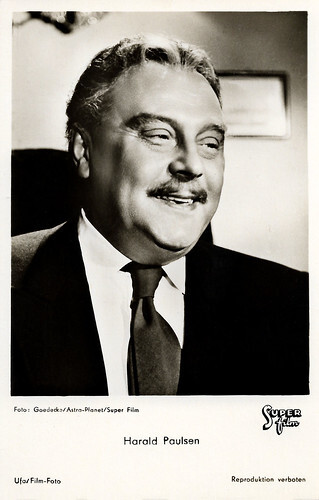
West-German postcard by Ufa/Film-Foto, Berlin, no. A 923. Photo: Goedecke / Astra-Planet / Super-Film. Harald Paulsen in Sanatorium total verrückt/Sanatorium totally crazy (Alwin Elling, 1954).
Sources: Stephanie D'heil (Steffi-Line - German), Wikipedia (German and English) and .

Austrian postcard by Iris Verlag, no. 6509. Photo: Von Gudenberg. Sent by mail in 1935.

German postcard by Ross Verlag, no. 5493/1, 1930-1931. Photo: Atelier d'Ora / Benda, Wien.

Austrian postcard by Iris Verlag. Photo: Cicero Film / Deutscher Tonfilm / Leopold Barth & Co. Perhaps a card for Eine Stunde Glück/One Hour Of Happiness (Wilhelm Dieterle, 1931), in which Paulsen played one of two engineers working the night shift at a department store who pretends to give gifts from the store to a poor girl (Evelyn Holt).
Mack the Knife
Harald Johannes David Paulsen was born in Elmshorn in the German Empire, in 1895. He first appeared on stage at age sixteen but was unable to make a living from it and earned extra money as a musician in a band. He then studied under Leopold Jessner, who was then senior director at Hamburg's Thalia Theater.
Paulsen made his debut at the Hamburg Stadttheater in 1913. From 1915 until 1917, he served in the German Army during World War I and in 1917–1918 he played at the Fronttheater in Mitau. After the end of the war, he initially toured the Ruhr and Westphalia with a touring company. In 1919 he was brought to the Deutsches Theater in Berlin by legendary stage director Max Reinhardt .
There, Paulsen quickly made a name for himself as a renowned actor and began studying singing in 1922, which made him versatile. In addition to acting, he now also appeared in operas, operettas and revues. He often acted as a bon vivant, comedian, couplets singer and dancer. He usually wrote his songs and thought-provoking poems shortly before performing. From his extensive theatrical work, his role as Mackie Messer (Mack the Knife) in the world premiere of Bertolt Brecht's 'The Threepenny Opera' is particularly noteworthy. This performance took place on 31 August 1928 at the Theater am Schiffbauerdamm. At that time, Paulsen was considered a Brecht admirer.
Paulsen also appeared in several silent films. Robert Wiene directed him in the historical drama Die Nacht der Königin Isabeau/The Night of Queen Isabeau (Robert Wiene, 1920) starring Fern Andra and Fritz Kortner , and the expressionist Horror fantasy Genuine (Robert Wiene, 1920) starring Fern Andra as an ancient and cruel divinity, who seduces men and induce them to kill as a proof of love. Paulsen co-starred in Das Mädel aus der Hölle/The Girl from Hell (Friedrich Zelnik, 1923) opposite Lya Mara and Carl Auen . He also had a major role in the Henny Porten vehicle Das Abenteuer der Sibylle Brant/The Adventures of Sybil Brent (Carl Froelich, 1925).
Harald Paulsen's acting career continued into the sound film era. Probably his best-known sound film is the Science Fiction Horror film Alraune (Richard Oswald, 1930). Like the silent 1928 version, the film again featured Brigitte Helm in the role of Alraune. He also appeared in Oswald's Horror comedy Unheimliche Geschichten/The Living Dead (Richard Oswald, 1932) starring Paul Wegener . Georg Jacoby directed him in the crime thriller Der große Bluff/The Big Bluff (Georg Jacoby, 1932) and Der kühne Schwimmer/The Daring Swimmer (Georg Jacoby, 1934), starring Ralph Arthur Roberts .

German postcard for Das Programm von Heute by Ross Verlag. Photo: Paramount. Publicity still for Der große Bluff/The Big Bluff (Georg Jacoby, 1933).

German postcard by Ross Verlag, no. 7538/1, 1932-1933. Photo: Hisa-Film-Vertrieb GmbH. Dolly Haas and Harald Paulsen in Die Kleine Schwindlerin/The Little Crook (Johannes Meyer, 1933).

German postcard by Film-Foto-Verlag, no. A 3520/1, 1941-1944. Photo: Star-Foto-Atelier / Tobis.
A fervent National Socialist
Shortly after Adolf Hitler seized power, Harald Paulsen became a fervent National Socialist and carried the Flag of Nazi Germany for the student representatives at the May Day rally in Tempelhof. In 1938, Paulsen became director of the Theater am Nollendorfplatz in Berlin, where mainly operettas were performed at that time. He also directed and performed in singing roles.
Paulsen appeared in approximately ninety sound films, mainly mediocre comedies and operettas. He also played roles such as Imre Berczy in the melodrama Stradivari (Géza von Bolváry, 1935), Fritz Niemeyer in the drama Traumulus/The Dreamer (Carl Froelich, 1936) and the singing teacher Enrico Falotti in the comedy Wenn wir alle Engel wären/If We All Were Angels (Carl Froelich, 1936) alongside Heinz Rühmann .
In Eskapade/Escapade (Erich Waschneck, 1936), he was seen with Renate Müller and Georg Alexander . Paulsen appeared as lawyer Hanefeld together with protagonist Emil Jannings in Veit Harlan 's Nazi propaganda film Der Herrscher/The Ruler (Veit Harlan, 1937), which is still one of the reserved films today. He also appeared in the crime thriller Mordsache Holm/Murder Case Holm (Erich Engels, 1938) as Detective Wiegand.
Harald Paulsen participated in several Nazi propaganda films, such as the biopic Ohm Krüger/Uncle Krüger (Hans Steinhoff, 1941) starring Emil Jannings as the South African politician Paul Kruger and the pro-euthanasia melodrama Ich klage an/I Accuse (Wolfgang Liebeneiner, 1941). The Viennese actor Rolf Kutschera reported in his memoirs that Paulsen was notorious among his colleagues as an informant to Nazi authorities. Following the End of World War II in Europe, Paulsen was forced to resign from his position as director of the Theater am Nollendorfplatz in 1945.
Paulsen made his last screen appearance in 1954 as Count Carnero in the operetta adaptation Der Zigeunerbaron/The Gypsy Baron (Arthur Maria Rabenalt, 1954) starring Paul Hörbiger . He had appeared in around 125 films and was one of the busiest German actors of those years. Harald Paulsen died in 1954, aged 58, in the general hospital in the Hamburg borough of Altona after suffering from a stroke. He was buried in the Catholic cemetery in Elmshorn. He was married to Hilla Höfer. Their son Uwe Paulsen (1944–2014) was a stage and film actor, cabaret artist, and prolific voice actor, who dubbed foreign language film and television into German.

West German postcard by Star Foto Hasemann, no. 97. Photo: Herzog Film-Verleih.

West-German postcard by Kunst und Bild, Berlin, no. A 923. Photo: Berolina / Herzog-Film / Wesel. Harald Paulsen in Briefträger Müller/Mailman Mueller (John Reinhardt, 1953).

West-German postcard by Ufa/Film-Foto, Berlin, no. A 923. Photo: Goedecke / Astra-Planet / Super-Film. Harald Paulsen in Sanatorium total verrückt/Sanatorium totally crazy (Alwin Elling, 1954).
Sources: Stephanie D'heil (Steffi-Line - German), Wikipedia (German and English) and .
Published on September 02, 2024 22:00
Paul van Yperen's Blog
- Paul van Yperen's profile
- 13 followers
Paul van Yperen isn't a Goodreads Author
(yet),
but they
do have a blog,
so here are some recent posts imported from
their feed.



